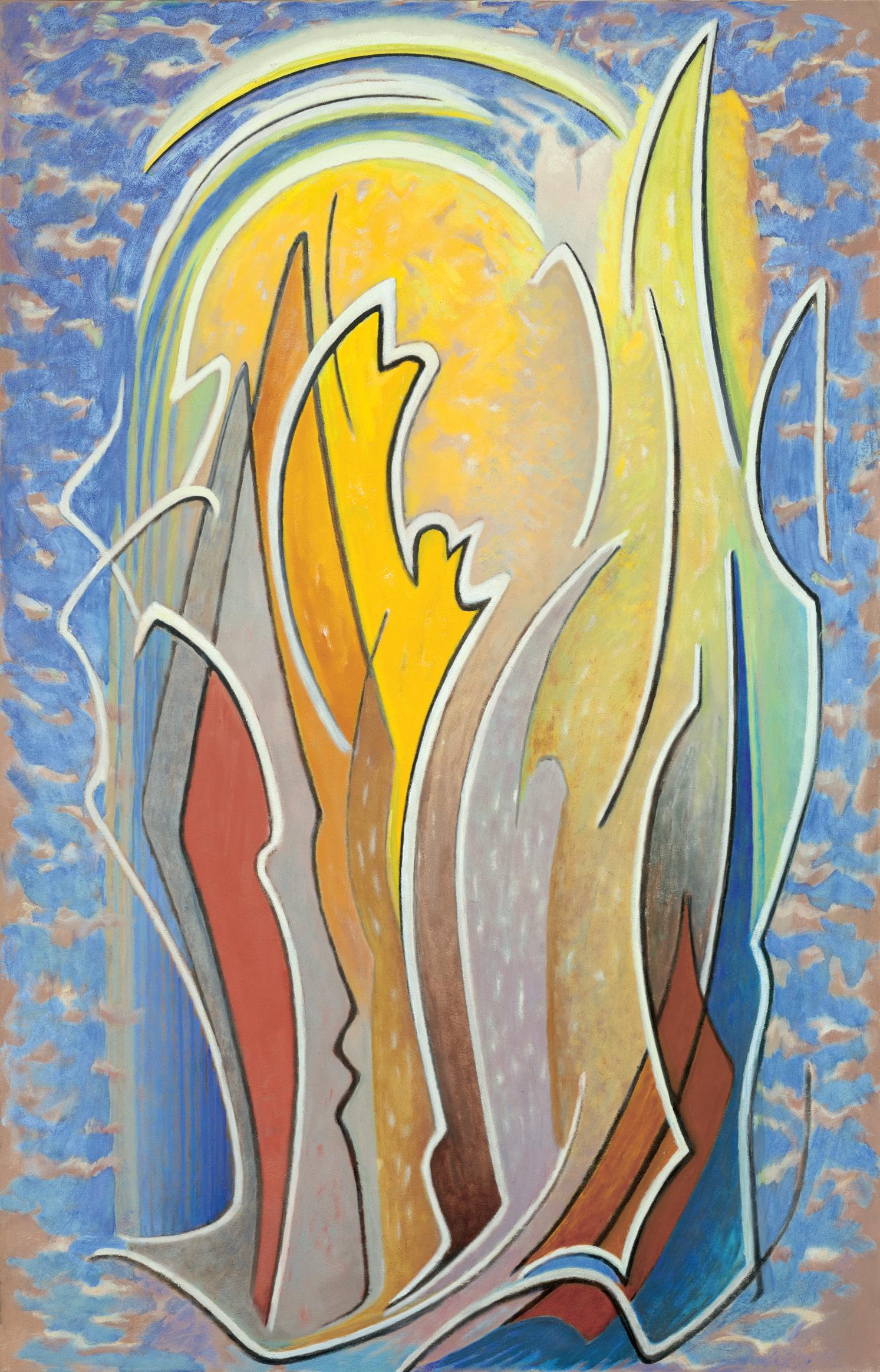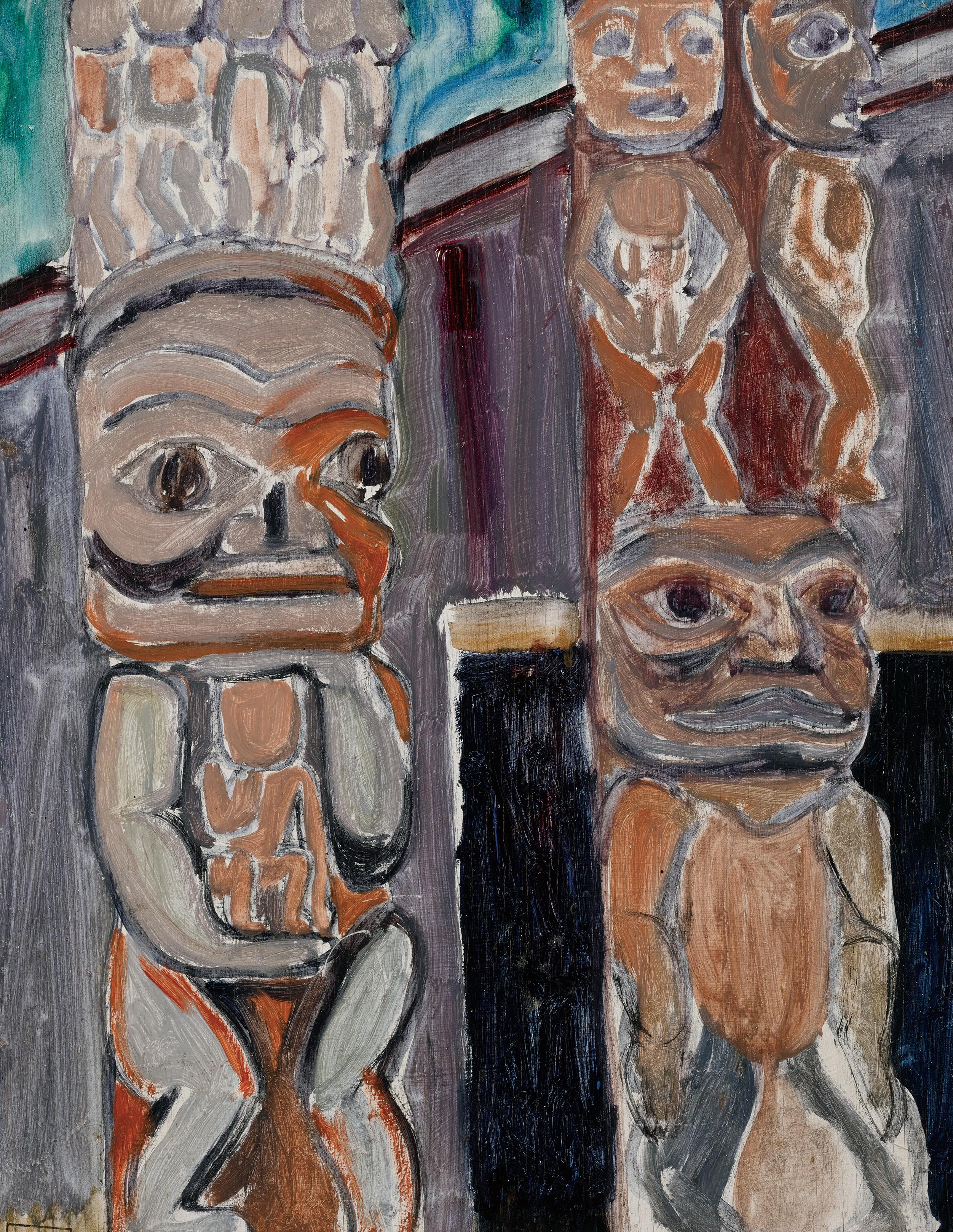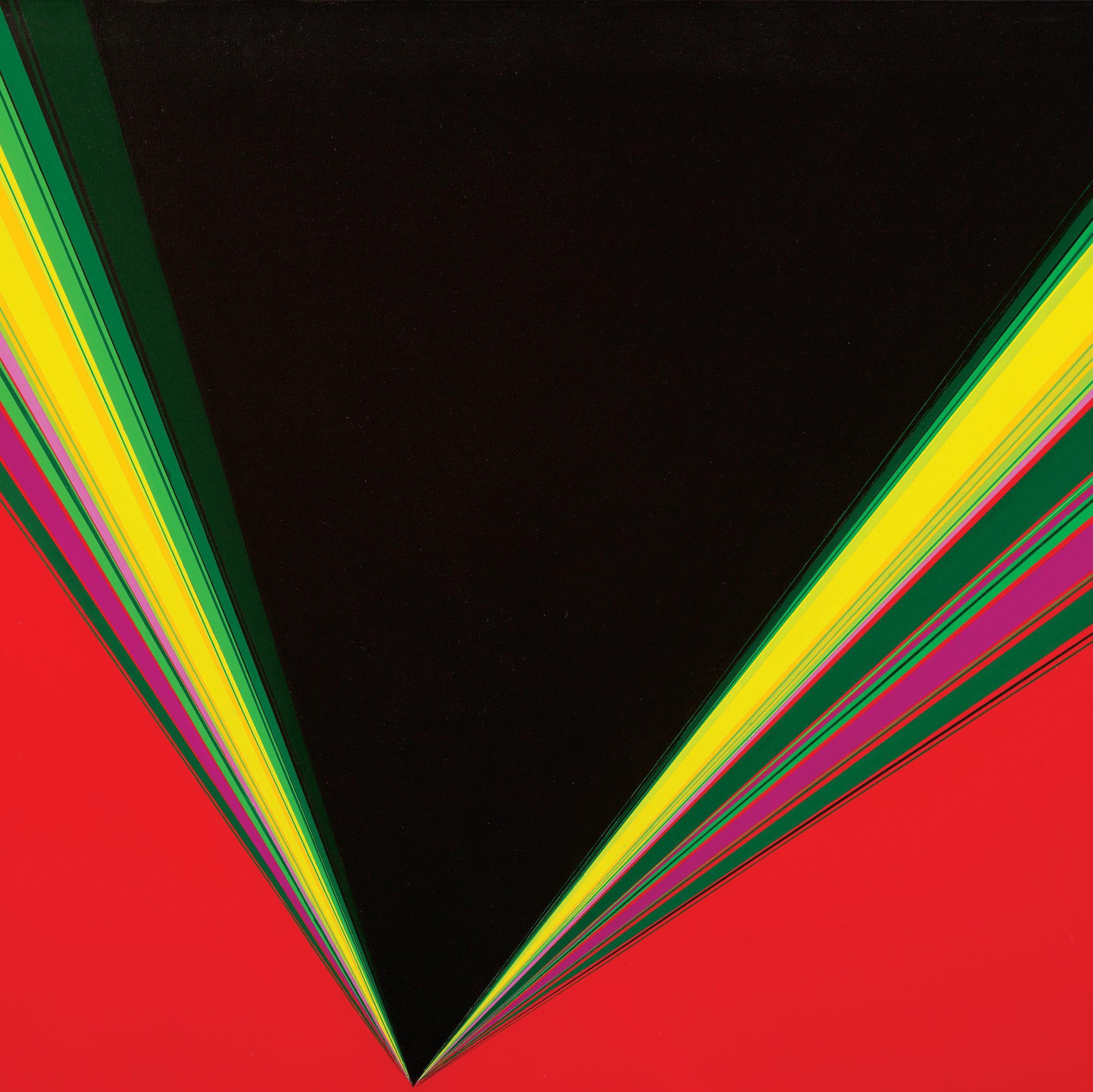Important Canadian and Internatonal Art
The frst session of the Spring Live Aucton presents an excitng selecton of work by Canadian and internatonal artsts, with many making their aucton debut with Cowley Abbot this season. Entrusted to our team by natonal and internatonal private collectors, estates, corporatons and trade clients, these artworks were acquired through private channels, at aucton, from commercial galleries or from the artsts directly.
This varied selecton of paintngs, prints and sculpture represent historical, post-war and contemporary artsts from across Canada and beyond our borders, providing a rich array of artwork that efectvely represents the current market and the interests of new, intermediate and seasoned collectors.
We extend our thanks to the community of curators, writers and academics who contributed research and writng for this catalogue to ensure that these works of art are presented with their comprehensive histories and stories. We thank Lisa Baldissera, Alec Blair, Mark A. Cheetham, Lucie Dorais, Andrew Kear, Anne Macklin, Joan Murray, Roald Nasgaard and Dr. Sarah Stanners.
COWLEY ABBOTT | Live Auction - Spring 2024 4

With over a decade of exemplary service to the art market in Canada, Cowley Abbot contnues to exceed the expectatons of our clientele. Ofering aucton, private sale and appraisal services, the Cowley Abbot team has the experience, relatonships and reputaton to provide the highest level of assistance.
THE COWLEY ABBOTT TEAM















326 Dundas Street West Toronto, Ontario M5T 1G5 416‒479‒9703 | 1‒866‒931‒8415 (toll free) mail@cowleyabbot.ca
Lydia Abbot
Rob Cowley
Sydney Rodrigues
Eryn Brobyn
Katherine Meredith
Anna Holmes
Ryan Mayberry
Perry Tung
Catherine Lacroix
Peter Ohler
Nicole Plasket
Leah Carey
Julia De Kwant
Mathew Ohler
Patrick Staheli

1FREDERICK HORSMAN VARLEY
Summer Day, Don Valley oil on panel Varley Inventory stamp no. 326 on the reverse 9.25 ins x 12.75 ins; 23.5 cms x 32.4 cms
PROVENANCE
Private Collection, Edmonton
LITERATURE
Peter Varley, Varley, Toronto, 1983, page 83
Summer Day, Don Valley was painted shortly after Frederick Varley settled in Canada. Hailing from She eld, England, Varley had been encouraged to seek new opportunities in Canada by his friend and fellow artist Arthur Lismer. Varley found work in Toronto as an illustrator at Grip Limited, alongside Tom omson and future Group of Seven members. e artist’s early years in Toronto were primarily focused on his commercial work. Peter Varley notes that following
Varley’s move to ornhill, his weekend painting trips to Toronto’s Don Valley “revitalized his interest in painting, particularly in oil, which allowed more freedom than did watercolours in searching out a landscape’s rhythms and compositional structures.” Varley’s main interest tended to centre on portraiture, and Varley’s small oil sketches at the time often featured gures in the landscape. Despite his experience with commercial work, Varley tended to avoid incorporating stylized, Art-Nouveau in uenced graphic motifs in his paintings as his close colleagues had.
Summer Day, Don Valley appears to show the artist fully embracing and enjoying the qualities of painting with oils outdoors. A urry of energetic brushwork lls the pictorial space, ampli ed by the small scale and dense composition. e vigorous, rapid paint handling has much in common with that of Varley’s close colleague Tom omson. Warm pinks and silvery blues convey the direct heat of the summer sun. e vitality of the two young men shing is depicted with an economy of means. Varley’s mastery of the medium is evident in his rich, con dent handling of the subject.
$30,000–$40,000
COWLEY ABBOTT | Live Auction - Spring 2024 6 – Spring 2024
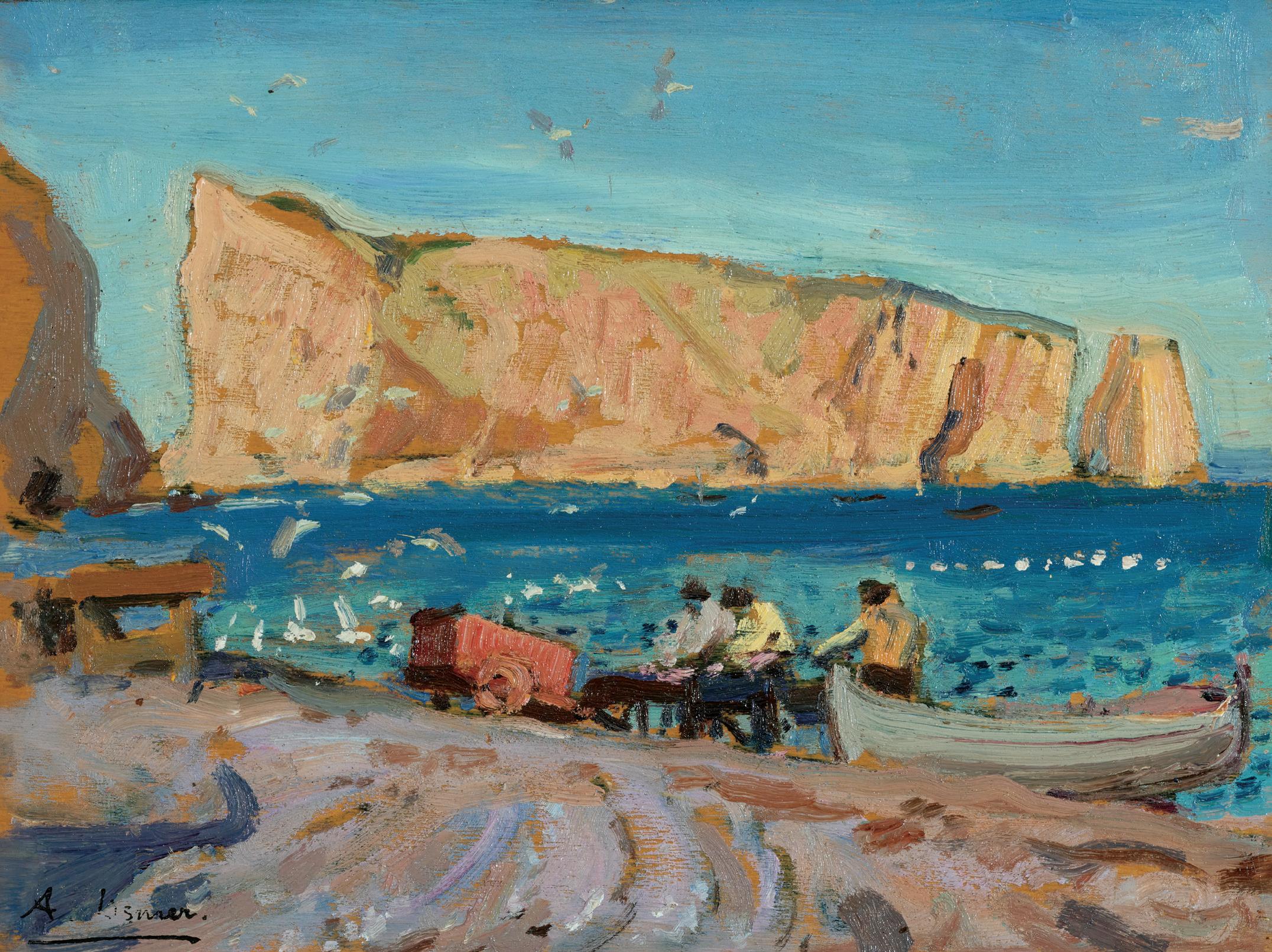
2ARTHUR LISMER
Percé oil on panel signed lower left; Arthur Lismer Estate stamp on the reverse 9 ins x 12 ins; 22.9 cms x 30.5 cms
PROVENANCE
Walter Klinkho Gallery, Montreal Private Collection, Vancouver
e sea and coast were among Arthur Lismer’s favourite landscape subjects. His depictions of turbulent seashores and dramatic skies harkened back to his early studies of John Constable and the Romantic painters. Lismer worked from both Canadian coasts throughout his career, and had lived in Nova Scotia from 1916 to 1919. ere he was commissioned to capture scenes of the Halifax harbour
with Navy vessels from the First World War. Following a return to Toronto, his position as vice-principal at the Ontario College of Art allowed Lismer to go on numerous sketching expeditions during the summers. In August of 1925, Lismer travelled to the region of the lower St. Lawrence River, along with A.Y. Jackson and the renowned ethnologist Marius Barbeau. e Gaspé region o ered a multitude of ideal painting subjects for Lismer, and the artist’s output on the trip was abundant.
Percé wonderfully exempli es Lismer’s Group period en plein air sketches, with its fresh immediacy and vigorous, painterly brushstrokes. e shermen on the coast focus on their work, their forms emphasized by the crystal blue of the sea behind them. e unmistakable Percé Rock formation looms above them, lling the top half of the picture with its distinctive silhouette. Lismer has e ciently captured the e ect of the hot summer sun bearing down with full force on the iconic landmark.
$30,000–$50,000
COWLEY ABBOTT | Live Auction - Spring 2024 7

3ALFRED JOSEPH CASSON
Pic Island, Lake Superior oil on board signed lower right; signed, titled and dated 1928 on the reverse, signed and titled on the artist's label on the reverse 9.5 ins x 11.25 ins; 24.1 cms x 28.6 cms
PROVENANCE
Roberts Gallery, Toronto
Dr. John A. Palmer, Toronto
Joyner Fine Art, auction, Toronto, 27 May 1986, lot 26 Private Collection, Toronto
LITERATURE
Paul Duval, A.J. Casson/His Life & Work/A Tribute, Toronto, 1980, pages 65-76
A.J. Casson, My Favourite Watercolours, Toronto, 1982, pages 45-63
is oil painting was completed during A.J. Casson’s only trip to Lake Superior. He accompanied Harris, Jackson and Carmichael to Port Coldwell in October 1928. is trip turned out to be the last Group sketching trip to this part of the country. Casson used oils exclusively on this occasion, as the rough weather conditions were not conducive to sketching in the usual medium of watercolour. e artist’s subsequent Lake Superior canvases and watercolours were worked up from the small oil sketches executed during the trip.
Paul Duval points out that Casson “found it di cult to adjust to the scale and sheer grandeur of the Lake Superior panoramas, and to the starkness of its form and colours. During October, that country is black, grey and gold-black spruce, gold poplars and birch and, everywhere, grey rock. Above, the sky is a clear silvery blue or lled with dark storm clouds.” In Duval’s opinion, the “oil sketches the artist took back to Toronto with him were some of the best he had yet achieved.” Casson describes his impressions from this trip, writing: “ e north shore of Lake Superior was a revelation to me and my sketches of the area were a major departure from anything I had done before.”
$30,000–$50,000
COWLEY ABBOTT | Live Auction - Spring 2024 8

4ALFRED JOSEPH CASSON
October Afternoon–Bancroft oil on canvas
signed lower right; signed, titled and dated on the artist's label on the reverse 30 ins x 37 ins; 76.2 cms x 94 cms
PROVENANCE
Roberts Gallery, Toronto Private Collection, Toronto
e 1960s proved to be a fruitful period for A.J. Casson. e artist’s association with Roberts Gallery and the six dedicated one-man exhibitions of his work from 1959 to 1979 meant that Casson was able to be free from the constraints of his commercial career to focus on artistic production. In 1967, the year in which October Afternoon was painted, Casson was awarded the Silver Centennial Medal and his work was included in ree Hundred Years of Canadian Art, an exhibition at the National Gallery of Canada.
A.J. Casson’s interest and commitment to depicting the varying landscape of Ontario made him deeply familiar with the land. e distinct seasons in the province meant that Casson’s environment was constantly changing, providing him with ample inspiration and enabling him to render the subtlety of the countryside expertly. is oil depicts the radiant autumnal colours in the hills near Bancroft, a town located on the York River and a popular destination for cottagers in Hastings County.
$70,000–$90,000
COWLEY ABBOTT | Live Auction - Spring 2024 9
EMILY CARR
Two Totems
oil on board
artist estate stamp lower left 16.25 ins x 13.75 ins; 41.3 cms x 34.9 cms
PROVENANCE
Dominion Gallery, Montreal Private Collection, Edmonton
From 1928 to 1930, Emily Carr set out on her nal major painting excursions to the northern coastal and interior regions of British Columbia, revisiting many of the sites she had visited in 1912, during her rst research trips. She went to the Nass and Skeena region, Haida Gwaii, Friendly Cove and Quatsino, where she produced numerous studies which would later be used as sources for her more developed studio paintings. ese smaller works, produced in situ during this period, included watercolours, charcoal drawings on manila paper, numerous notebook sketches as well as rapidly completed plein air works on board, such as the small painting, Two Totems, likely completed in situ at the village of Gitanyow.
At this time, Carr began to project her own sense of spirituality into her paintings of First Nations culture, inspired by what she saw as their inherent transcendental power and cultural signi cance. rough extensive journeys to Indigenous villages throughout the interior and coastal areas of British Columbia, Carr sought to portray the central and emanating cultural and spiritual forces of the subjects using distilled and reduced form. She also continued to maintain her delity to the original Indigenous sources, by accurately depicting the features of gures and imagery that comprised the totems, welcome gures, house posts and community houses.
By the late 1920s, Carr had fully internalized her French studies and her focus now was on re ecting the Indigenous sources without the embellishment of fragmented brushwork and heightened colour, as she highlighted her focus on the spiritual nature of Indigenous artistic and cultural expression. Studies from the site visits during these travels were later used as sources for many of the masterworks of her mature period, re ecting her practice of working up major canvasses from in situ sketches and drawings. is practice allowed her to create the familiar stylized large-scale easel works for which Carr became known in her later career. In this later work, gures in the village sites and landscapes appear less often, which re ected this new stylization and formal concern, as well as the changes that had occurred in many of the village sites since her earlier trips. Colonial incursions, including disease, forced dispossession and dislocation had resulted in the depopulation and dismantling of many village sites, an e ect which had left many irrevocably changed.
e heightened or non-objective chroma, use of outlining and closecropping focus of her modern training can be seen in the original sketches from this period. Here, Carr begins to emphasize the monumentality of the form. Key to the works of this period was Carr’s ability to depict the underlying formal structure within her subjects and to use their key features as unifying forces in her work.
Carr’s journey to the village of Gitanyow, or Kitwancool as Carr called it, a Gitxsan village located on a branch of the Skeena River, is documented in the story, Kitwancool, from the Governor General Award-winning memoir and story collection, Klee Wyck , published in 1941. e story depicts Carr’s struggle to access the Gitanyow community. Her encounters with the hereditary chief’s family, including the matriarch, Chief Miriam Douse Gamlakyeltqu, are emblematic in their revelation of Carr’s own assumptions and lack of awareness about the political activism of the Douse family. Responding to Mrs. Douse’s query about why she has come to the village, Carr explains that she wants to "make some pictures of the totem poles." When pressed further for her reasons for doing so, Carr responds: “ e young people do not value the poles as the old ones did. By and by there will be no more poles. I want to make pictures of them, so that your young people as well as the white people will see how ne your totem poles used to be.” is ‘salvage paradigm’—the belief in a disappearing culture that must be conserved and documented by colonial forces—is neatly summarized in this statement. Despite this, Mrs. Douse, her husband, and family, welcomed Carr as a guest in their home during her time in Gitanyow, and Carr set about a project to archive her discoveries. Carr’s work from this visit also includes a watercolour portrait, titled Mrs. Douse, e Chieftainess of Kitwancool while the series of works that emerge from this time at Gitanyow depict with clarity the village’s many totems for which it was wellknown.
Two Totems is part of a series of studies produced at Gitanyow. It is a con dent work comprised of oil on board, very likely produced en plein air at the village site and a compelling painting in its own right. Carr employs denaturalized colour learned and re ned since her time in Normandy; swaths of viridian green and ultramarine blue applied as washes e ciently reference the forest that is the backdrop to the scene. e composition is closely cropped, revealing only a small section of the two totems to highlight the detail and power of their individual characters. e totems are equally held in place compositionally by the house structure located behind them: mapped as negative space within an e ciently blocked-in composition, its surface of Payne’s grey and umber frames a cavernous door in deep black.
Carr has taken pains to depict the detail of the totem’s several human gures, outlined in black for later reference: in one pole, a mother and child gure, crowned with a frieze of other children, re ects a motif repeated in the Vancouver Art Gallery studio painting, Totem Mother, Kitwancool, 1928. Re ecting on this moment in her story, Carr writes: “I sat in front of a totem mother and began to draw–so full of her strange, wild beauty that I did not notice the storm that was coming, till the totem poles went black, ashed vividly white and then went black again.” One can imagine that, ensconced in the family of her hosts, Carr may have been especially aware of the relations that are depicted here, when she notes: “ e mothers expressed all womanhood–the big wooden hands holding the child were so full of tenderness, they had to be distorted enormously in order to contain it all. Womanhood was strong in Kitwancool. Perhaps, after all, Mrs. Douse might let me stay.”
COWLEY ABBOTT | Live Auction - Spring 2024 10 5

Two Totems is among other similar smaller oil on panel works, including a further panel of similar scale, likely from the same village in 1928. Additional comparable works from this period include Kitwanga Pole (BC Archives), Kitwancool, 1928 (Glenbow Museum) and Totem Poles, Kitwancool Village, 1928. Several studies from this excursion were also later developed into large studio works.
We extend our thanks to Lisa Baldissera, Canadian art historian, Director of Gri n Art Projects and former chief curator at the Mendel Art Gallery in Saskatoon for contributing the preceding essay. Lisa is the author of the Art Canada Institute’s Emily Carr: Life & Work , available at www.aci-iac.ca.
$150,000–$200,000
COWLEY ABBOTT | Live Auction - Spring 2024 11

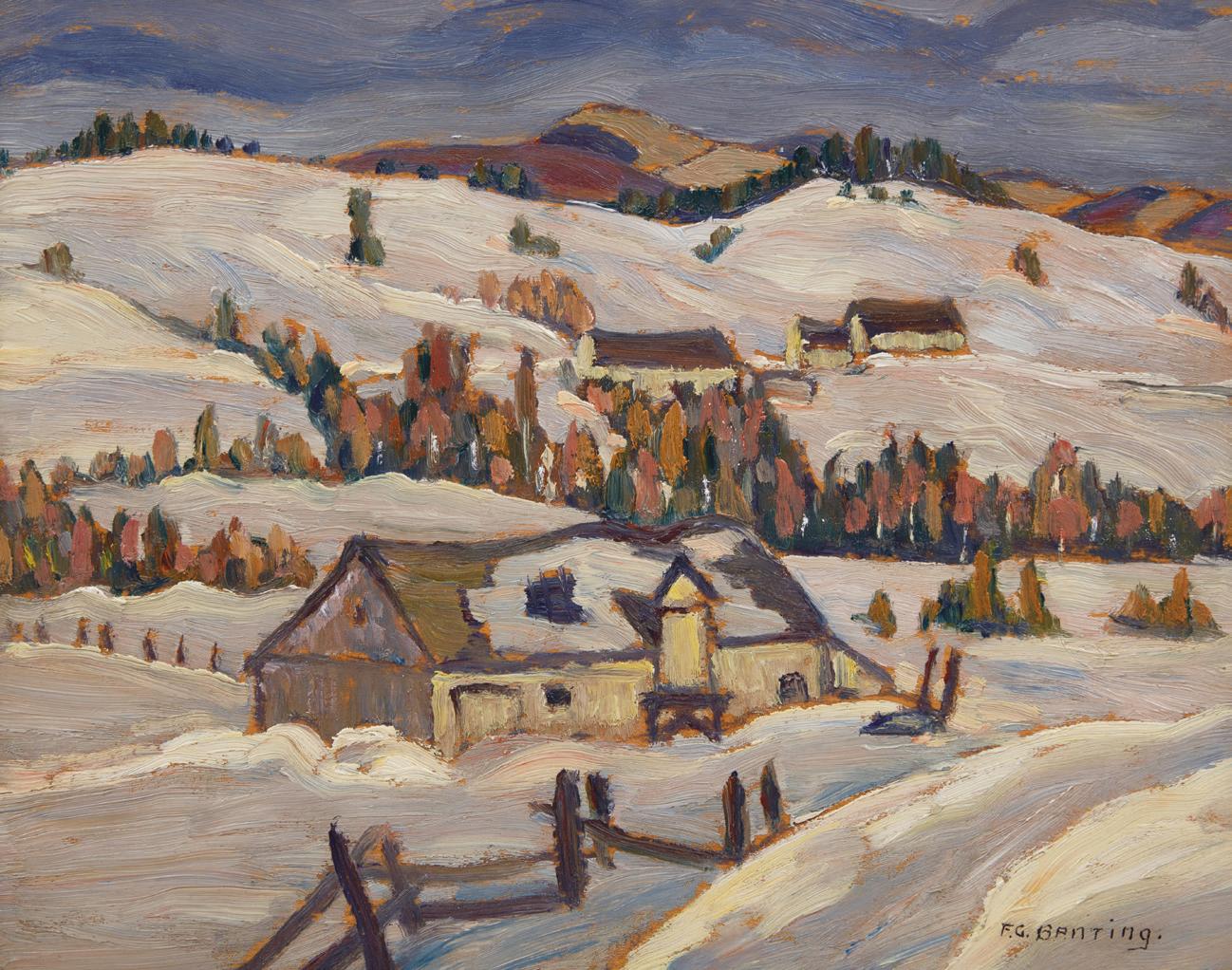
6
FREDERICK GRANT BANTING
Bic, Quebec oil on canvas
signed lower right; signed, titled, dated 1927 and F.G. Banting M.D. stamp (signed and dated 1941 by Lady Henrietta Banting) on the stretcher on the reverse 19 ins x 23 ins; 48.3 cms x 58.4 cms
PROVENANCE
Roberts Gallery, Toronto
Joyner Fine Art, auction, Toronto, 26 November 1985, lot 339
Private Collection, Toronto
EXHIBITED
Our Visual Heritage, WKP Kennedy Gallery, North Bay, 3-26 August 2000
$30,000–$40,000
7
FREDERICK GRANT BANTING
St. Tite des Caps oil on board signed lower right; signed, titled ("St. Tete [sic] de Cap [sic]") and dated 1937 on the reverse 8.5 ins x 10.5 ins; 21.6 cms x 26.7 cms
PROVENANCE
Jim A. Hennok, Toronto Roberts Gallery, Toronto Private Collection, Toronto
EXHIBITED
Exhibition of Paintings by the Late Sir Frederick Banting, Hart House, University of Toronto, 13 February-1 March 1943
Banting & Jackson: An Artistic Brotherhood , London Regional Art & Historical Museums; travelling to the Canadian Medical Hall of Fame, London, Ontario, 28 May-4 August 1997, no. 17
LITERATURE
A.Y. Jackson, Banting as an Artist, Toronto, 1943, reproduced page 28
Joyner Fine Art, auction catalogue, 18 May 1993, lot 90, for the canvas related to this artwork (Quebec Farms, St. Tete Du Caps[sic])
Sotheby's Canada, auction catalogue, 27 November 1996, lot 75, for the canvas related to this artwork (Quebec Farms, St. Tite des Caps)
D.B.G. Fair, Banting & Jackson, An Artistic Brotherhood, London, Ontario, 1997, reproduced page 19 (plate 1) as Ste. Irénée, 1931
$20,000–$30,000
COWLEY ABBOTT | Live Auction - Spring 2024 12
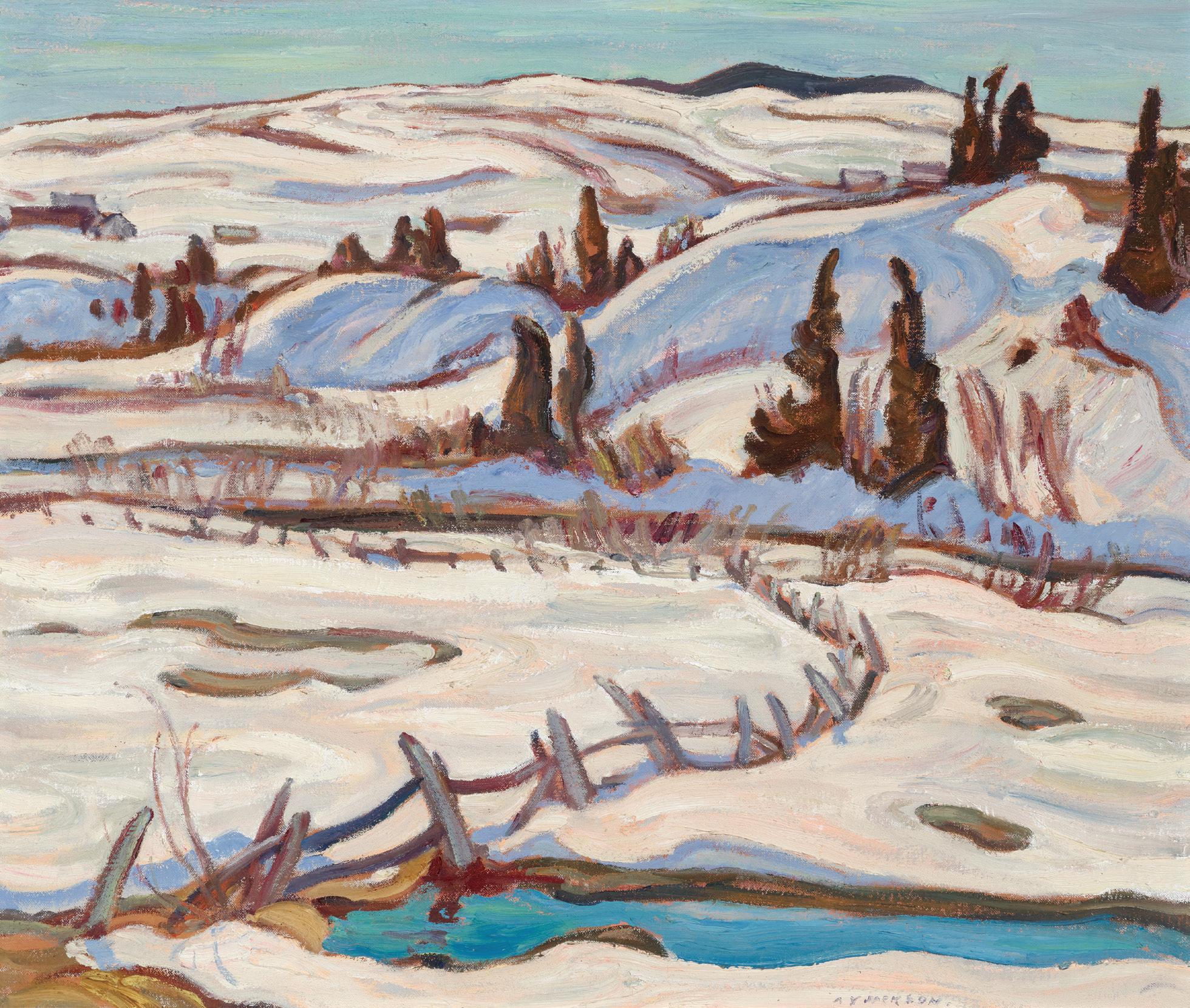
8ALEXANDER YOUNG JACKSON
North Shore, Quebec oil on canvas signed lower right 22.25 ins x 26.25 ins; 56.5 cms x 66.7 cms
PROVENANCE
Gift from the Artist to Dr. Stanley Minto Campbell, Toronto
By descent to a Private Collection, Ontario
He el Fine Art, auction, Toronto, 22 November 2012, lot 159 Private Collection, Toronto
LITERATURE
Naomi Jackson Groves, A.Y.’s Canada , Toronto/Vancouver, 1968, page 44
Charles C. Hill, Canadian Painting in the irties, Ottawa, 1975, page 11
e landscapes of rural Quebec are A.Y. Jackson’s signature subjects. While he had painted in the Eastern Townships before World War I, it was only in February and March 1921 that he painted on the Lower Saint Lawrence. Over the subsequent decades he made almost annual forays in late winter and early spring, painting in the many
small villages along the north and south shores. ese small, rural towns attracted Jackson and his companions since they retained the traditional way of life during a time when society was becoming increasingly modernized and populous.
North Shore, Quebec demonstrates Jackson’s strong sense of both colour and composition through its uid, rhythmic lines of the snowy terrain, trees and hills, as well as the luminous blanket of snow and accents of aqua in the stream and sky. Jackson enjoyed early spring sketching for the brilliant sunshine and the softening of the snow over the land. Charles C. Hill remarks on Jackson’s preference for portraying these time periods in the Canadian landscape: “It was the changing seasons that attracted A.Y., not the bright greens of summer, nor the blank whiteness of winter, but the ow of winter to spring or the blaring up of summer into autumn.” North Shore, Quebec reveals patches of eld, bare shrubbery and a glistening stream emerging from the luscious layers of snow. is painting is a commanding example of Jackson’s skill at rendering the charming Quebec landscape, evoking the arrival of spring as the last of winter fades. Jackson expertly captured the heart of Quebec, and fondly recalled, “I have worked in villages on both the north and south shores of the St. Lawrence. I have happy memories of a great many places.”
$80,000–$100,000
COWLEY ABBOTT | Live Auction - Spring 2024 13

9MARC-AURÈLE FORTIN
Près de Café à Montréal, Rue Wolfe oil on board signed lower left; titled " Près de Café à Montréal, Rue Wolf" on the reverse 22.25 ins x 28 ins; 56.5 cms x 71.1 cms
PROVENANCE
Private Collection, Edmonton
Born in Sainte-Rose, just north of Montreal, Marc-Aurèle Fortin studied ne art locally under Ludger Larose and Edmond Dyonnet. Fortin moved to the United States for further study at the Art Institute of Chicago, where he discovered the works of Jean-François Millet, Claude Monet and Mary Cassatt. In 1914, he returned to Montreal, holding various jobs and painting in his spare time. Drawing inspiration from his urban surroundings, Fortin depicted Montreal’s Wolfe Street in his formative period, and returned to the same subject years later.
A recurring theme in Fortin’s oeuvre is the relationship between humanity and nature, with gures, buildings, and towns played against natural elements such as trees and mountains. With the French Impressionists as a formative in uence, Fortin was preoccupied with the rapid industrialization and urban growth in North America during the early 20th century. Près de Café à Montréal, Rue Wolfe is a wonderful example of the artist’s urban scenes. Painted in Fortin’s distinctive mature style, bright colours have been laid down in thick strokes on a black ground layer. e work is boldly modernist in its execution. e paint application is made up of a mosaic of short brushstrokes, and black outlines lend the painting a stylized, graphic quality. Fortin was a gifted colourist, and here he contrasts the red of the window frames with complimentary green shutters. e warm, colourful hues of the buildings are set o by the brilliant blue of the sky.
Fortin’s painting serves as a fascinating documentation of Montreal’s history, as this row of Wolfe Street buildings no longer exists.
Près de Café à Montréal, Rue Wolfe features the stone masonry and the speci c architecture of a working-class neighbourhood since lost to development.
$30,000–$50,000
COWLEY ABBOTT | Live Auction - Spring 2024 14

10
WILLIAM KURELEK
Our First Three Homes in Canada oil on board
signed with monogram and dated 1966 lower right; titled and dated 1966 on the reverse; inscribed "For Paul" on the gallery label on the reverse 17 ins x 21.25 ins; 43.2 cms x 54 cms
PROVENANCE
Isaacs Gallery, Toronto
Private Collection, Toronto
By descent to the present Private Collection, Toronto
LITERATURE
William Kurelek, e Ukrainian Woman Pioneer in Canada , Toronto, 1968, unpaginated
is painting was owned by an executive of the Ukrainian Women’s Association of Canada. In 1965 this group commissioned Kurelek to paint the series, e Ukrainian Pioneer Woman in Canada . Twenty paintings were completed in the years leading up to the 1967 Canadian Centennial. e series served to mark the 40th anniversary of the Association, the 75th anniversary of Ukrainian immigration to Canada as well as displayed at the Ukrainian Pavilion at Expo 67 in Montreal. Although the Association was unable in the end to purchase the entire suite of works, Kurelek writes that they “gave me a lot of moral support.”
e series, Ukrainian Pioneer Woman in Canada includes three individual paintings, each depicting a home Kurelek’s Ukrainian relatives had built in Alberta between 1905 and 1925. e rst features a primitive boorday —which Kurelek describes as a “covered over hole in the ground”—that would come to serve as the root cellar when the second, more permanent, structure resembling the village houses they had known in Ukraine had been built. e third house, framed in “the general style of prairie architecture at the time” and having “no Ukrainian features whatever” represented, for Kurelek’s family, a culmination of their immigrant experience. Our First ree Homes in Canada was completed while Kurelek was working on the Ukrainian Pioneer Woman in Canada , but it does not appear in the nal series— suggesting it was a gift or private commission.
Here, all three houses appear within a single picture, with the rst two rendered as historical photographs, trompe l’oeil elements that overlay the main image of the third house.
We extend our thanks to Andrew Kear, Canadian art historian and Head of Collections, Exhibitions and Programs at Museum London for contributing the preceding essay. Andrew is the past Chief Curator and Curator of Canadian art at the Winnipeg Art Gallery, a Curator of the 2011/2012 national travelling exhibition William Kurelek: e Messenger and author of the Art Canada Institute’s William Kurelek: Life & Work , available at www.aci-iac.ca.
$50,000–$70,000
COWLEY ABBOTT | Live Auction - Spring 2024 15
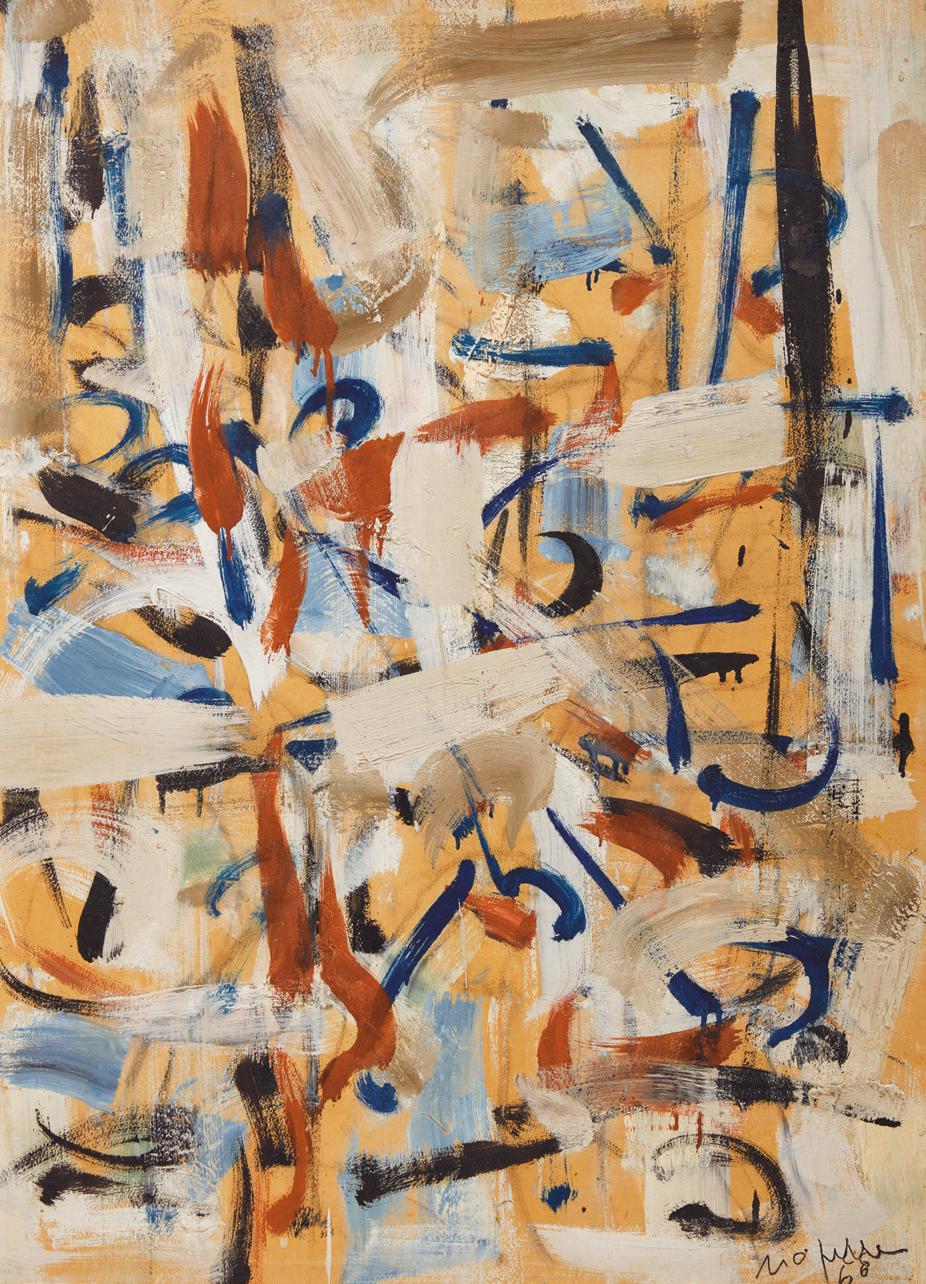
11
JEAN PAUL RIOPELLE
Composition oil on paper on canvas signed and dated 1958 lower right
30.5 ins x 22 ins; 77.5 cms x 55.9 cms
PROVENANCE
Private Collection, Toronto
e 1950s brought much success for Jean Paul Riopelle due to increased contact with prominent members of the New York School and the international art scene. Riopelle met the American painter Joan Mitchell in Paris during the summer of 1955. e two artists swiftly entered a romantic relationship that endured for nearly twenty- ve years. Riopelle had recently shown his work twice at the Pierre Matisse Gallery in New York in 1955, rst in May and then in December. Mitchell may have attended the second exhibition, as she had returned to America shortly after meeting Riopelle and was working at her studio in St. Mark’s Place, New York. Despite the distance, the two artists maintained correspondence. In a letter to Mitchell dated January 10, 1956, Riopelle shared that he was experiencing a shortage of inspiration in oils and was instead painting in gouache. Composition was painted in 1958, during the early years of Riopelle and Mitchell’s romance. Executed in oil on paper mounted on canvas, the work bears similarities to his experimental gouaches of the time. e delicate, overlapping layers of paint with exposed ground recall the the e ects of gouache and create a stark contrast to the thick impasto of his mosaics.
$30,000–$50,000

12
RITA LETENDRE
Eridan oil on canvas signed and dated 1963 lower right; signed, titled, dated and inscribed "Paris" on the reverse 18 ins x 21.5 ins; 45.7 cms x 54.6 cms
PROVENANCE
Galerie Camille Hébert, Montreal as Eridon Private Collection, Ontario
As a young artist, Rita Letendre studied brie y at the École des beaux-arts in Montreal, and became interested in the in uential abstract works of Les Automatistes. Letendre was part of the second wave of Montreal artists who emerged directly following the collective in the early 1950s. By the early 1960s, Letendre had earned both commercial success and critical acclaim.
In uenced by artists such as Paul-Émile Borduas and Franz Kline, Letendre’s paintings of the period were con dent, gestural abstractions with dense impasto surfaces. Letendre put palette knives and spatulas to expert use to create luscious painterly textures. ese works often featured dark swirls of oil paint sharply contrasted with areas of vivid colour. Eridan features a horizontal swath of cadmium orange, which appears almost luminescent.
$25,000–$35,000
COWLEY ABBOTT | Live Auction - Spring 2024 16

JEAN PAUL RIOPELLE
Ysoldus
oil on canvas
signed and dated 1962 lower right; catalogue raisonné no. 1962.066H.1962
15 ins x 18 ins; 38.1 cms x 45.7 cms
PROVENANCE
Galerie Jacques Dubourg, Paris Private Collection, Edmonton
LITERATURE
Yseult Riopelle, Jean Paul Riopelle: Catalogue Raisonné, Volume 3, 1960-1965, Montreal, 2009, reproduced page 177, catalogue no. 1962.066H.1962
François-Marc Gagnon, Jean-Paul Riopelle: Life & Work [online publication], Art Canada Institute, Toronto, 2019, page 65
Among the avant-garde Quebec abstract artists, Jean Paul Riopelle was the most celebrated gure on the international scene. He rst travelled to France in 1946 and returned to Montreal for only a few months before settling in Paris until the 1970s. Riopelle soon met the Parisian art dealer Pierre Loeb, owner of Galerie Pierre, who promoted major Surrealist and Cubist artists, including Picasso and Miró. It was through Loeb that Riopelle met André Breton, who invited Riopelle to participate in the major Surrealist exhibition of June 1947 held at Galerie Maeght.
Ysoldus, completed in 1962 while living in Paris, illustrates a new direction which Riopelle began to take in his paintings of the late 1950s. ough maintaining aspects of his mosaic-like paint application known as tachisme, Riopelle abandoned an all-over structure and atomized brushstrokes in favour of lines. François-Marc Gagnon writes: “Gone are the separate and distinct tiles of the mosaic works of the 1950s, that sense of an artist in search of a loss of vision and line. ey are replaced with something new; now, the viewer can follow the path of the palette knife as it moves, leaving trails that sometimes look as if a nger has been drawn through the material. [...] e coloured areas are also more varied, resulting in a composition full of new possibilities.” is description applies to Ysoldus, with organized palette knife strokes around the edges of the canvas, surrounding a tight arrangement of uid lines in the centre. ese lines, which look like they could have been drawn with a nger, nearly resemble recognizable shapes and letters. ese loose depictions of indistinct forms would gradually evolve into guration, which appear in his works towards the end of the decade, most commonly in the form of birds and animals.
Created during a vital and transitional period, Ysoldus highlights the artist’s consistent and rapid evolution in his exploration of oil painting. $100,000–$150,000
COWLEY ABBOTT | Live Auction - Spring 2024 17 13
JACK HAMILTON BUSH
Zheeg
acrylic on canvas
signed, titled, dated "Feb. 1975" and inscribed "Toronto" and "acrylic polymer W.B." on the reverse 80.5 ins x 37.5 ins; 204.5 cms x 95.3 cms
PROVENANCE
e Artist
Private Collection, New York, October 1975
Acquavella Contemporary Art, New York
Ken Carpenter, Toronto, February 1976
By descent to the present Private Collection, Toronto
LITERATURE
Ken Carpenter, “ e Evolution of Jack Bush,” Journal of Canadian Art History, IV:2, 1977-78, gure 11, page 127
Zheeg is an example of what Professor Ken Carpenter personally loved and professionally espoused: the abstract paintings of Jack Bush. Carpenter was an expert on the artist, having published eight articles featuring the work of Jack Bush and a catalogue, e Heritage of Jack Bush: A Tribute, to accompany an exhibition by the same title which he curated for the Robert McLaughlin Gallery in 1981. He knew Jack Bush and his writing bene ted from the connection he had made. Soon after Bush’s sudden passing in January 1977, Carpenter’s writing on the artist proliferated, as if to savour what had been lost.
Carpenter was also a professor of art history at Toronto’s York University. Jack Bush had designed a banner for York University’s Vanier College, in 1965, and Carpenter proudly hung the resulting banner in his home. His two beloved Bush paintings, Zheeg and Vic Day, were also present in his home. When I met with Carpenter to document his paintings for the catalogue raisonné, in 2012, he shared the special connection he felt with Zheeg. As he likely told others, Carpenter dreamt of Zheeg before he purchased the painting, or even knew of its existence. (Conversation with the author, 18 October 2012)
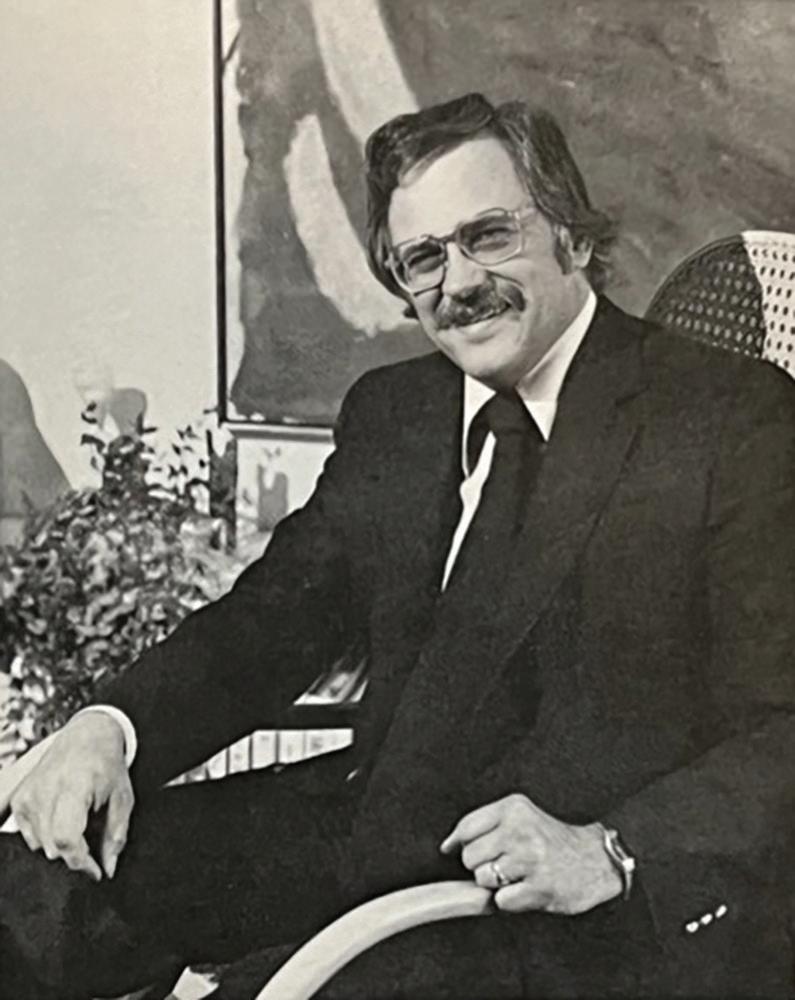
Zheeg is a vision, and after Carpenter purchased it in 1976 at New York’s Acquavella Gallery, it remained close to him for the rest of his life. A photograph of the curator with Zheeg by Mario Schembri was included alongside Carpenter’s Preface to e Heritage of Jack Bush
What Carpenter admired most about Bush’s musical paintings was their sense of freedom, and in this category, he called Zheeg a masterpiece. Bush’s musical paintings, which are sometimes referred to as “lyrical”, are fully realized in terms of exuding a sense of freedom, but reaching this pinnacle was an ongoing pursuit from the beginning of his career. As Carpenter once observed: “One of the most important constants of Bush’s art is the tendency for the elements to have a life and freedom of their own.” Playful free- oating strokes of colour became the most prevalent motifs seen in Bush’s late painting, from 1974 onward, and yet these same lively colour strokes make an appearance in his paintings as early as 1941, in an oil sketch titled Summer Cottage e artist made a larger studio version of the same painting in 1942, and both paintings feature curtains and a throw blanket covered in freely painted colour strokes that match the lyrical motifs in his late paintings. Could it be that his time away with family at a beach retreat formed a core memory that he drew upon later to produce his late abstract paintings? It is impossible to say, for sure, but as Carpenter argued from the beginning of his interest in Jack Bush, there was an evolution apparent in Bush’s paintings from beginning to end.
Even without the concept of an evolved aesthetic that culminated in abstract paintings that express a sense of freedom, that is, setting aside all that I have outlined here, Zheeg was painted with con dence and candour – the kind that only a fully realized artist can produce. You may notice dribble marks down the length of the canvas; this is the result of his sponge work to produce the mottled ground. Bush soaked his sponge in paint and took to the raw canvas with vigour and immediacy, without a worry for precision. ese water lines are markers of this painting’s making – a carefree action with a beautiful result.
Finally, the name of this painting is playful. In 1974, Bush began to use a glossary of musical terms as a resource for titles. My best estimation of how he arrived at the title Zheeg is that he used the phonetic spelling of the term “Gigue” (/ʒi:ɡ / ZHEEG, French: [ʒiɡ]), which is related to the English term “jig” and describes a lively folk dance. e Gigue is usually the last dance of a Baroque suite and is upbeat in nature. e vertical climb of Bush’s colour strokes in Zheeg also feel uplifting, like a sprightly jig. e Gigue is also often contrapuntal in nature, meaning that it has two independent melodic lines. In Zheeg, we see two distinct sections in the quick line of colour notes: six up and three down.
e most liberating aspect of abstraction is that the possibilities for meaning and feeling are endless. Jack Bush did not subscribe to any one theory of art or pound out a manifesto of beliefs; he painted freely, and he played with colour. Carpenter knew this, too, and summarized this quality best in the title for his last piece of writing on the artist, in 2015: Playful, Searching and Mischievous: e Paintings of Jack Bush.
is painting will be included in Dr. Stanners’ forthcoming Jack Bush Paintings: A Catalogue Raisonné. We extend our thanks to Dr. Sarah Stanners for contributing the preceding essay. Sarah is currently an Adjunct Professor at the University of Toronto’s Department of Art History and author of Jack Bush Paintings: A Catalogue Raisonné. $250,000–$350,000
COWLEY ABBOTT | Live Auction - Spring 2024 18 14
Ken Carpenter with Zheeg, 1981
Photo: Mario Schembri Not for sale with this lot
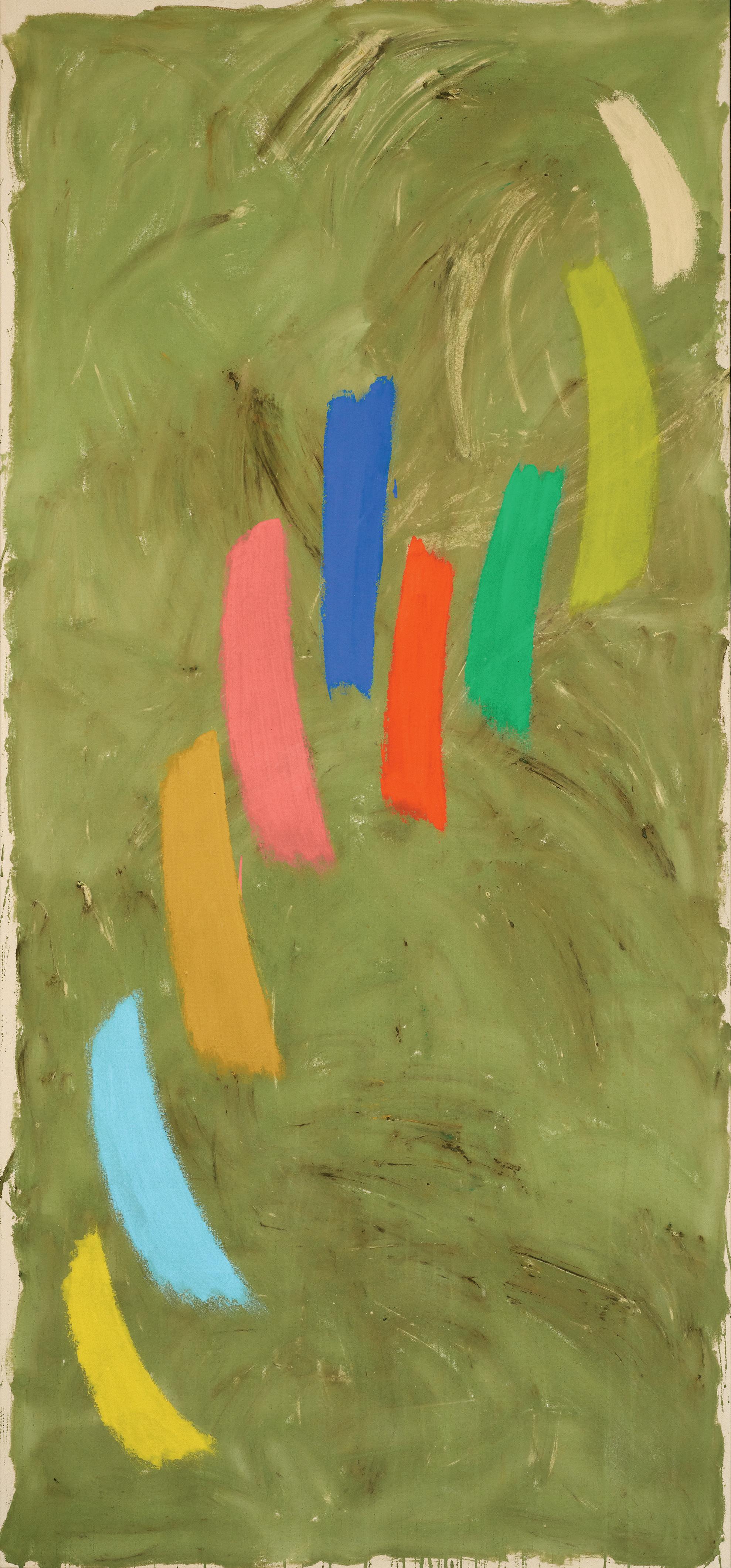
COWLEY ABBOTT | Live Auction - Spring 2024 19
MARCELLE FERRON
Arbre du Ténéré, 1962 oil on canvas signed lower left; titled "L'Arbre du Ténare"[sic] and dated 1962 (twice) on the stretcher 63.75 ins x 51 ins; 161.9 cms x 129.5 cms
PROVENANCE
Mayberry Fine Art, Winnipeg Private Collection, Vancouver
Marcelle Ferron was a pioneer of abstraction and public stained glass installations in Quebec. On the one-hundredth anniversary of her birth, it is tting to honour her contributions and to experience the lasting power of her painting anew.
Ferron enjoyed considerable acclaim in Quebec and internationally during her lifetime. She was a central member of the Montreal avantgarde group Les Automatistes from 1946. Alongside the leader of this group and her mentor, Paul-Émile Borduas, and with other leading reformers, Ferron was a signatory to the 1948 manifesto Refus global (“Global Refusal”). e document was a powerful call to unfetter and modernize artistic, cultural, and social expression in the province. Like so many fellow artists at this juncture, Ferron left Quebec for Paris, where she lived from 1953 to 1966. She received the silver medal at the Biennale of São Paulo, Brazil in 1961 and was named Grand O cer of the Ordre national du Quebec in 2000. Ferron was the rst woman to be awarded the Paul-Émile Borduas Prize in 1983.
Ferron’s pedigree should not distract us from the radicality of her work, its liberatory purpose and its lasting e ect. Painted in France, Arbre du Ténéré is typical of the concentrated yet joyful intensity of her abstract painting. A remarkably varied kaleidoscope of colourful forms dance irrepressibly across the surface. e tonal range is equally dramatic, yet no element, no dark or light or saturated colour dominates.
Arbre du Ténéré reminds us of the power of expressive abstract painting to embody resistance not only to aesthetic conventions but also to personal and social restraints. We can readily perceive this e ect within the frame, so to speak, experiencing only the formal aspects of the painting. But what of Ferron’s evocative title? Like many abstract artists in the mid-20th century, she often resorted to the placeholder ‘sans titre,’ perhaps to underline that we should dwell on what we can see in a painting rather than follow the literary implications of its title. Yet ‘L'Arbre du Ténare[sic]’ must also allude to a world-famous tree, the Tree of Ténéré in the desert of Niger in Africa.
Until it was hit by a car and felled in 1973, this ancient acacia tree was a monument to solitary survival. For generations, it was the only tree in hundreds of square kilometres of the Sahara Desert. e renowned tree was still living when Ferron painted this work, leading us to wonder why she titled this painting as she did. It would be too literal to think that she depicted the tree, but we can imagine a connection between what we see in the painting itself and the tenacity and living dynamism of abstraction, and of art generally, in the world.
Mark A. Cheetham has written extensively on Canadian artists, including Jack Chambers, Alex Colville, Robert Houle, and Camille Turner, most recently in the collection Unsettling Canadian Art History (2022). He is a freelance writer and curator and a professor of Art History at the University of Toronto.
$300,000–$500,000
COWLEY ABBOTT | Live Auction - Spring 2024 20 15

COWLEY ABBOTT | Live Auction - Spring 2024 21
LAWREN STEWART HARRIS
Autumn Leaves
oil on canvas
signed with initials and dated 1910 lower right 25 ins x 20 ins; 63.5 cms x 50.8 cms
PROVENANCE
Private Collection, Ontario Mayberry Fine Art, Winnipeg Private Collection, Vancouver
LITERATURE
Paul Duval, Lawren Harris: Where the Universe Sings, Toronto, 2011, page 60
e year 1910 was a pivotal one for Lawren Harris, as he had returned to Toronto after completing his artistic training in Berlin, as well as travelling in the Middle East. Harris set up his rst studio, located above Giles’ grocery store, north of Bloor and Yonge Streets and was a member of the Arts and Letters Club, which was becoming increasingly active as a bastion of creativity. Harris also married in 1910 to Beatrice (Trixie) Phillips, on the 20th of January. He saw his hometown with a new perspective, launching into both his painting career and career as a married man.
Harris’s interest in the poorer areas of the city gained him a reputation as a socialist painter. His colourful “house portraits” were considered out of the ordinary and even controversial at the time, as he focused on painting the buildings and streets of Toronto from 1910 to 1918. Autumn Leaves is a departure from this hyper-focused period of depicting the urban areas of the city. Instead, executing a luminous, decorative landscape painting. e golden leaves of the beech trees and the dappled light are captivating. e vantage point Harris has chosen allows an intimate quality to the work, illuminating the composition with light and serenity as leaves slowly fall to the ground.
e American Impressionist painter Childe Hassam was an in uential gure for Harris at this time. Childe was a painter of the urban scene, an industrious artist whom Harris would have been aware of after his training abroad. Autumn Leaves is a pure venture into the technique of Impressionism, with a brilliant display of light, colour and brushwork. e lively and engaging surface is akin to Hassam’s style, playing on the e ects of light and shadow. e decorative quality and application of paint in quick dashes of pigment e ectively represents the shimmer of light in the leaves of the trees. Perhaps Harris was eager to explore the romanticism of nature, a consistent theme in Hassam’s work.
Harris was painting the streets and buildings of Toronto in an increasingly Impressionist palette in this period, exploring and embodying a fascination with light’s e ect on colour and experimenting with a high-key colour palette. In Lawren Harris: Where the Universe Sings, Paul Duval highlights Hurdy Gurdy, 1913 (Private Collection), a painting that shares many qualities of the early Autumn Leaves. Duval notes that Hurdy Gurdy has “the briskly rendered, crisply coloured technique closer to American rather than French Impressionism”. is observation can be applied to Autumn Leaves, a painting akin to Hurdy Gurdy with its rich colour palette, vigorous brushwork, dappled light and inclusion of a softly rendered screen of beech trees. Autumn Leaves is a unique work within the early oeuvre of Lawren Harris, signifying the various shifts and developments in his painting during the prime years of his career.
$300,000–$400,000
COWLEY ABBOTT | Live Auction - Spring 2024 22 16

COWLEY ABBOTT | Live Auction - Spring 2024 23
JAMES WILSON MORRICE
Study for Golden Venice, circa 1901-1902 oil on board
5 ins x 6 ins; 12.7 cms x 15.2 cms
PROVENANCE
Lykes Collection, Tampa, Florida Private Collection, Sarasota, Florida Private Collection, Brunswick, Maine
LITERATURE
Charles Fromuth Journal, MNC 2796, Library of Congress, Washington DC, page 91
Sandra Paikowsky, James Wilson Morrice. Paintings and Drawings of Venice, Stuttgart, 2023, pages 170-172. A very thorough commentary on the related drawing and canvas; this and two other canvases depict a stretch of the Grand Canal, northeast of the Rialto Bridge.
After Paris, where he lived since 1890, and more than Montreal, where he was born, Venice is the city most often depicted by J.W. Morrice. However, it was not love at rst sight: after a short stay, likely very early in the Spring of 1894, he left for Capri, where he stayed much longer. If he never returned to Capri, he visited Venice many times between 1897 and 1907, including a two-month sojourn in 1901. He then planned to spend the summer of 1902 in Spain, as he con ded to his friend Charles Fromuth, an American painter living in Concarneau and Paris.
Fromuth was therefore very surprised to nd Morrice in Venice, arrived the same day (13 June) with Maurice Cullen and William Brymner; that stay lasted about two months. In his journal, Fromuth reminisces: “So many an evening we worked together on the only waterfront o er on the Grand Canal at the sh & vegetable market by the Rialto, a marvellous location for sunset e ects upon the palace opposite. After our studies, we indulged in our absinthe, then dined.”

J.W. Morrice
Golden Venice (Campiello Remer), circa 1902 oil on canvas, 49.5 x 66 cms
Private Collection
Photo: Raw Photography Not for sale with this lot

J.W. Morrice
Palaces on the Campiello Del Remer, Venice. Study for “Golden Venice”, 1901 graphite on wove paper, 10.6 x 16.7 cms
National Gallery of Canada, Purchased 1936 Not for sale with this lot
is sketch was indeed painted late in the day: the sky and the water are getting darker, while the facades are brightly illuminated by the setting sun. Everything is painted very rapidly, almost in a rush before the sun completely disappeared. Without the corresponding drawing in a sketchbook, Palaces on the Campiello Del Remer, Venice (National Gallery of Canada, page 27r), the exact location would be hard to decipher: this is truly an “art for art’s sake” little gem, one of Morrice’s most Impressionist studies.
It represents a series of palazzi across the Grand Canal, as viewed from the sotoportego (covered landing) of the Fabbriche Nuove in the vegetable section (Erberia) of the Rialto Market: the exact spot mentioned by Fromuth. e cream facade in the sun, Ca’Leon, and the greyer one on the extreme right, Casa Remer, both belong to the large Palazzo Lion-Morosini (the sunny one, enlarged after 1905, is now painted red). e space between them is the small Campiello Remer whose main feature, an imposing gothic staircase climbing beside the sunny facade, is not visible at all, and the two ogival portals on the ground oor are here only suggested by dark grey rectangles. At left, the pink Palazzo Bollani-Erizzo lacks its typical gothic windows, and Morrice has made it shorter than in reality to align all rooftops under his dark turquoise sky, a strong horizontal echoed by the very black boat near the bottom.
To make better sense of what he saw, Morrice also carefully drew each facade realistically in his sketchbook, including the true height of the Bollani-Erizzo; he even added colour notes: red for a door, blue for the ogival openings, yellow for the Casa Remer, and yellow again for the three windows on the second oor of the Bollani. e canvas Golden Venice (Private Collection) is based on the drawing, with only minor adjustments; otherwise, all the rooftops are described with the same details and complexity as in the drawing, but its colour notes were not all followed. Another drawing in the same sketchbook (page 34r) was used for the two caorline (transport boats) at the bottom, which Morrice painted brown and not black, to maintain his well-balanced harmony.
COWLEY ABBOTT | Live Auction - Spring 2024 24 17
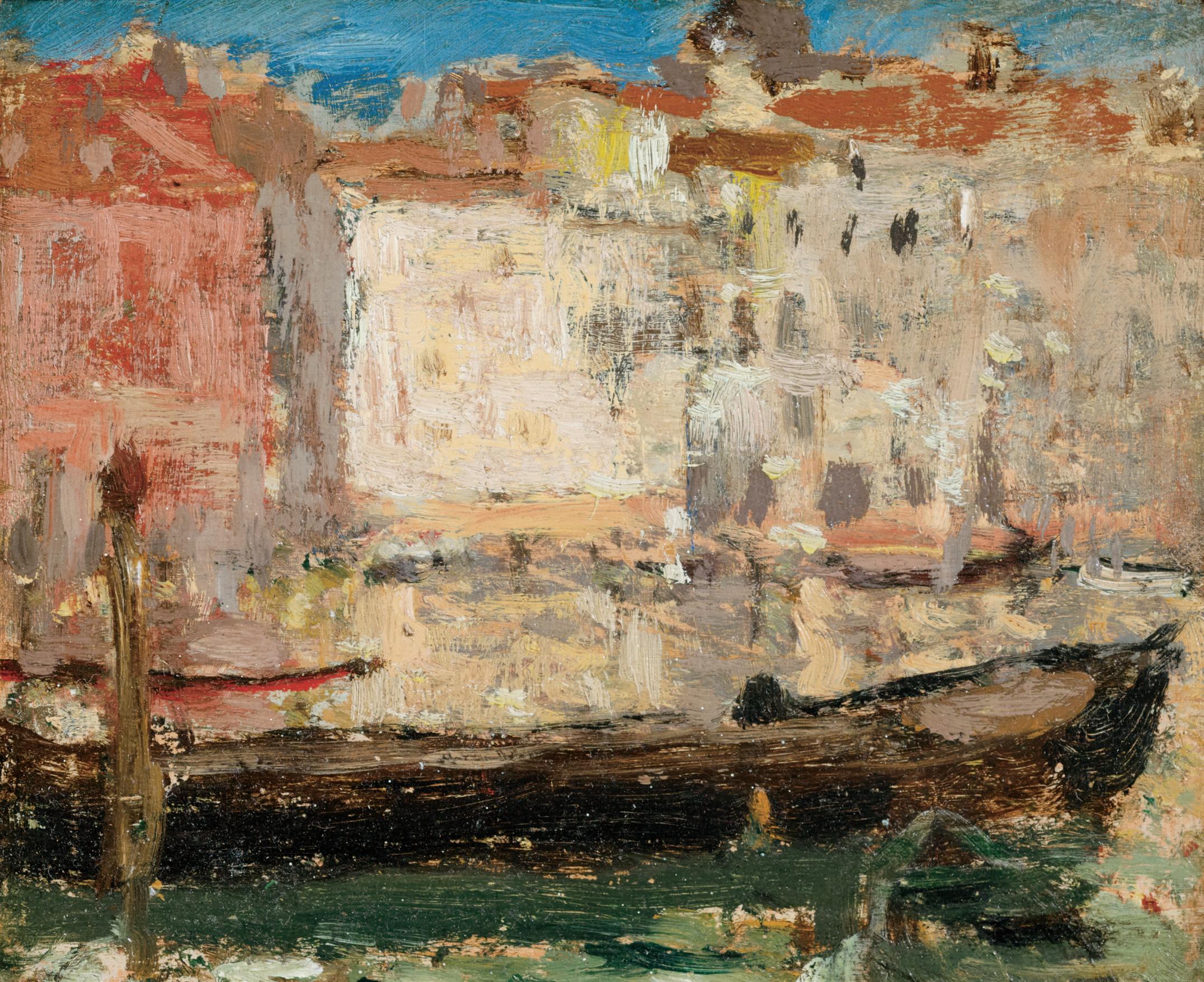
Morrice used the sketch only for the general colour scheme, if at all, and he did not keep it for long; it was not found in his Parisian studio after his death in Tunis–no studio stamp–and it is not signed, two facts suggesting a gift to a close friend. Nothing else is known about this lovely little painting until someone spotted it in the estate of a prominent citizen of Tampa around 2007. By that time it had become anonymous, but its high quality was not lost, and an astute observer identi ed it as preparatory to the Golden Venice canvas.
We
$50,000–$70,000
COWLEY ABBOTT | Live Auction - Spring 2024 25
extend our thanks to Lucie Dorais, Canadian art historian and author of J.W. Morrice (National Gallery of Canada, 1985), for contributing the preceding essay.
WILLIAM KURELEK
Free Ukrainian Mountaineers mixed media on board signed with monogram and dated 1968 lower right 40.25 ins x 42 ins; 102.2 cms x 106.7 cms
PROVENANCE
Isaacs Gallery, Toronto Mayberry Fine Art, Winnipeg Private Collection, Ontario
EXHIBITED
e Burning Barn: 16 Paintings by William Kurelek , Hart House Art Gallery, University of Toronto, 11-29 March 1969
LITERATURE
William Kurelek, “Development of Ethnic Consciousness in a Canadian Painter” in Wsevolod Isajiw, Identities: e Impact of Ethnicity on Canadian Society, Toronto, 1976, page 47
William Kurelek, e Burning Barn: 16 Paintings by William Kurelek , Toronto, 1969
A troupe of venturesome mountaineers at bottom right welcome us into a tranquil world with dance and music. ey delight on a slope overlooking a busy bucolic village, nestled next to a meandering river within a verdant valley within what likely represents the mountains and forests of the Carpathian region in western Ukraine. e summer’s hazy cerulean sky vaults the earthly paradise.
Kurelek himself did not actually set foot in Ukraine until 1971, two years after he completed this painting. He was born in Canada in 1927, east of Edmonton, and raised on a farm north of Winnipeg. His parents, relatives, and many of their friends had either arrived on the Prairies from Ukraine over the previous three decades or were the second-generation o spring of immigrants. Seeking greater stability and opportunity, they formed a close-knit community that nurtured the language and customs of their homeland. Kurelek’s devotion to his family’s Ukrainian heritage was also forged in opposition, as a response to the alienation he felt early in life toward the broader

Free
mixed
Art
on masonite, 76.2 x 137.6 cms
Gift of the Estate of George G. Sinclair, 1992
Not for sale with this lot
Anglo-Canadian culture. And, as a teenager during the Second World War, this patriotism was nurtured by a charismatic priest at his family’s Orthodox church, who “taught us the history of the Ukraine, with its brief moments of glory.” en, Kurelek “dreamed of doing great things for the cause of Ukrainian liberation,” idealizing “the Ukrainian countryside, people, and culture.”
Kurelek’s love for Ukraine and its people endured throughout his life. But what the artist describes as his “ethnic consciousness” became more nuanced following his conversion to Roman Catholicism in the late 1950s. In his mature art, devotion to “countryside, people, and culture” often shared centre stage with the lessons of his new faith. Indeed, Free Ukrainian Mountaineers, one of two versions that exist, is part of what Kurelek described as his “second socio-religious comment series,” entitled e Burning Barn. We witness more obvious social and religious commentary in paintings like Our World Today (Department of Foreign A airs, Ottawa) and Cross Section of Vinnitsia in the Ukraine, 1939 (Winnipeg Art Gallery), which hung alongside the other version of Free Ukrainian Mountaineers (Art Gallery of Hamilton) at the Hart House exhibition (University of Toronto) in March 1969.
e Burning Barn , which Kurelek had originally—and curiously— intended to title “Health,” was, in fact, his third exhibition to make explicit reference to societal and religious themes. However, whereas an unremitting sense of gloom predominated his previous e orts— Experiments in Didactic Art, 1963 and Glory to Man in the Highest, 1966— e Burning Barn struck a balanced tone. Paintings exploring social injustice and global turmoil were matched with those, like Free Ukrainian Mountaineers, expressing more positive themes of freedom, joy, and hope. e artist also “endeavoured to o set” criticism that his earlier pessimism did not match his Christian character “by painting most of the happy scenes larger than the unhappy ones.”
While seemingly pastoral and nostalgic, Free Ukrainian Mountaineers is also indelibly contemporary, a hopeful reminder amid the Cold War. Today, seeing this work in the context of the current Russian invasion of Ukraine should also remind us of the ways in which the atrocities of totalitarianism were being exposed, and increasingly resisted in that country by the end of the 1960s. Completed at a time when dissident activity was increasing in Eastern Bloc countries and broadening awareness to the true scope of Stalin’s legacy of terror in places like Ukraine, the painting is an exercise in de ant idealism. It o ered a beacon of hope, in Kurelek’s mind, for “the new ‘global village’ situation in which man nds himself,” a means to help develop “a measure of new collective conscience about this plight of his less fortunate fellow man abroad.”
We extend our thanks to Andrew Kear, Canadian art historian and Head of Collections, Exhibitions and Programs at Museum London for contributing the preceding essay. Andrew is the past Chief Curator and Curator of Canadian art at the Winnipeg Art Gallery, a Curator of the 2011/2012 national travelling exhibition William Kurelek: e Messenger and author of the Art Canada Institute’s William Kurelek: Life & Work , available at www.aci-iac.ca.
$30,000–$40,000
COWLEY ABBOTT | Live Auction - Spring 2024 26 18
William Kurelek
Ukrainian Mountaineers , 1968
media
Gallery of Hamilton

COWLEY ABBOTT | Live Auction - Spring 2024 27
TOM THOMSON
Spring, Algonquin Park
oil on board
artist estate stamp lower right; catalogue raisonné no. 1914.45
8.5 ins x 10.5 ins; 21.6 cms x 26.7 cms
PROVENANCE
Laing Galleries, Toronto, circa 1942-1943
e Rt. Hon. Malcolm MacDonald, Ottawa and Kent, England
Private Collection, Ottawa
Joyner/Waddingtons, auction, Toronto, 1 June 2004, lot 51
Private Collection, Vancouver
Private Collection
EXHIBITED
Tom omson (1877-1917), Annual Loan Exhibition , Galerie Eric Klinkho , Montreal, 5-19 November 2022, no. 14
LITERATURE
omson to F. H. Varley, 8 July 1914
Malcolm MacDonald conversation with Joan Murray, early 1970s
Joan Murray, "Tom omson's Letters" in Dennis Reid, Charles C. Hill, Tom omson, Vancouver/Toronto, 2002, page 298, the related work Canoe Lake, Mowat Lodge appears on page 183
Joan Murray, Tom omson Catalogue Raisonné, entry 1914.45, 2016, https://www.tomthomsoncatalogue.org/catalogue/entry.php?id=219 (accessed on 12 March 2024)
In Spring, Algonquin Park Tom omson evoked in paint the stunning vitality of a sunset sky, a swirling shape of mauves and blues that expands to the left into a huge curve with streaks of pale blue, orange and pale gold and ends in a nal explosion of colour where the sun has set behind turquoise hills. e overarching sunset sky is grounded by a partial view of omson’s ‘home base’ in Algonquin Park, the place in which he stayed, Mowat Lodge on the west shore of Canoe Lake, its shoreline and outlying structures, and the landscape beyond. omson touched the buildings with red where they caught the rays of the setting sun. It’s a mysterious, almost apocalyptic scene, one of his best, if not his best depiction of sunsets in Algonquin Park.
omson painted this work at a height slightly above and at a distance from the main building, a view he favoured though he must have been further away in a closely related work, Canoe Lake, Mowat Lodge, Summer 1914 (Tom omson Gallery, Owen Sound) which more clearly shows Mowat Lodge, its outbuildings and setting. Both sketches are con dent and powerful, proof that omson was happy in his surroundings in Algonquin Park and the daring experiments with colour, form, and structure he did there which would change the course of Canadian painting.
He painted these works in the summer of 1914. In the spring, summer and fall of that year, his work made a clear progression towards more vigorous brushwork and con dence in colour and form. at March, Moonlight, a major canvas had been bought by the National Gallery of Canada, which meant a huge boost to his self-assurance, as did his election to the Ontario Society of Artists the same month.
In late April he travelled from Toronto to Algonquin Park, where Arthur Lismer soon joined him for a camping trip. On the heels of dropping Lismer o to go home, omson went to Georgian Bay for two months to stay with his friend and patron, Dr. James MacCallum and his convivial family at their cottage on Go-Home Bay, but found the “all birthday cakes and water ice” atmosphere uncongenial to him.


Location
COWLEY ABBOTT | Live Auction - Spring 2024 28 19
Tom omson
Canoe Lake, Mowat Lodge , circa 1914 oil on plywood, 21.6 x 26.6 cms
Collection of the Tom omson Art Gallery Gift from an anonymous donor through the Ontario Heritage Trust, 1988 Not for sale with this lot
Tom omson
Split Rock Gap, Georgian Bay, Summer 1914 oil on plywood, 21.3 x 26.3 cms
unknown
catalogue raisonné no. 1914.35
Not for sale with this lot
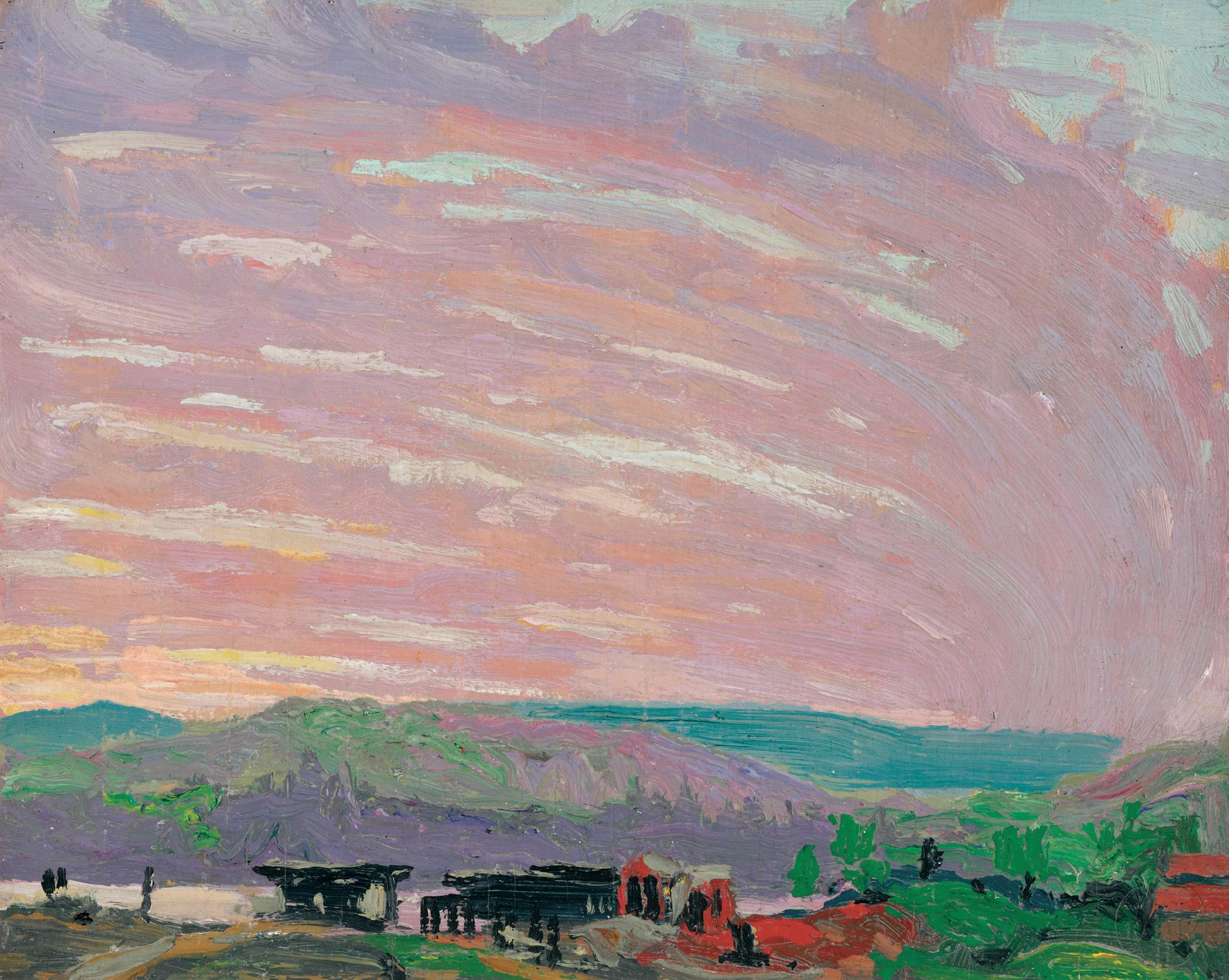
He returned in early August to “Camp Mowat” in Algonquin Park, likely with a feeling of relief, where he painted these works. ey were his way of telling himself ‘welcome back’ to the place where he felt happiest and his joy at returning shows in the sketches he painted.
He had begun painting skies early in his career and delighted in the soaring shapes of clouds when he journeyed to Georgian Bay, as seen in works such as Split Rock Gap, Georgian Bay (location unknown). at summer of 1914 he began to record sunsets and the colour of the sky at dawn and dusk, even swirling skies as in Hills and Swirling Sky (National Gallery of Canada). It was a feature which became an established part of his practice but rarely as brilliantly painted as in Spring, Algonquin Park
G. Blair Laing, the dealer who sold the work, titled the painting inaccurately on a label, as “Spring”. He sold it to the distinguished British politician, diplomat, and colonial administrator, the Rt. Hon. Malcolm MacDonald, who was High Commissioner to Canada from 1941 to 1946. MacDonald was also an important collector, particularly of artwork that re ected the culture of his postings. roughout MacDonald’s career, his passion was ceramics and today, e Malcolm MacDonald Collections are held by the
Oriental Museum at the University of Durham in England, as well as by other museums, such as the National University of Singapore Museum. But he was a collector of a variety of genres, and one artist he collected was Tom omson.
MacDonald loved omson’s work so much so that he owned four works by him: Spring, Algonquin Park, Missisagi (Private Collection); Twilight Woods (Private Collection, Winnipeg) and one other that he lost during a move in England (he thought the movers might have taken it). He remembered the work well and in the early 1970s described it to the curator at work on the catalogue raisonné of omson: “It had a ock of wild ducks in ight on their migration south in the sky,” he said, “and I’d like it back.”
We extend our thanks to Joan Murray, Canadian art historian, for contributing the preceding essay.
$700,000–$900,000
COWLEY ABBOTT | Live Auction - Spring 2024 29
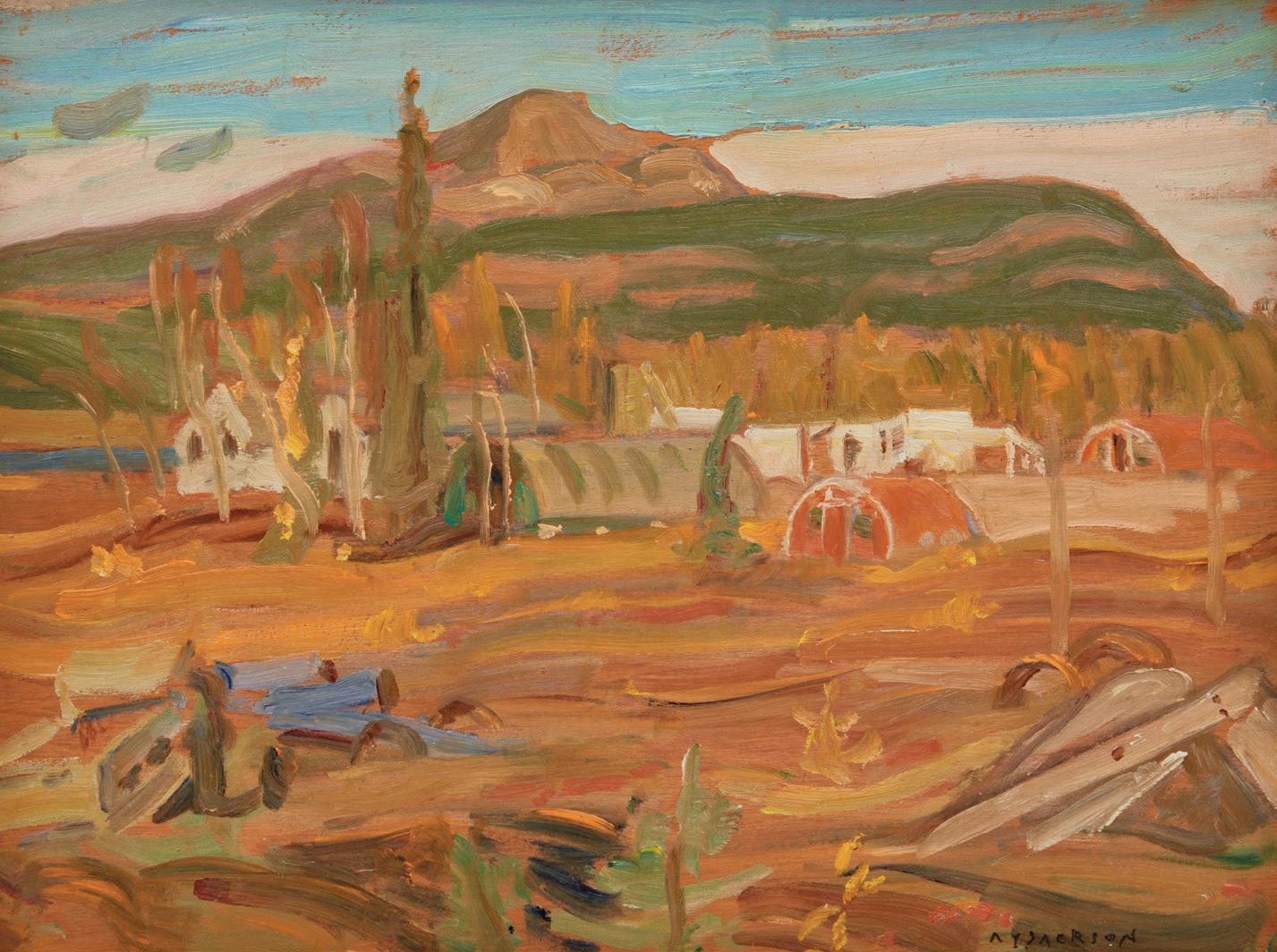

21
20
ALEXANDER YOUNG JACKSON
Camp at Bear River, N.W.T. oil on board signed lower right; titled and inscribed "no. 2879" on the reverse 10.5 ins x 13.5 ins; 26.7 cms x 34.3 cms
PROVENANCE
Purchased directly from the Artist, circa 1950
Private Collection, Montreal
Private Collection
$20,000–$30,000
ALFRED JOSEPH CASSON
Barry's Bay oil on board signed lower right; titled and dated 1968 on the reverse 9.25 ins x 11.25 ins; 23.5 cms x 28.6 cms
PROVENANCE
Private Collection, Toronto
LITERATURE
Hubert De Santana, "A Painter’s Life: A.J. Casson looks back on 60 years at the easel,” Canadian Art, Spring 1985, pages 64-69
A.J. Casson’s depictions of rural Ontario show his dedication to the inhabited areas of the province and set him apart from his fellow members of the Group of Seven. Although Casson’s pictures of towns and villages are rarely populated there is a sense of character and warmth present. e homes, stores and churches of the small communities are an inviting destination for the viewer. ese landscapes capture moments in time with a strong sense of vitality and personality.
Common to Casson’s work throughout his career is a limited colour palette, as demonstrated in Barry’s Bay by his use of light browns and earthy greens repeated throughout the buildings, eld and road. In a 1985 interview, the artist recalls this strategy as being present since his early days with the Group of Seven, when “exhibitions were aming with colour.” He elaborated by stating: “Well, I’ve always thought that if you want to stand out, don’t follow the herd. I was inclined to go into subtle greys, to get away from the gaudy. I painted a few gaudy ones, but they never appealed to me.”
$25,000–$35,000
COWLEY ABBOTT | Live Auction - Spring 2024 30
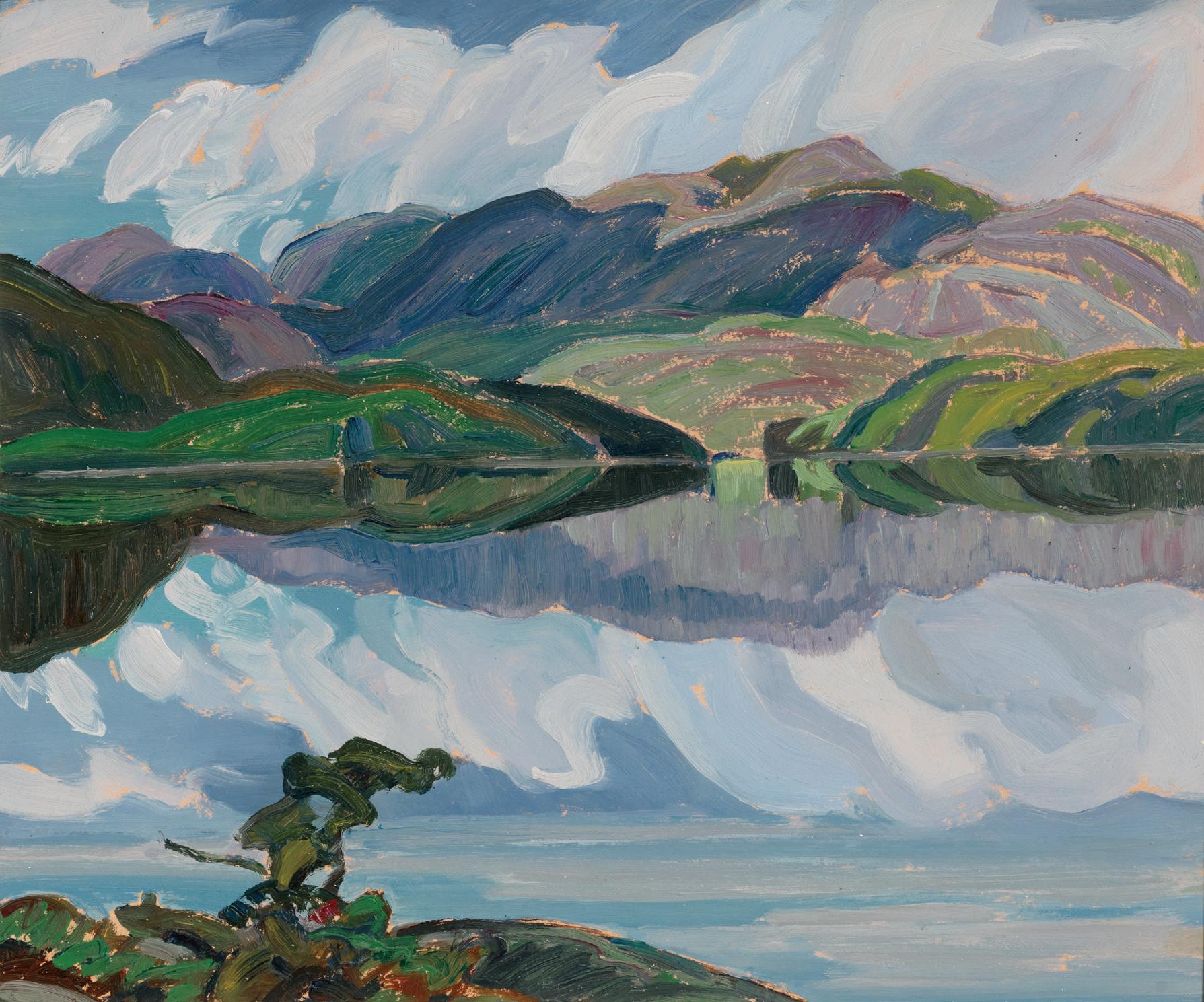
FRANKLIN CARMICHAEL
Refections, La Cloche Hills
oil on board
signed, dated 1936 and inscribed "original sketch by Franklin Carmichael, signed by his wife" with a signed stamp (dated Sept. 1971) by J. Russell Harper on the reverse
10 ins x 12 ins; 25.4 cms x 30.5 cms
PROVENANCE
Galerie d'art Michel Bigué, Montreal
A.K. Prakash & Associates, Inc., Toronto Private Collection, Toronto
EXHIBITED
Retrospective Exhibition of Painting by Members of the Group of Seven 1919-1933, National Gallery of Canada, Ottawa, 1936, no. 9
LITERATURE
Eric Brown, Retrospective Exhibition of Painting by Members of the Group of Seven 1919-1933, Ottawa, 1936, no. 9, listed page 9
Megan Bice, Light & Shadow: e Work of Franklin Carmichael, Kleinburg, 1990, page 43
roughout the Group of Seven period, Franklin Carmichael worked as a commercial artist, producing illustrations and designs rst at Grip Limited and subsequently at Rous and Mann. Following this, he accepted a teaching position at the Ontario College of Art, which allowed him to devote greater focus to painting. Carmichael's favoured regions for painting included Georgian Bay, the north shore of Lake Superior and the Mattawa area. Edward and Winifred Went, Carmichael’s brother and sister-in-law, rst encouraged the artist to visit the La Cloche region north of Georgian Bay in 1924. ough only one small watercolour survives from his rst trip to the area, Carmichael continued to return to La Cloche each year for the rest of his life.
e La Cloche Hills are in fact ancient mountains, which have eroded over time into owing, rolling hills compressed between the Pre-Cambrian Shield to the north and the Great Lakes to the south.
La Cloche gave Carmichael the chance to paint from high vantage points, a ording him grand views of the distinctive contoured hills, with their lakes and forests. With Re ections, La Cloche Hills, Carmichael instead opted for a low, lakeside perspective, with much of the view taken up by the re ection of the great hills in water.
Carmichael’s sketches of the period regularly featured dramatic skies and a clever emphasis on the interplay of light and shadow on the land. Curator and author Megan Bice noted, “ e quality of light in the La Cloche particularly intrigued him. He later said of its special qualities that it seemed that “the laws of light didn’t always apply,” and that “the light bounced around so very dramatically”.
$60,000–$80,000
COWLEY ABBOTT | Live Auction - Spring 2024 31
22
DAVID BROWN MILNE
Early Morning
oil on canvas
signed and dated 1928 upper right; titled and dated 1928 on the reverse; catalogue raisonné no. 207.109
12.75 ins x 16.25 ins; 32.4 cms x 41.3 cms
PROVENANCE
Collection of the Artist e Rt. Hon. Vincent Massey, Port Hope Mellors Gallery, Toronto
Private Collection
Blair Laing, Toronto
Private Collection, Florida
Master's Gallery, Calgary
Private Collection, Calgary
EXHIBITED
Exhibition of Paintings by David B. Milne, Mellors Galleries, Toronto, no. 21; travelling to James Wilson and Co., Ottawa, November–December 1935
LITERATURE
Exhibition of Paintings by David B. Milne, Mellors Galleries, Toronto, 1935, no. 21, page 2
David Silcox, Painting Place: e Life and Work of David B. Milne, 1996, page 179 listed as a masterpiece
David Milne Jr. and David P. Silcox, David B. Milne: Catalogue Raisonné of the Paintings, Volume 1: 1882–1928, Toronto, 1998, reproduced page 443, no. 207.109
e Milnes lived in Moose Lake and Lake Placid in the Adirondack Mountains of New York State from 1924-29. Milne was a highly accomplished artist in his mid-forties at this time, but he was not nancially secure. ey chose the Lake Placid area because it was a year-round vacation spot for the elite, a place where the Milnes could nd work. In part because he was short of both time and art materials, at this time Milne often painted intimate still lifes such as Early Morning
Modest only in scale, this is nonetheless an ambitious and masterly painting. Simple domestic belongings are arrayed on a black, re ective surface. A lamp, vase, and two containers stand in a line across the front. In the shallow background are two more items, a plate and a book. e mirroring of the four elements in the front is achieved with great simplicity yet is remarkably true for the eye. Milne was creating similar mirror e ects in landscapes of local lakes at this time. Here, the tall, transparent necks of the lamp and vase stretch the image upwards and also help us perceive depth as we see through them to the table beneath. Milne integrates all parts of his shallow space eloquently with the repeating orange vertical lines of one page of the open book, which is echoed on one side of the black vessel between the lamp and vase. Flecks of purple accomplish the same end. e painting is satisfying to a viewer’s gaze in its domestic familiarity, its e ortless complexity of form, and in its ultimately cerebral nature.
Does it surprise us to see a book open to an illustration of Flemish master Peter Paul Rubens’ famous Portrait of Susanna Lunden(?) ('Le Chapeau de Paille'), probably 1622-25, in the National Gallery, London, UK? In Milne’s still life, we cannot make out any of the notable qualities of this painting, but it is clearly identi able as this Rubens. Milne described Old Master techniques in a letter to his patron and friend James Clarke at about this time. And Milne was in Britain near the end of World War I, eventually painting for the War Records O ce. Did he see this painting in situ? Likely not, since the National Gallery was closed at the time. Either way, it is shown here in (now double) reproduction, the way so many 20th-century artists accessed the art of the past. Milne’s allusion to Rubens underlines the casual self-awareness and self-con dence of Early Morning. It is, of course, not a self-portrait, but it is a depiction of Milne’s formal and historical priorities and of his aspiration to paint meaningfully in the long European tradition.
Mark A. Cheetham has written extensively on Canadian artists, including Jack Chambers, Alex Colville, Robert Houle, and Camille Turner, most recently in the collection Unsettling Canadian Art History (2022). He is a freelance writer and curator and a professor of Art History at the University of Toronto.
$50,000–$70,000
COWLEY ABBOTT | Live Auction - Spring 2024 32 23

COWLEY ABBOTT | Live Auction - Spring 2024 33

24
JAMES WILSON MORRICE
Of Concarneau oil on panel
studio stamp and inscribed "Mrs. Turnbull" on the reverse 4.75 ins x 5.75 ins; 12.1 cms x 14.6 cms
PROVENANCE
William Scott & Sons, Montreal, 1924
Private Collection, before 1940
Private Collection, Montreal
By descent to a Private Collection, Montreal, before 1969
Christie's, auction, Montreal, 29 October 1969, lot 64 as O San Malo Joyner Fine Art, auction, Toronto, 24 November 1992, lot 103
Joyner Fine Art, auction, Toronto, 23 November 1993, lot 48
Empire, auction, Montreal, 28 May 1995, as O Saint-Malo Kaspar Gallery, Toronto, 1995
Private Collection, Toronto, 1996
LITERATURE
Michael Ballantyne, "$174,000 realized in local auction", Montreal Star, 30 October 1969, page 59 Globe & Mail, 25 May 1995, page A10 Toronto Star, 26 May 1995, page A4
J.W. Morrice is well-known for his small sketches, or pochades, of Paris and Venice; in both places, he rarely wandered away from the water. In Paris, where he lived from early 1890, he moved to an apartment overlooking the Seine as early as he could. When he ventured away, it was usually to seaside resorts or small towns, endless sources of new subjects. For years, dealers routinely entitled them “Brittany” or “St. Malo”, and the present sketch is no exception. It belongs to a whole series of similar small marines, hard to locate, and therefore date, because most o er no geographical clue.

J.W. Morrice
On the Shore at Concarneau , about 1909-1910 Sketchbook No. 15, fol. 21r graphite
MMFA, Gift of David R. Morrice
Photo: MMFA, Jean-Françoise Brière
Not for sale with this lot
ey are characterized by paint applied thinly on the wooden panel, a technique the artist adopted around 1904. Some are pure marines of sea and sky, but never without a sailboat; others have a few rocks in the foreground; in a third group, a man-made detail is a priceless clue: a green railing found in some of them spells “Dieppe”, Normandy, which Morrice visited several times over the years, including a busy working week in June 1906. As Paris was unusually hot that summer, he went to Brittany, going around it following the seashore; he passed through Morlaix in the northwest and Quimper in the southwest, ending up in Le Pouldu, past Concarneau.
Created after 1906, Morrice shares his enjoyment of this marine view on a sunny day; on the right, the schooner bobbing on the water adds to the joyous atmosphere.
e thinner paint application is also found in many pochades painted in Concarneau between mid-November 1909 and mid-April 1910. Actually, one drawing from the Concarneau Sketchbook (#15, MMFA, page 21) is almost a mirror image of the present sketch. Based on this, one can assume this sketch was also painted near Concarneau during that long stay.
We extend our thanks to Lucie Dorais, Canadian art historian and author of J.W. Morrice (National Gallery of Canada, 1985), for contributing the preceding essay.
$30,000–$40,000
COWLEY ABBOTT | Live Auction - Spring 2024 34
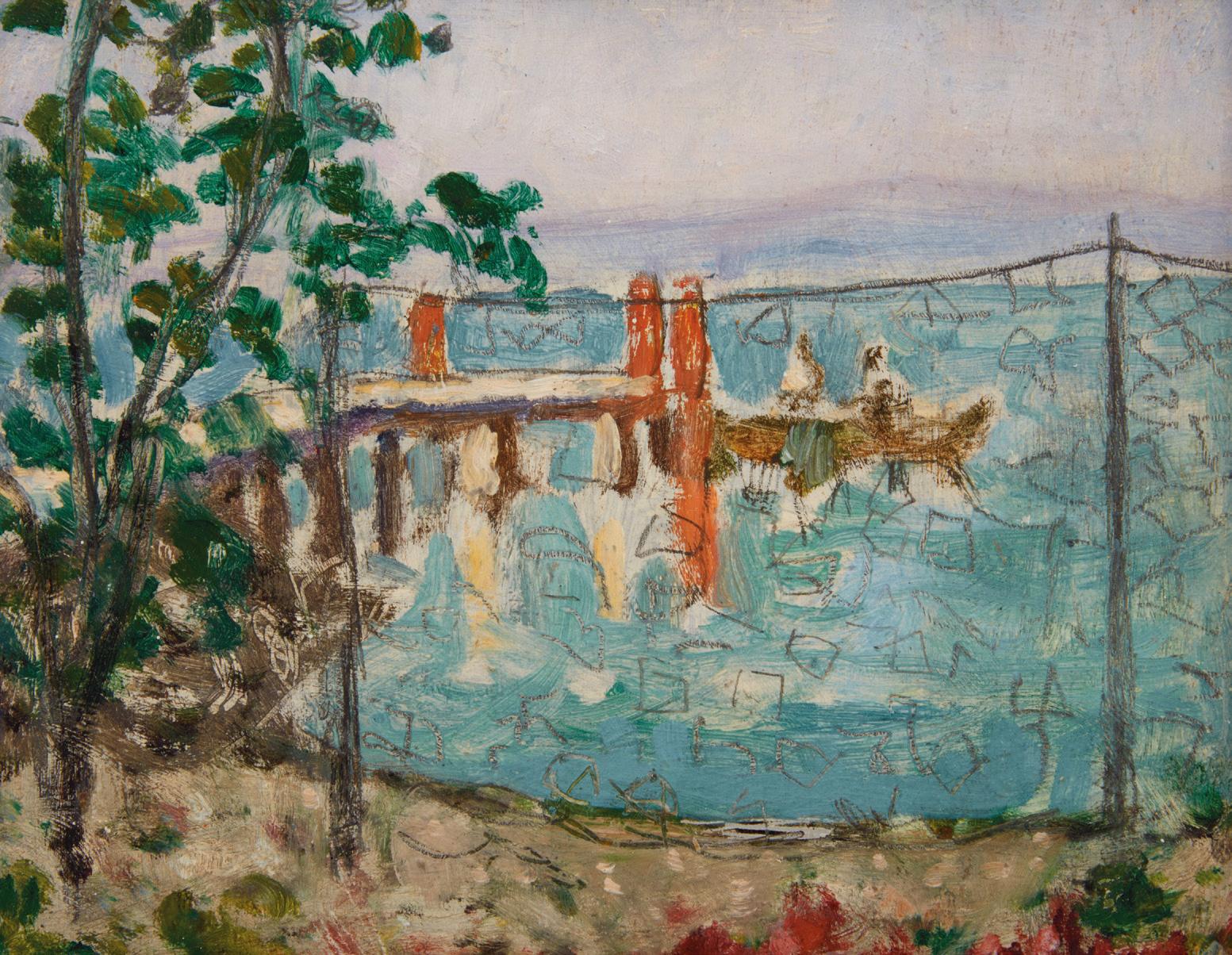
JAMES WILSON MORRICE
Fishnet and Pier, Santiago de Cuba oil and graphite on board studio stamp and inscribed "R.B. Morrice", "No E. pat", "325", "3" and part of a graphic stamp on the reverse 5.25 ins x 6.5 ins; 13.3 cms x 16.5 cms
PROVENANCE
William Scott & Sons, Montreal, 1924
Robert B. Morrice (brother of artist), before 1942 Stevens Art Gallery, Montreal, October 1943 Kaspar Gallery, Toronto, circa 1997 Private Collection, Ottawa Private Collection, Toronto
EXHIBITED
J.W. Morrice, Stevens Art Gallery, Montreal, October 1943
LITERATURE
"Paintings by Morrice at Stevens Gallery", e Gazette, 16 October 1943
e turquoise water in this sketch immediately evokes the Caribbean Sea, a region that Morrice visited at least twice, but such a frank piece of turquoise water is, so far, unique. e sketches and drawings done in Cuba and Jamaica in the Spring of 1915 do not show any water. Still mourning the recent loss of his parents, the artist focused his attention on the urban aspects of the island, coloured houses or public parks, always with little gures of local people. In Trinidad, in the spring of 1921, he brought only his watercolour kit.
is lovely little sketch is a delightful surprise, especially the delicate shnet entirely drawn in pencil on the top of the wet paint, as if the artist had wished to attenuate the blinding e ect of his bright colour. e panel had no title; after looking at images of Cuba, old and new, the search was narrowed to the area of Santiago, which Morrice visited. If many pages of his Sketchbook #10 (MMFA) depict Santiago, none relates to this particular sketch. Fortunately, old postcards and recent photographs are very helpful.
But the de nitive proof of the subject came when the back of the sketch was examined: unlike almost all known pochades painted by Morrice after 1894-95, it is not painted on a wood panel, but on a heavy piece of berboard; two items were mechanically printed with the same ink: a big digit “3" and, at bottom left, something that was hard to decipher. ere is another mysterious stamp on a berboard panel, a study for the MMFA canvas Cirque, Santiago de Cuba (Private Collection). When the images of the two backs are put side by side, the partial stamp on one panel perfectly completes the other, revealing the well-known mark of the famous Parisian rm of Lefranc & Cie, marchands de couleurs. By the beginning of the twentieth century, it had branches in many countries, including Cuba, and it still operates worldwide as Lefranc & Bourgeois. e dimensions of the resulting full panel correspond roughly to a “No. 3 Marine” standard format. We presume that Morrice had run out of wood panels: at least one sketch, House in Santiago (MMFA), has a view of a local park on the back. e large Lefranc berboard panel, cut in two, gave him two panels in his preferred size, which he used for two totally unrelated subjects, but in the same location.
We extend our thanks to Lucie Dorais, Canadian art historian and author of J.W. Morrice (National Gallery of Canada, 1985), for contributing the preceding essay.
$40,000–$50,000
COWLEY ABBOTT | Live Auction - Spring 2024 35 25
MARCELLE FERRON
Sans titre oil on canvas signed and dated 1961 lower left 32 ins x 39.25 ins; 81.3 cms x 99.7 cms
PROVENANCE
Private Collection, Toronto
e artwork Sans titre from 1961 beautifully showcases Marcelle Ferron's renowned abstract expressionist style, which has made her a prominent gure in the art scenes of Quebec and France. Her talent and artistic vision are particularly celebrated in 2024, marking the one-hundredth anniversary of her birth. An active member of the avant-garde group Les Automatistes, Ferron was a signatory to the 1948 Refus global (“Global Refusal”). is manifesto was a call to unfetter artistic and cultural expression in the province and the document of the tumultuous late 1940s cultural ferment in Quebec.
In Paris from 1953-1966, Ferron moved away from the Surrealist patterns central to Les Automatistes to develop immediately recognizable paintings such as Sans titre. Grounded in her expressive facility with paint, Ferron’s strong gestures with the palette knife suggest the physical labour of the hand and arm and thus her full
involvement in the painting. Dramatically yet without violence, forms tear into and across one another. We see this e ect in the red, brown, and white form in the bottom centre. Her pigment is often thick, creating a topography of forms that we note especially in the corners of this canvas. If we add her propensity for high-keyed colour, as a whole Sans titre presents a collection of puzzle pieces in motion. We know and appreciate that they will not nd stasis in a conventional picture but instead generate in nite transmutations before our eyes.
Ferron is also known for her public artworks. As well as imbibing international painterly techniques in Paris, she was inspired by French glass artist Michel Blum and brought his innovations back to Montreal. Ferron’s large and colourful stained glass installations were part of the International Trade Centre at Expo 67, for example, and can be enjoyed today in the Champ-de-Mars metro station in Montreal (installed in 1968). Di erent in medium and scale, there is nonetheless a bond between Ferron’s paintings and her public stained glass installations. Her abstract art is a way of life rather than a choice of style.
Mark A. Cheetham has written extensively on Canadian artists, including Jack Chambers, Alex Colville, Robert Houle, and Camille Turner, most recently in the collection Unsettling Canadian Art History (2022). He is a freelance writer and curator and a professor of Art History at the University of Toronto.
$120,000–$150,000
COWLEY ABBOTT | Live Auction - Spring 2024 36 26
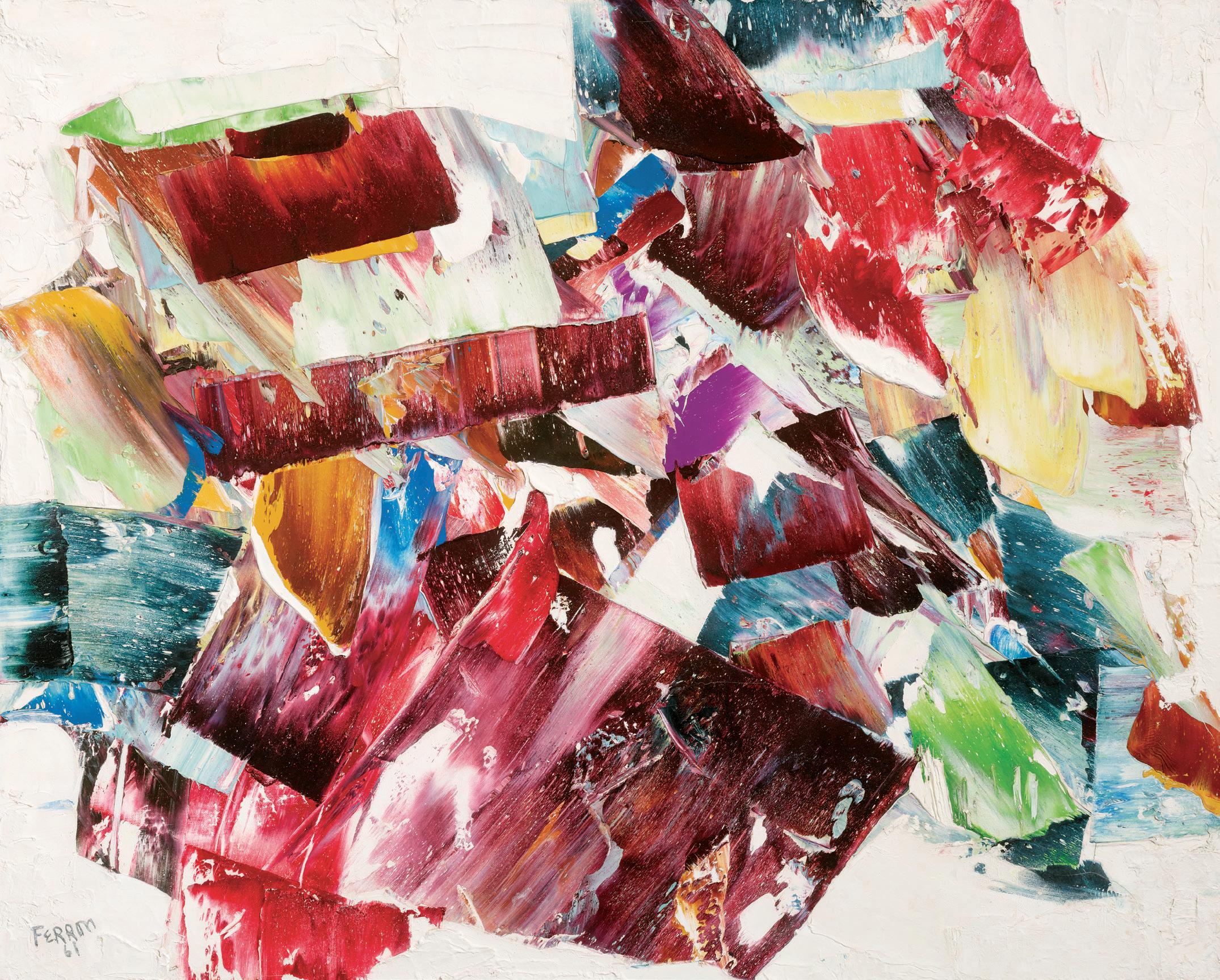
COWLEY ABBOTT | Live Auction - Spring 2024 37
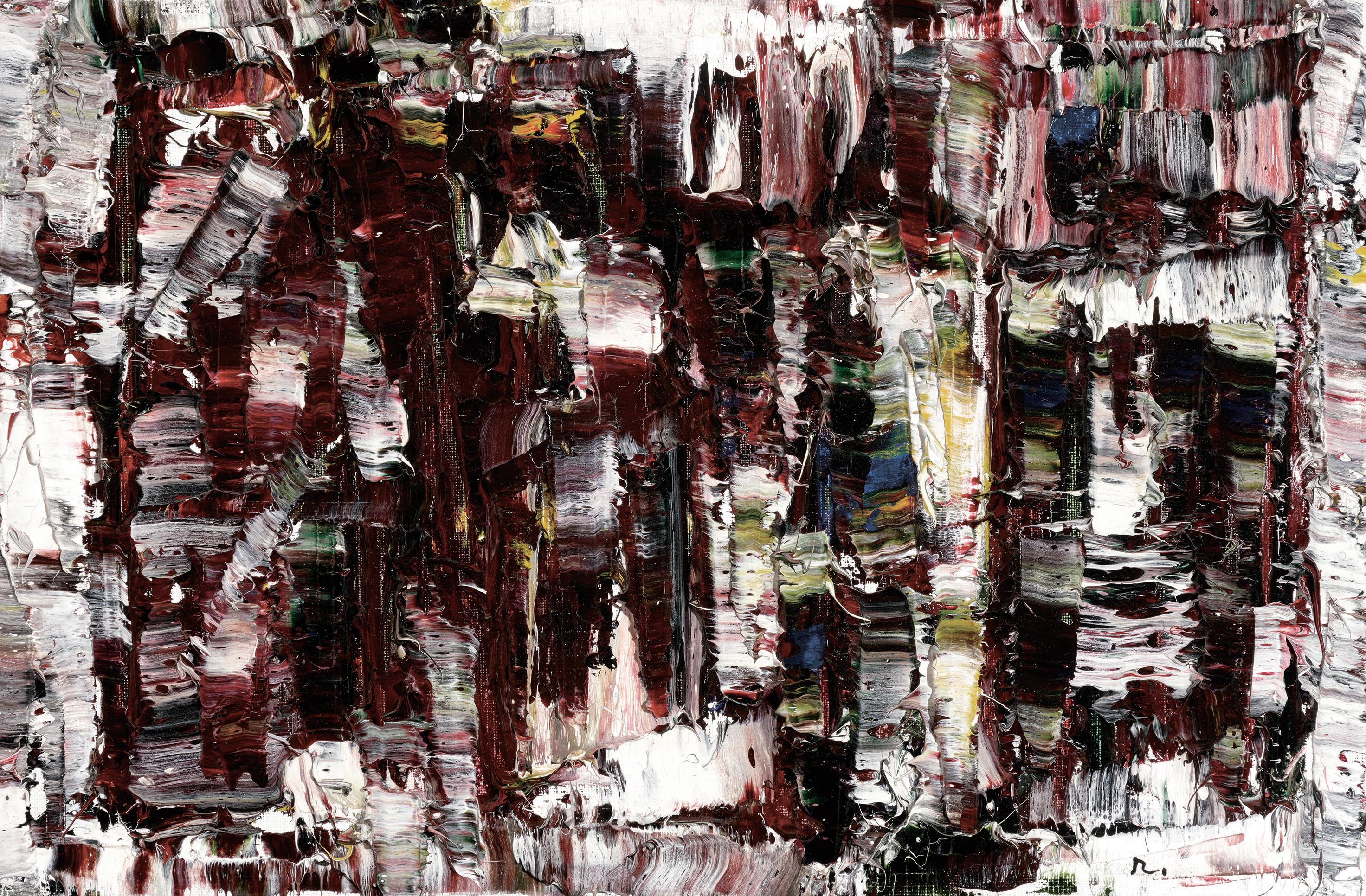
JEAN PAUL RIOPELLE
Sans titre, 1978
oil on canvas
signed with initial lower right; signed on the reverse ; catalogue raisonné no. 1978.083H.1978
10.5 ins x 16.25 ins; 26.7 cms x 41.3 cms
PROVENANCE
Pierre Matisse Gallery, New York Acquavella Modern Art, New York
Galerie Simon Blais, Montreal
Galerie Eric Klinkho , Montreal Private Collection, Montreal
LITERATURE
Yseult Riopelle, Tanguy Riopelle, Jean Paul Riopelle: Catalogue Raisonné, Tome 5, 1972-1979, Montreal, 2020, reproduced page 270, no. 1978.083H.1978
Jean Paul Riopelle’s works are both expressive and formal, responding to the art historical and socio-political environment of the post-war era, unique from his abstract-expressionist peers. After spending the majority of his career in France, in 1969 the artist was made a Companion of the Order of Canada, and began to spend more time in his native Quebec. In 1974, at the suggestion of Champlain Charest, a Québecois radiologist and art collector, whom he befriended in France, Riopelle set up a studio in the Quebec Laurentians. He had become familiar with the area from hunting and shing trips over the years with Charest. Riopelle designed the studio and living space in SainteMarguerite, according to plans he had once drawn up at the École du meuble: a spacious loft able to accommodate his large paintings, allowing him to work in isolation.
From the year 1974, Riopelle would split his time between Saint–Cyr–en–Arthies, France and his new home and studio in St. Marguerite, Quebec. is painting dates to this same year of transition for the artist. During this time, Riopelle and Charest embarked on many excursions throughout the Laurentians and northern Quebec that would inspire his paintings. By the 1970s Riopelle was producing both abstract and representational paintings, which was confusing to critics at the time. Riopelle defended his approach by remarking that all of his paintings are essentially based in nature. San titre is lled with layers of his quintessential palette knife strokes of predominantly burgundy, white and black; upon closer inspection, we can see that these strokes contain a multitude of colours.
$90,000–$120,000
COWLEY ABBOTT | Live Auction - Spring 2024 38 27
JEAN PAUL RIOPELLE
Nouvelles impressions no. 82 oil on canvas
initialed lower right; signed on the reverse; catalogue raisonné no. 1977.066H.1977
6.5 ins x 9.5 ins; 16.5 cms x 24.1 cms
PROVENANCE
Galerie Maeght, Paris
Galerie Simon Blais, Montreal Private Collection, Montreal
LITERATURE
Roald Nasgaard, Abstract Painting in Canada , Vancouver/ Toronto, 2007, page 82
Yseult Riopelle, Tanguy Riopelle, Jean Paul Riopelle: Catalogue Raisonné, Tome 5, 1972-1979, Montreal, 2020, reproduced page 233, no. 1977.066H.1977
As one of the foremost postwar abstract impressionists, Jean Paul Riopelle’s work after 1950 rejected the formalism of Cubism and Paul Cézanne to adopt instead the seamless colours of Claude Monet. As the artist describes: “My idea is not abstraction but much more how I get there via a free gesture (an autonomous brushstroke)... to understand what
29
JEAN-PHILIPPE DALLAIRE
Exotic Village oil on canvas
signed lower left; signed, titled, dated 1964 and inscribed
“Vence A.M. France” on the reverse 23.5 ins x 28.5 ins; 59.7 cms x 72.4 cms
PROVENANCE
Dominion Gallery, Montreal
Galerie Claude La tte, Montreal Private Collection
Jean-Phillipe Dallaire travelled to Paris to continue his studies in 1938, encountering the work of Pablo Picasso, Salvador Dalí, and Joan Miró. Dallaire returned to Canada following the Second World War, and incorporated the in uences of Surrealism, Cubism and mythological themes into his art. A highly idiosyncratic painter, Dallaire experimented ceaselessly, pushing his original style in new directions. Painted in the last year or so of the artist’s tragically short life, Exotic Village pulsates with shadowy dabs that play across the bright colour palette. e fanciful and simpli ed line work is reminiscent of the art of Paul Klee. An uncanny array of forms include a surreal gure,

nature is, and so not to start from deconstructing nature but to go in the direction of constructing the world”. Here thick brushstrokes of purples, blues, blacks and greens are juxtaposed across the surface of the canvas. Small and dense applications of paint are scattered around the periphery, framing the long, sweeping strokes of purple that dominate the centre of the composition. is work exempli es the dynamism and vibrancy for which Riopelle has become critically acclaimed. $30,000–$50,000
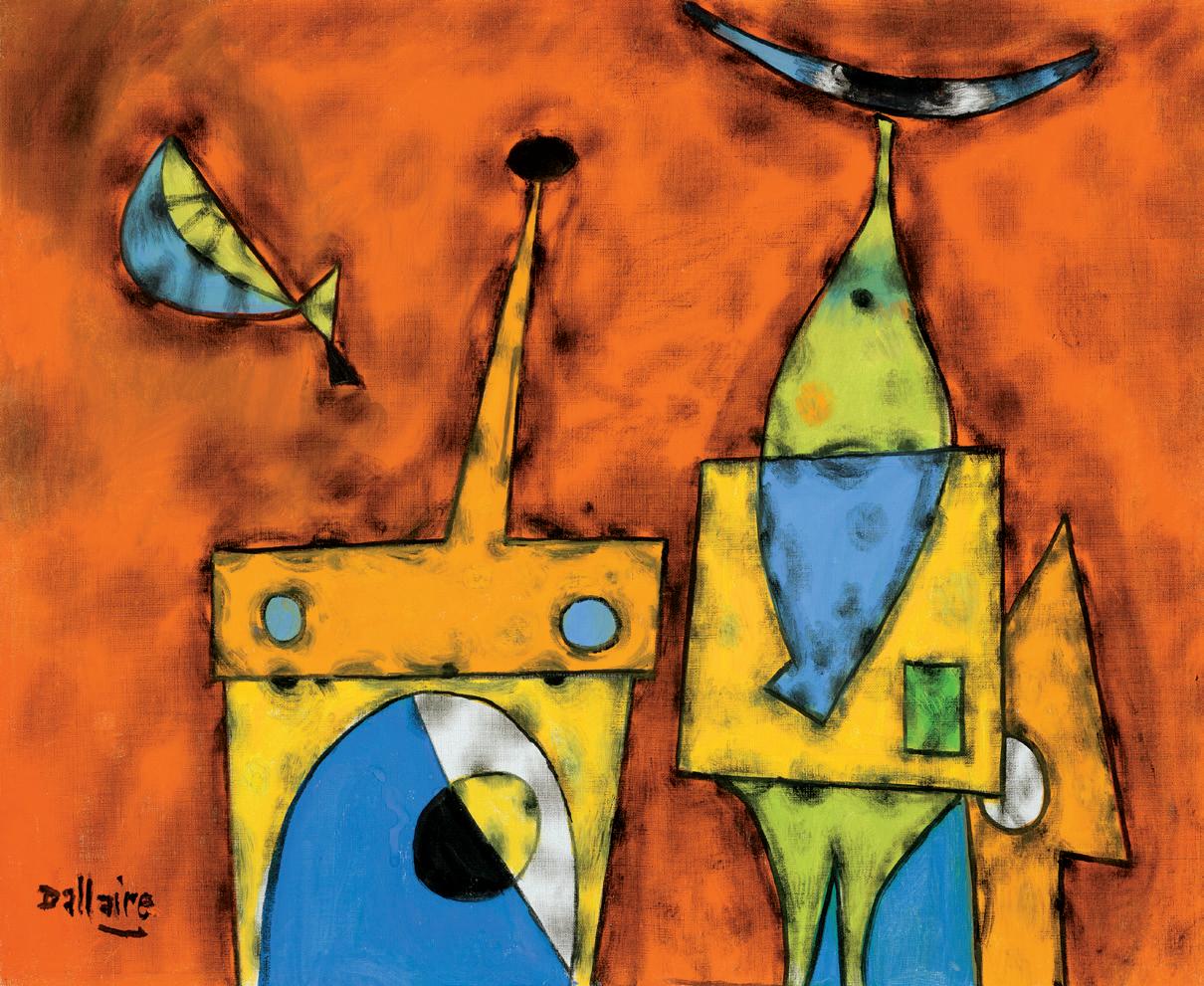
strange machinery and a sh-like shape taking startling ight. Dreamlike and playful, these lively, biomorphic forms seem to be drawn from the un ltered subconscious of the artist.
$25,000–$35,000
COWLEY ABBOTT | Live Auction - Spring 2024 39
28
LAWREN STEWART HARRIS
Untitled (Abstract Painting #173), circa 1958 oil on canvas numbered 173 upon the "Lawren Harris LSH Holdings Ltd." stamp on the reverse and inscribed (twice) "F106" 65 ins x 42 ins; 165.1 cms x 106.7 cms
PROVENANCE
Estate of the Artist
LSH Holdings Limited, Vancouver Mira Godard Gallery, Toronto Private Collection, Ontario
EXHIBITED
Lawren Harris Retrospective Exhibiton , National Gallery of Canada, Ottawa; travelling to Vancouver Art Gallery, 7 June-8 September, 1963, no. 68 as "1958-62"
Canadian Group of Painters, Art Gallery of Toronto; travelling to the National Gallery of Canada, Ottawa, 10 November-9 December, 1962, no. 12
Atma Buddhi Manas: e Later Work of Lawren S. Harris, Art Gallery of Ontario, Toronto; travelling to the Vancouver Art Gallery; Winnipeg Art Gallery and Art Gallery of Nova Scotia, Halifax, 27 September 1985-13 July 1986, no. 76
LITERATURE
Lawren Harris, “Creative Art and Canada,” Yearbook, of the Arts in Canada, 1928-1929, Toronto, 1929, page 85
Bess Harris and R.G.P. Colgrove (ed.), Lawren Harris, Toronto, 1969, pages 18 and 109
Dennis Reid, Atma Buddhi Manas: e Later Work of Lawren S. Harris, Toronto, 1985, no. 76, reproduced page 99
Roald Nasgaard, Abstract Painting in Canada , Vancouver/Toronto, 2008, page 37, reproduced page 36
Paul Duval, Lawren Harris: Where the Universe Sings, Toronto, 2011, page 23
James King, e Life of Lawren Harris: Inward Journey, Toronto, 2012, pages 99 and 309
Roald Nasgaard, “Harris’s Modernity,” in Higher States: Lawren Harris and his American Contemporaries, Kleinburg, 2017, page 97
I hadn’t seen the generically titled Untitled (Abstract Painting #173) for some twenty years except in reproduction, so it was a delight to rediscover how dazzling it is in real life. And dazzling it is with its palette of gorgeous colours-rust red, lemon yellows and oranges, its tans and browns, and its azures–and its crisp drawing that darts about, sometimes with lightning speed. It’s abstract, of course, at least in the sense that it doesn’t depict worldly things. But it’s also a gureground painting, with a kind of construction rising in the middle of its composition and set against a dappled blue ground that may be read as light glistening o the waves of the ocean, or as a wispily clouded sky. Or maybe it’s just abstract.
But what is that image-thing in the middle? It’s a powerful presence, free and spirited. But it is also more than a little weird. It’s full of vitality, but it’s not really organic. e drawing is more geometric than biomorphic. It’s not at nor in the round, but more like a kind of crazed relief. It’s amorphous, sprawling outside its edges, but at the same time it holds itself tight. Here it’s gaseous, and there hard-edged.
But for all purposes, it is weightless. It’s nally not a body but a vision revealed to us only for that xed moment when the camera shutter button is pressed. Before and beyond, it is eternally uid and dynamic.
If we ask “what does this all mean?” Harris warned us against interpretation, at least in any literary way. at’s the wrong question, he insisted, when in 1948, some ten years earlier, he talked to the art historian Paul Duval. e right question to ask, as Harris admonished, is rather “What experience does it contain?” A work of art is not a text to be read, but “a state of mind” that can “only be participated in, or experienced.” What resonance within our minds and bodies can this particular abstract con guration of colour and form arouse?
So what can we say about Harris’s use of abstraction in #173, about his commitment to gure-ground relations and spatial illusion? When he executed #173 at the end of the 1950s, abstraction on the larger North American stage saw the emergence of Colour Field painting which emphatically proscribed the depiction of space and emphasized painting’s obligation to a rm the atness of its canvas support. is was the direction that in Toronto, the two-decades-plus younger Jack Bush was then taking. And Colour Field painting, as it was being promoted, if sometimes dogmatically, by the critic Clement Greenberg, was understood to be the next inevitable step in the Modernist abstract art’s trajectory that ran its evolutionary line from Impressionism, through Cézanne, Cubism, Mondrian, Abstract Expressionism and forwards. But powerful as this narrative was for a time, it was also incomplete and exclusionary, and only one of the other possible storylines about the development of abstraction. It was also essentially a secular story, whereas when Harris pursued his own path of discovery and made his particular formal choices, central to his quest was a search for transcendent expressiveness.

COWLEY ABBOTT | Live Auction - Spring 2024 40 30
Arthur Lismer July the 4th Dimension , circa 1938 conté on paper, 18.7 × 16.9 cms Arts and Letters Club of Toronto Archives Not for sale with this lot
Harris may not in his own work have fully tackled abstraction until the mid-1930s. But already as early as the mid-1920s, he had become Toronto’s leading promoter of abstract art. He played a key role in 1927, bringing to the Art Gallery of Toronto the International Exhibition of Modern Art, an exhibition organized by the Société Anonyme in New York for the Brooklyn Museum, and devoted to the newest abstract art in all its international manifestations. Harris’s review of the Art Gallery of Toronto exhibition in the Journal Canadian Forum included a reproduction of a recent Mondrian painting. And both before and in the wake of the exhibition, Harris was at the centre of local discussions about abstraction and its critical, theoretical, and spiritual implications for the Canadian context. In an essay in the Yearbook of the Arts in Canada, 1928-1916 he even seemed to foresee how all this could be translated into action: “To-day,” he writes, “the artist moves toward purer creative expression, wherein he changes the outward aspect of nature, alters colours, and, by changing and re-shaping forms, intensi es the austerity and beauty of formal relationships.” In so doing, “he comes appreciably nearer a pure work of art and the expression of new spiritual values.”
So intellectually, Harris had done his critical homework. But how, in practice, to make abstraction his own was another problem, especially given his profound commitment, which he shared with his Group of Seven fellows, to a nationalist program devoted to depicting the northern landscape. As late as 1930 he wrote to Emily Carr about this after a trip across the Atlantic explaining how, while abstract painting is now “somewhat natural to Europe,” we in Canada still cannot do without representation “because it provides a home for the spirit — and we sensed the spirit rst and always through the life and forms of nature.”
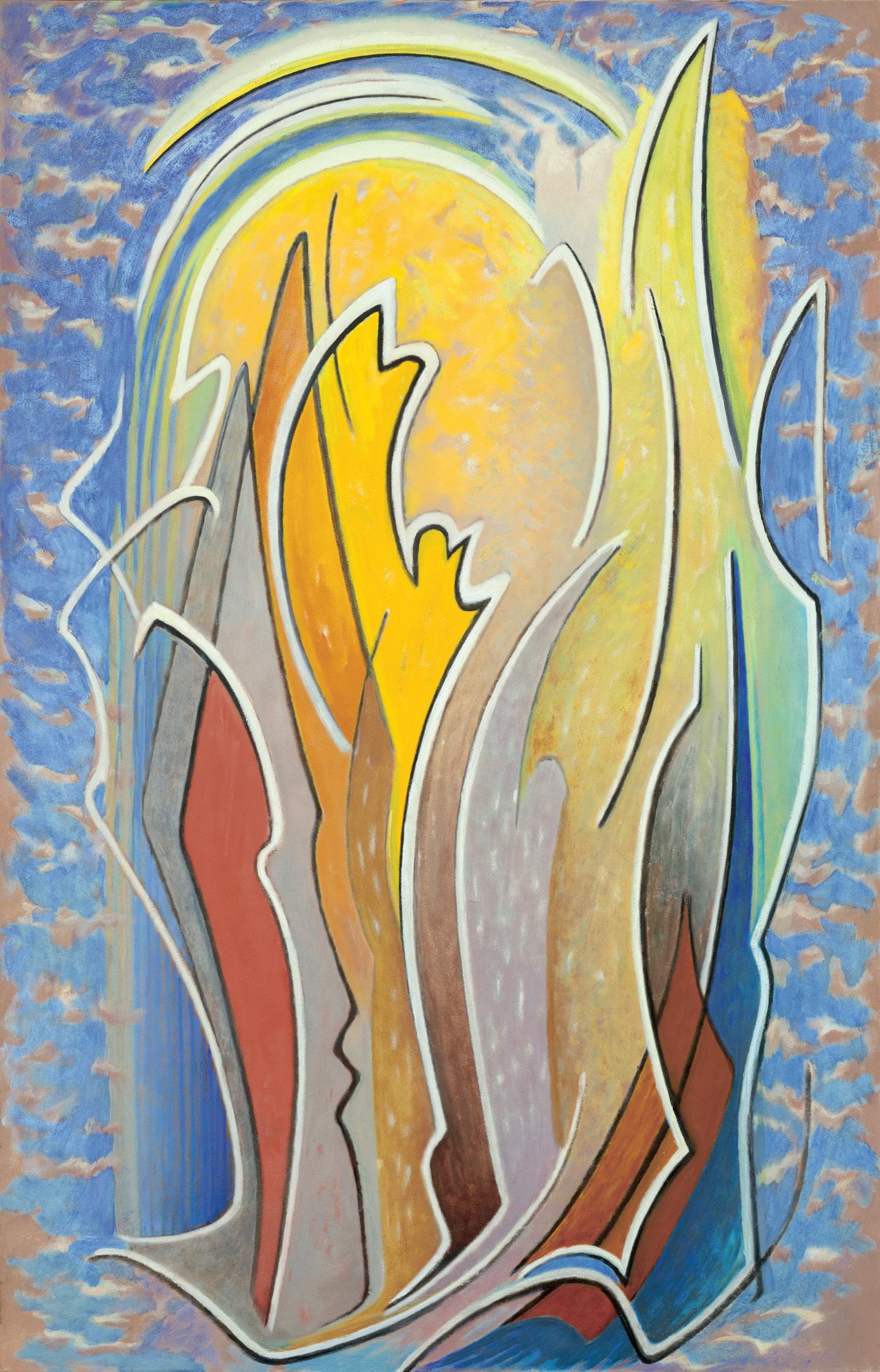
COWLEY ABBOTT | Live Auction - Spring 2024 41
Such nationalistic constraints fell away when, due to social indiscretions, he was forced to leave Toronto in 1934, moving to Hanover, New Hampshire, where he assumed a position of artist-inresidence at Dartmouth College. e school library was thoroughly up-to-date on modern art, with portfolios of Kandinsky prints, and Hanover was in easy reach of New York where he saw essentially every major exhibition at MoMA and the Whitney Museum and at the major commercial galleries in New York, exhibitions that would have included a great deal of geometric abstraction.
Harris’s own rst ventures into abstract paintings had their own visionary quirkiness and would little resemble what he saw in New York. It was more a matter of nding his own way on his own terms. But even so, of the major options available, it would be Wassily Kandinsky, rather than Piet Mondrian, who became his more useful model. Given Harris’s own eosophical bent, both could have appealed because that was how philosophically both Europeans explained their work. But whereas Mondrian insisted on pure geometry and resolute atness, Kandinsky kept a more uid attitude to pictorial space and inhabited his paintings with shapes and colours resonant with symbolic intent; i.e., consonant with the pictorial mode that will govern Harris’s work up to and including #173. Opting for Kandinsky’s way made Harris a sympathetic t in Santa Fe, where he moved in 1938, and was central to his becoming a founding member of the Transcendental Painting Group.
eosophy and other transcendental literature had been central to Harris’s creative milieu since Toronto days in the 1920s in the company of such pioneer explorers of abstract art as Bertram Brooker and Kathleen Munn. Lasting visual in uence came from Annie Besant and C.W. Leadbeater’s ought Forms, 1905, in which the authors sought to illustrate their mystical visions of individual composers’ music depicting them as colourful, cloud-like emanations that emerge from the towers of gothic country churches to unfold splendidly up in the sky. A great number of Harris’s Santa Fe paintings harken back to these ought Forms illustrations, but his interest in them had surfaced even earlier, in discussions back at the Arts and Letters Club in Toronto, where they were, on occasion, the subject of mirth. A cartoon by Arthur Lismer, July the 4th Dimension , probably made around the time of Harris’s departure for Hanover, shows Harris performing a celebratory dance in the presence of a Fourth of July reworks display made up of a riot of stars, triangles, and numbers. Lismer’s drawing is blatantly a spoof of a Besant “thought form” image, in this case of Charles Gounod’s music, Lismer launching his upwards from an Eastern mosque rather than a Gothic church, no doubt to quip on eosophy’s interest in eastern religions.
And thus we have it, the underlying format of Harris’s highly ambitious paintings of the late 1930s and forwards, through to #173 in the late 1950s: eosophical “thought forms” hovering over or against boundless land, sea or skyscapes. In Santa Fe they rise up like enigmatic heraldic constructions built with ambiguously emblematic shape and volumes. ey are designed geometrically with industrial precision and animated with Art Deco speed lines and bright discs that ash like tra c lights. ey are high-spirited and moderne, and unlike the work of some of his Transcendentalist fellows, clear-eyed and unsullied by sentiment.
Harris returned to Canada in 1939 and settled in Vancouver. e city had its own strong eosophical and mystical history and the painter Jock Macdonald, who had arrived from Scotland in 1926, was well versed in Kandinsky, voicing the latter’s contention that
colour harmonies could be constructed on their own terms without needing to copy nature. Macdonald was no doubt also instrumental in introducing Harris to Surrealist automatic writing, a technique which he learned to practice without feeling any compulsion to modify his spontaneously produced drawings into de ned shapes or readable imagery.
is is the formal realm of #173, with the deep space of the Santa Fe paintings diminished and the symbolic imagery foregone. What rules instead is a fast and jagged drawing style and high-keyed colours that resonate independently of form, all unavailable to textual analysis: a celebratory envisaging of an ethereal insight some transcendent universe. Even so, may we not intuit reminiscences of Harris the longago landscape painter? e sea and the sky? Dazzling sunlight and deep blue darkness, fall colours and light snow? As Harris strives to be otherworldly and to use his art for spiritual revelation, he does not address us from a space of mystical darkness, but wants us to partake open-eyed in the clear light of day.
We extend our thanks to Roald Nasgaard for contributing the preceding essay. Roald is the author of the critically acclaimed Abstract Painting in Canada . His exhibitions and accompanying books dedicated to Canadian abstraction include Yves Gaucher: A Fifteen-Year Perspective 1963-1978, e Automatiste Revolution: Montreal 1941–1960 and e Plasticiens and Beyond: Montreal 1955–1970
$300,000–$400,000
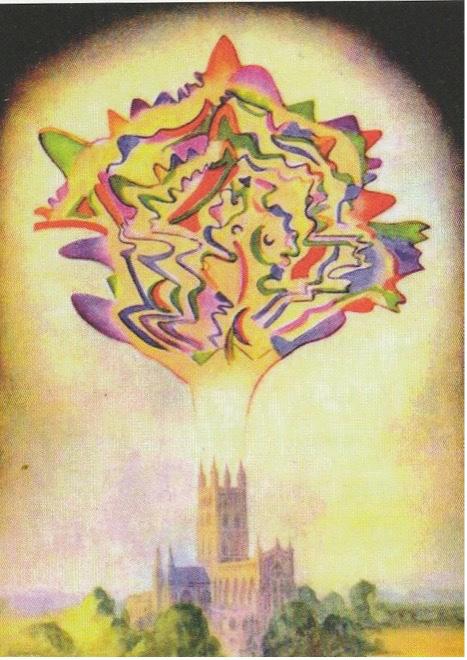
Annie Besant (British, 1847-1933), C.W. Leadbeater (British, 1854-1934)
Gounod , Plate G
Thought Forms, e eosophical Publishing Society, London, 1905
Not for sale with this lot
COWLEY ABBOTT | Live Auction - Spring 2024 42

CORNELIUS KRIEGHOFF
A Trip to Town
oil on canvas, framed as an oval signed and dated 1861 lower right 13.25 ins x 18 ins; 33.7 cms x 45.7 cms
PROVENANCE
Private Collection, Toronto
By descent to a Private Collection, Toronto
Galerie Alan Klinkho , Montreal
Private Collection, Ontario
is oil painting depicts a rural Quebec landscape, with a large wooden cross standing tall in the snow. ousands of these ‘wayside crosses’ were erected throughout rural Quebec as early as 1534, when Jacques Cartier raised the rst crosses in Canada to a rm his claim to the territory. Later, many explorers and missionaries followed suit, and the custom was subsequently passed on to the rst settlers, who erected crosses upon opening new roads or staking land claims. e wayside cross, with a decorative rooster atop, is nely handled and stands as a symbol of the in uence of the church in rural Quebec during that time.
Signed and dated 1861, the canvas, A Trip to Town , marks another stage in the evolution of this type of genre scene, integrating additional elements that have become characteristic of Kriegho ’s repertoire. From the outset, the vast landscape suggests that of the Laurentians in Quebec, a region the artist knew and frequented as a hunter and sherman. A farmhouse is seen in the distance at left, with the main subject of the painting being the horse and sleigh at middle. e horse pulls hard to drag the sleigh through the heavy snow, which blankets the fence lines and coats the trees. Kriegho has captured a typical Canadian moment from the time; the horse and sleigh plodding through the snow for the journey into town. Each gure is wearing a toque, with one gure clad in a Hudson’s Bay coat. As usual, Kriegho pays special attention to attire that, in its own way, honours the region. His attention to detail complements his meticulous draughtsmanship.
Subjects such as this tell the story of the earliest days of transportation and rural living amongst the inhabitants of Quebec. Kriegho would often paint “catastrophe” paintings, depicting the traveller of the mid-nineteenth century encountering the reality of life with various modes of travel–Royal Mail canoes crossing over the ice, sleighs caught in a snowdrift, gures travelling on the road in the midst of a blizzard–this scene, however, is a delightful depiction of winter lled with charming detail.
$80,000–$120,000
COWLEY ABBOTT | Live Auction - Spring 2024 43 31
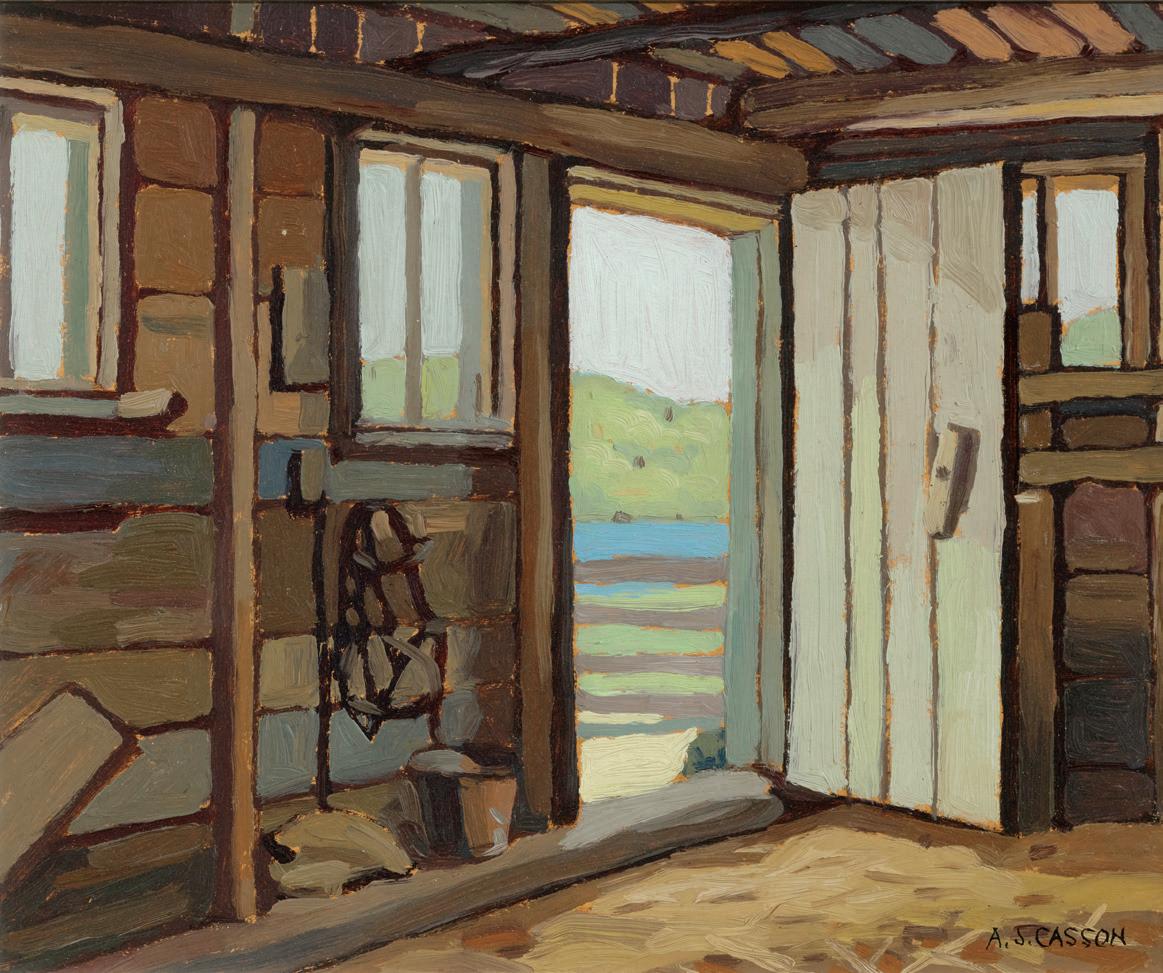
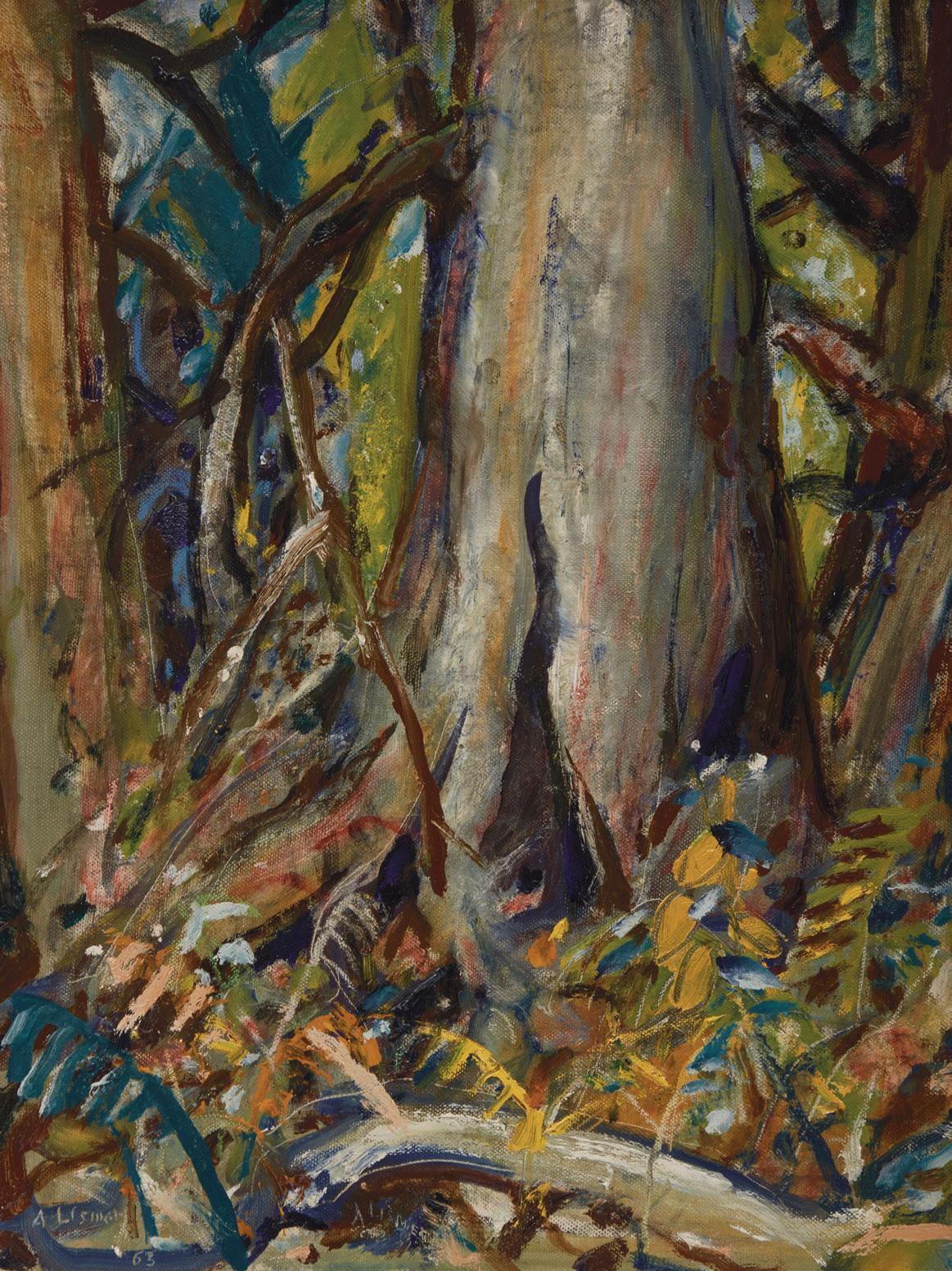
32
ALFRED JOSEPH CASSON
Barn Interior, Lake Kashagawigamog oil on board signed lower right; signed, titled and dated 1923 on the reverse 9.25 ins x 11.25 ins; 23.5 cms x 28.6 cms
PROVENANCE
Roberts Gallery, Toronto
A. H. Wilkens Auctions & Appraisals, auction, Toronto, 26 April 2023, lot 2003
Private Collection, Toronto
$25,000–$35,000
33
ARTHUR LISMER
British Columbia Forest oil on canvas board signed and dated 1963 lower left; signed, titled and dated on the reverse 16 ins x 12 ins; 40.6 cms x 30.5 cms
PROVENANCE
Dominion Gallery, Montreal e Hett Gallery Ltd., Edmonton
Sotheby's Canada, auction, Toronto, 2 June 1999, lot 153 Private Collection, Ontario
LITERATURE
Dennis Reid, Canadian Jungle: e Later Work of Arthur Lismer, Toronto, 1985, page 11
Arthur Lismer's British Columbia Forest is a luscious and intimate painting of the forest interior. e loosely rendered forms are highlighted with linear marks. e painter has used the blunt end of his brush to “draw” into the layers of oil paint.
Executed in 1963, British Columbia Forest is painted in the style that Lismer is best known for during the 1940s-60s. On the subject of Arthur Lismer’s late period works, academic Dennis Reid commented: " e painting of the fties and beyond–a con dent and joyful saga of self-exploration and painterly investigation in the expression of intense nature experiences–constitutes a body of work that will someday be recognized as one of the singular accomplishments of Canadian art."
$10,000–$15,000
COWLEY ABBOTT | Live Auction - Spring 2024 44

34
FREDERICK GRANT BANTING
Georgian Bay oil on board
signed lower right; signed and titled on the reverse 10.5 ins x 13.5 ins; 26.7 cms x 34.3 cms
PROVENANCE
Private Collection, Toronto
EXHIBITED
Exhibition of Paintings by the Late Sir Frederick Banting, Hart House, University of Toronto, 13 February-1 March 1943, no. 115
Our Visual Heritage, WKP Kennedy Gallery, North Bay, 3-26 August 2000
LITERATURE
Sotheby's Canada, auction catalogue, 15 May 1996, Toronto, lot 33 for the canvas associated with this artwork (Georgian Bay Island)
Joyner Fine Art, auction catalogue, 7 December 1999, Toronto, lot 144 for the canvas associated with this artwork (French River)
Frederick Banting experimented with various light, fresh, and earthy palettes in his artworks, blending these tones in dynamic yet harmonious compositions. Guided by A.Y. Jackson from the Group of Seven, Banting honed his skills in understanding colour, light, and shadow with the aim to transition his passion for art into a professional career.
In his painting Georgian Bay, Banting depicts the graceful jack pines swaying in the breeze of Lake Huron's expansive and iconic spot.
e vibrant hues of ochre, emerald, and rust are complemented by gentle strokes of light blues, soft oranges, and chartreuse. e artwork captures the seasonal transition, with the last remaining trees displaying lush green foliage against a backdrop of ery oranges and yellows.
$25,000–$30,000

35
ALEXANDER YOUNG JACKSON
Landscape Near Coppermine, N.W.T.
oil on board
signed lower right; signed, titled, dated "September 1959" and inscribed "Mary Leech/5 Mohawk Place/Kingston Ontario" on the reverse 10.5 ins x 13.5 ins; 26.7 cms x 34.3 cms
PROVENANCE
Dominion Gallery, Toronto
Private Collection, Ontario
By descent to the present Private Collection, Kingston
LITERATURE
A.Y. Jackson, A Painter’s Country, Toronto, 1958, pages 135, 184
In 1928 A.Y. Jackson travelled north with Sir Frederick Banting, a fellow artist and medical doctor, to Great Slave Lake and Fort Resolution in the Northwest Territories. Jackson returned often, noting, “Every chance I get I go by plane up into the tundra, into the Barren Lands.… I’m perfectly happy to be put down with my pack up among these rivers and lakes, perhaps two or three hundred miles from the nearest human being.” Jackson returned to the Northwest Territories in September 1959, camping at Lac Rouvière and Bathurst Inlet, south of the Dismal Lakes and the Coppermine River, which ows through the tundra into the Arctic Ocean.
Jackson's artistry masterfully captures the grandeur and vibrancy of the northern landscape in Landscape Near Coppermine, N.W.T., intertwining moss-laden slopes, crimson ora, and spruce trees into a rich autumnal tapestry. His dynamic composition from this September 1959 trip mirrors the rolling hills and soft, blue sky above, evoking the abundant energy of the Far North's remarkable ecosystem. After these adventurous excursions, Jackson would return to his studio with sketches to be painted as larger canvases, sharing, “We, with our notes and sketches, hoped to give Canadians some idea of the strange beauty of our northern possessions”.
$20,000–$30,000
COWLEY ABBOTT | Live Auction - Spring 2024 45
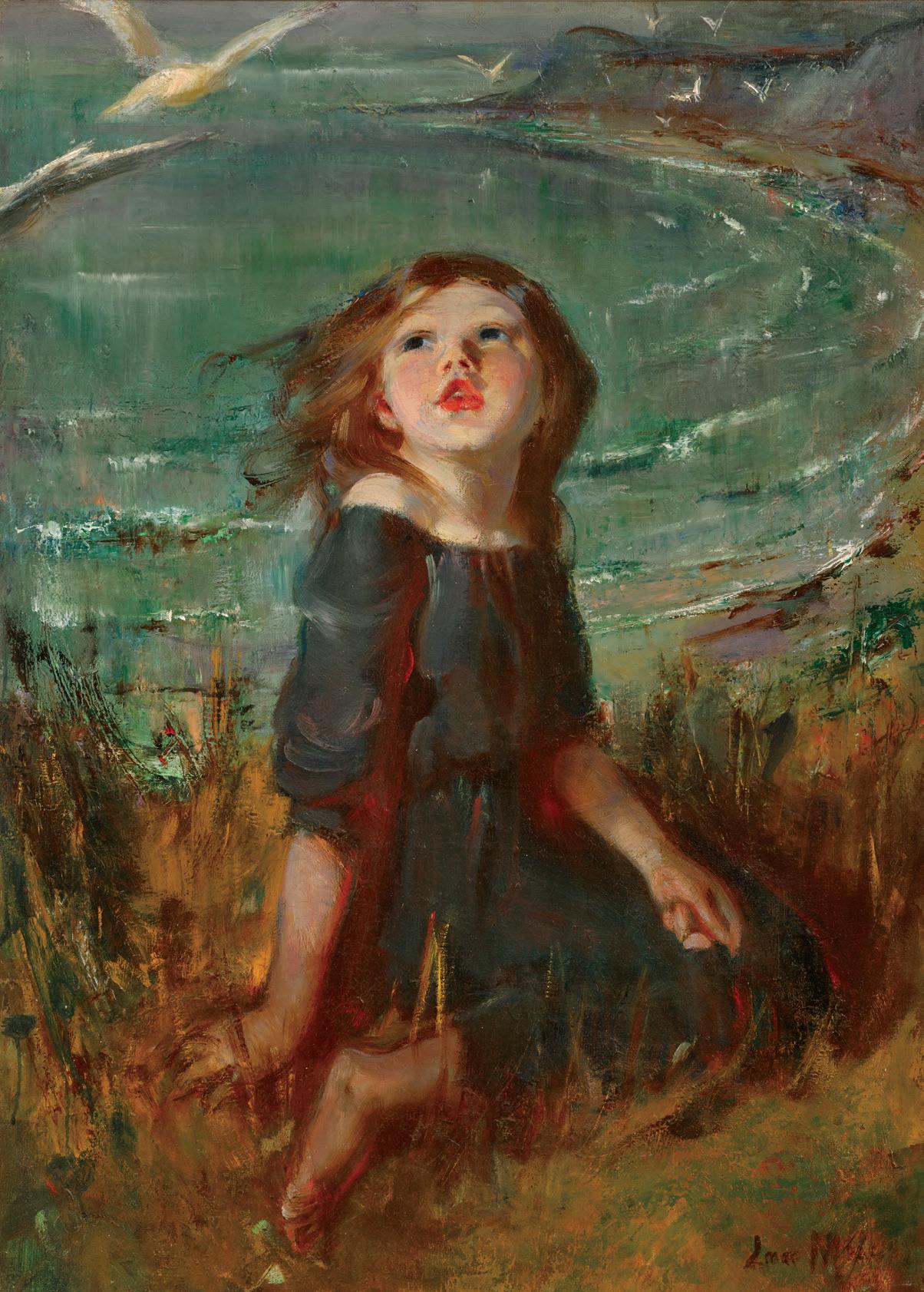
LAURA ADELINE MUNTZ LYALL
Girl with Seagulls oil on canvas signed lower right; titled to the artist label on the reverse 37.25 ins x 27 ins; 94.6 cms x 68.6 cms
PROVENANCE
Collection of Sir William Van Horne, Montreal
By descent to the Van Horne Family Private Collection
EXHIBITED
Department of Fine Arts, Canadian National Exhibition, Toronto, 23 August-6 September 1914, no. 299 as Child with Sea Gulls
Pictures and Sculpture Given by Canadian Artists in Aid of the Patriotic Fund Sale, under the auspices of the Royal Canadian Academy of Arts, Art Museum, Public Library Building Toronto; travelling to the Winnipeg Museum of Fine Arts; the Nova Scotia Museum of Fine Arts, Halifax; the New Brunswick Museum, Saint John; the Art Association of Montreal; the National Gallery of Canada, Ottawa and the Art Gallery of Hamilton, 1914-1915, no. 55 as Girl with Seagulls
LITERATURE
Department of Fine Arts, Canadian National Exhibition , Toronto, 1914, no. 299, reproduced Pictures and Sculpture Given by Canadian Artists in Aid of the Patriotic Fund Sale, Toronto, 1914, no. 55, reproduced " e Canadian National Exhibition: e Art Gallery", e Farmer's Advocate, 10 September 1914 e Studio, London, 1914, reproduced page 137 " ey do not Merely Pose as Painters", Toronto Daily Star, 24 March 1917
Joan Murray, Laura Muntz Lyall: Impressions of Women and Childhood , Montreal/Kingston, 2012, pages 40, 43
In 1913, Laura Muntz was working out of a studio in Beaver Hall Square at the top of Beaver Hall Hill in Montreal. Muntz was pursuing her career within the vibrant, cosmopolitan city and was regarded as the portraitist of children. Muntz had developed as an artist with a deeper insight and a broader, re ned technique in her painting. As Joan Murray shares: “In this third period of her work…portraits sometimes refer more to the artist and less to the subject. ey may deliver a bittersweet message through the melancholy expression of the subjects.”
Girl with Seagulls displays elements of the PostImpressionist technique, including richer colours and thick, textured brushstrokes. Muntz’s handling of paint became more innovative as her approach to the medium of oil shared the freedom of watercolour. “As a result, her art became bolder and more experimental,” Joan Murray explains. “She began to increase the density of her medium, layering the paint in heavily and intensifying the richness of her tones. She sought out new themes and orchestrated older ones, cherishing the way her images could evoke, rather than describe, complex ideas.”
is painting was amongst the artworks in the illustrious collection of Sir William Van Horne. e American-born builder of the Canadian Paci c Railway held masterpieces by artists such as Rembrandt and Turner in the public rooms of his Montreal mansion.
$30,000–$40,000
COWLEY ABBOTT | Live Auction - Spring 2024 46 36
MARY PRATT
Barby in the Dress She Made Herself oil on board signed and dated 1986 lower right 35.75 ins x 24.5 ins; 90.8 cms x 62.2 cms
PROVENANCE
Mira Godard Gallery, Toronto, October 1987 Private Collection, Nova Scotia
EXHIBITED
Mary Pratt: Aspects of a Ceremony, Equinox Gallery, Vancouver, 9-31 October 1986
Mary Pratt/Recent Paintings, Mira Godard Gallery, Toronto, 13 November-2 December 1987 as Barbi in the Dress She Made
Mary Pratt, e Rooms, St. John's; travelling to the Art Gallery of Nova Scotia, Halifax; Art Gallery of Windsor; the McMichael Canadian Art Collection, Kleinburg, Ontario and the MacKenzie Art Gallery, Regina, May 2013-August 2014 as Barby in the Dress She Made Herself
LITERATURE
Gerta Moray, Mary Pratt, Toronto/Montreal, 1989, page 35, reproduced page 147
Tom Smart, e Art of Mary Pratt: e Substance of Light, Fredericton, 1995, reproduced page 114
ARTSatlantic, no. 54, Winter 1996, reproduced on the cover
Alice Munro, No Love Lost, Toronto, 2003, reproduced on the cover
Mireille Eagan, Sarah Fillmore and Caroline Stone, Mary Pratt, Newfoundland and Labrador, 2016, reproduced page 87
Anne Koval, Mary Pratt: A Love A air with Vision , Fredericton, 2023, reproduced page 215
In 1986 Mary Pratt held her rst thematic exhibition, Aspects of a Ceremony, at the Equinox Gallery in Vancouver, focusing on weddings and the female rite of passage. Pratt's two daughters, Anne and Barby, married that year. e paintings that the artist created to commemorate the occasions formed the basis of the exhibition. Anne in My Garden and Barby in the Dress She Made Herself both represent the pressures placed on young women seeking romantic love, while also celebrating this important milestone. Pratt undertook this project during an emotionally charged period, when family life and her ideas around marriage were changing.
Pratt was exploring the concept of marriage as a “safe harbour”, capturing a Pre-Raphelite romantic sensibility in the portrayal of Anne–a young woman depicted in a white dress in a dreamy, contemporary setting–while the painting of Barby depicts the humanity of the wedding rite. Gerta Moray explores this idea, stating, "Barby in the Dress She Made Herself (1986), for example, is the portrait of a bride in a pose familiar from informal eighteenth-century portraits. She is seated with her head
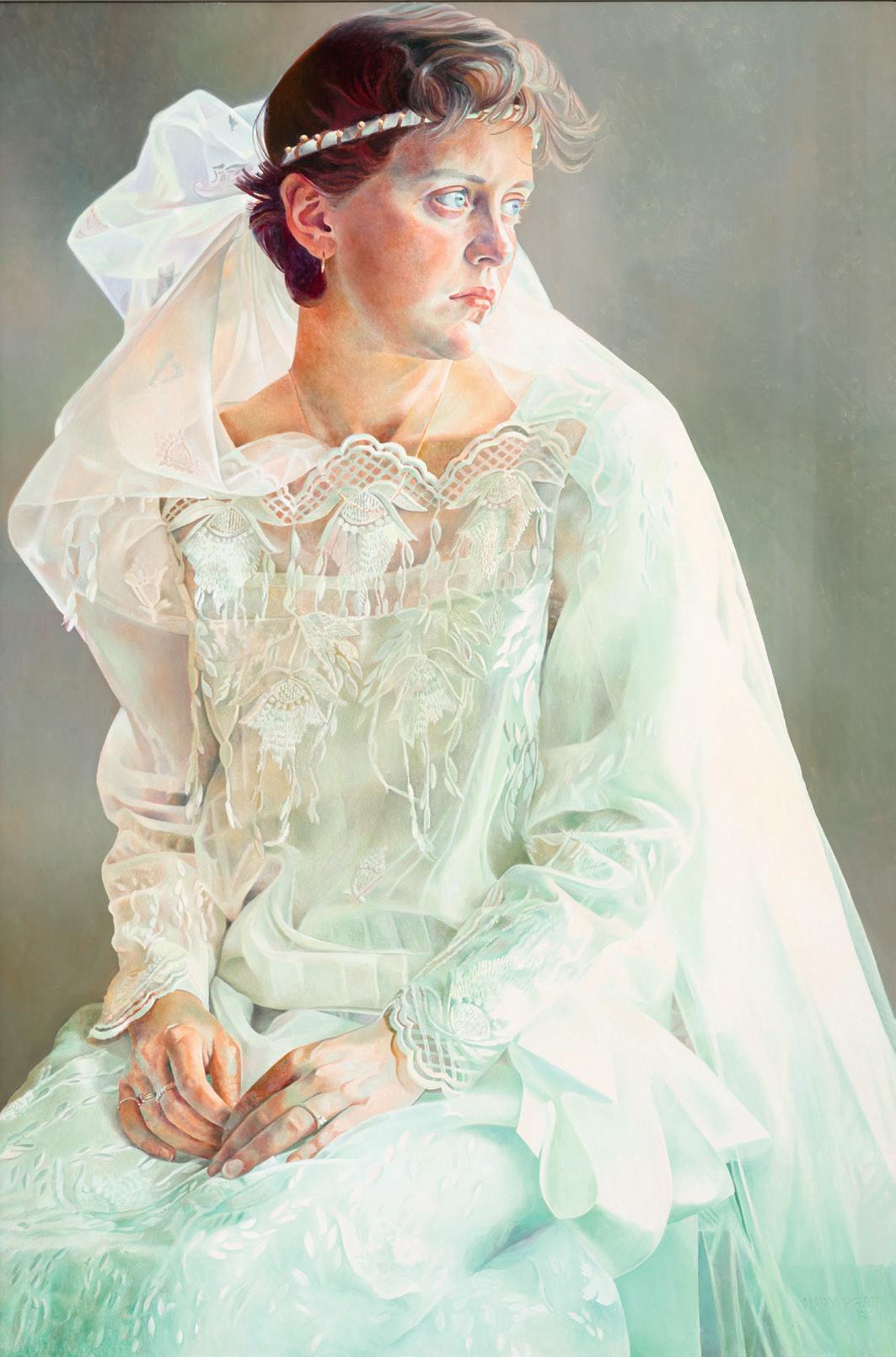
and shoulders turning one way, her arms and legs the others, so as to show o her richly embroidered bodice." Moray likens the work to Francois Boucher’s Madame de Pompadour e brides assume the stereotypes of the past, while inhabiting both a sense of self-consciousness and ambivalence.
Pratt snapped a photograph of Barby seated in her studio as she gazed out at the Salmonier River on her wedding day. Pratt then aptly translated the photograph into a painting, solidifying the human presence. e distant expression on Barby’s face, combined with her clasped hands, ceremonial dress and conventional pose point to the psychological aspect of the wedding ceremony. Prior to the wedding, Pratt had travelled with her daughter to Toronto to nd a dress. ey did not meet with success and as the title of the work indicates, Barby made her wedding dress from purchased fabric. is intimate rendering of Barby at the age of twenty-one has an ethereal quality, infused with delicacy, warmth and soft light. e subtly of the portrayal is executed in the hallmarks of Pratt’s masterful hand. Mireille Eagan describes Mary Pratt’s art as “an illumination rather than an illustration, one in which ‘everyday life’ describes not just a reality close at hand but also aspects of life that lie hidden.”
When the Aspects of a Ceremony exhibition opened on October 9th, 1986, Pratt attended alone. Many fellow artists came to the opening, which Pratt described as a success, re ecting that “It made me feel light and unencumbered. I can’t easily explain the way I feel, unburdened would be accurate.” is was perhaps a revelatory moment for Pratt and marked a step forward in both her career and personal life. $40,000–$50,000
COWLEY ABBOTT | Live Auction - Spring 2024 47 37

38
SOREL ETROG
The Queen II bronze stamped signature and numbered "1/7" on the base
62 ins x 18 ins x 8.75 ins; 157.5 cms x 45.7 cms x 22.2 cms
PROVENANCE
Private Collection, Toronto
LITERATURE
Alma Mikulinsky, Sorel Etrog: Life & Work [online publication], Art Canada Institute, Toronto, 2019, page 67
In the early 1960s, while living in New York City and studying at the Brooklyn Museum Art School, Sorel Etrog was fascinated by the museum’s collection of African and Oceanic art. His bronze sculptures of this time were inspired by natural forms and vegetation, aligned with a fascination in the wider art world with biomorphism. While trying to nd gallery representation in New York City, Etrog befriended the prominent Jewish-Canadian art collector, Samuel J. Zachs. Etrog was also becoming acquainted with the sculpture of Henry Moore, Barbara Hepworth and Constantin Brancusi–all artists whose works were collected by Sam Zachs. e combination of these new sources of inspiration would in uence Etrog’s work in the years to come.
Shortly before moving to Toronto in 1963, Etrog embarked on a trip to Italy, France, Greece, the Netherlands and Israel. In Florence, he encountered Etruscan art for the rst time, which would soon inspire the artist’s “Links” period, consisting of sculptures and paintings featuring a motif of two elements connected by a loop. is theme would dominate his art for eight years, during which he used it to articulate the existential contrasts of human life.
Deeply in uenced by ancient carving and sculpture techniques, Etrog notes: “I was lucky to have discovered the Etruscan links which showed me how to join the multiple shapes organically. e Link created a tension at the point where they joined, where they pulled together or pulled apart.” As he further explained, “I saw in [the link] a strong device for connecting and creating tension, mirroring the tension in our very existence with and within the outside world.” e Queen II shows the early development of this series, as it dates to 1962-63 when Etrog left New York, travelled, and then settled in Toronto. e bronze sculpture is composed of various abstract forms that are simultaneously geometric and organic, linked together at various angles. e three-dimensional artwork can be viewed from all angles, providing multiple perspectives of the twisting and turning forms. e intimate bronze presents a harmonious combination of Etrog’s wide range of in uences at a very particular transitional phase in his career.
$30,000–$50,000
COWLEY ABBOTT | Live Auction - Spring 2024 48
39
MARCELLE FERRON
Sans titre
oil on canvas
signed lower left; signed on the stretcher
7.5 ins x 9.5 ins; 19.1 cms x 24.1 cms
PROVENANCE
Kastel Gallery, Montreal
Private Collection, Montreal
LITERATURE
Roald Nasgaard, Abstract Painting in Canada , Vancouver/Toronto, 2007, page 84
As one of the signatories of the Refus global, Marcelle Ferron remained faithful throughout her career to the Automatiste precepts, with her oeuvre celebrating the group’s intention of liberating consciousness when “man is freed from useless chains, to realize a plenitude of individual gifts, in necessary, unpredictability, spontaneity and resplendent anarchy.” Here, Ferron’s method of scraping a palette knife through thick layers of paint down to the canvas support is on full display. e composition is vibrant and energetic, presenting kaleidoscopic colours weaving through each other across the entire surface. Fiery reds, bright blues, rich teals, and luminous yellows intersect randomly in broad strokes. is dynamic spectrum of chromatic hues exempli es the expressive style of Ferron’s abstract images.
$30,000–$40,000
40
JEAN-PHILIPPE DALLAIRE
Papillon oil on canvas
signed upper left; signed, titled, dated 1958 and inscribed "Paris" on the reverse
8.75 ins x 10.75 ins; 22.2 cms x 27.3 cms
PROVENANCE
Dominion Gallery, Montreal
Private Collection, California
Walter Klinkho Gallery, Montreal
Private Collection, Montreal
$18,000–$22,000


COWLEY ABBOTT | Live Auction - Spring 2024 49

JEAN PAUL RIOPELLE
Sans titre oil on paper on canvas catalogue raisonné no. 1958.038P.1958
22.25 ins x 30.5 ins; 56.5 cms x 77.5 cms
PROVENANCE
Galerie Riehentar, Bâle, Switzerland Galerie de Bellefeuille, Montreal Private Collection, Ontario
EXHIBITED
Galerie Riehentar, Bâle, Switzerland, 1959
LITERATURE
Yseult Riopelle, Jean Paul Riopelle: Catalogue Raisonné, Volume 2, 19541958, Montreal, 2004, reproduced page 399, no. 1958.038P.1958
François-Marc Gagnon, Jean Paul Riopelle: Life & Work [online publication], Art Canada Institute, Toronto, 2019, page 15
Jean Paul Riopelle’s involvement with Lyrical Abstraction in the 1950s proved to be much more valuable to him than his brief time with the Surrealists. He explored a multitude of ways to consider abstract art without relying on the dominant Mondrian-style geometricism or any other prescriptive formula. e palette knife added an element of chance to Riopelle’s mosaic works. He piled on various coloured pigments, and each time the paint was pushed across the canvas, the colours formed a di erent and unique outcome. François-Marc Gagnon points out that much earlier in the painter’s career, Riopelle had called for “hasard total,” or “absolute chance,” as the basis for a work of art, likely foreshadowing the direction he would take in his mature works. Dating to 1958, during the height of Riopelle’s experimental career and several years into his renowned “mosaic” series, Sans titre embodies this spontaneous arrangement of colours that is created with the palette knife. By 1960, the artist used the palette knife in new ways, creating more varied compositions with sinuous lines and bands in di erent widths. Sans titre, with its many spontaneous swoops of black paint, is perhaps foreshadowing this stylistic shift away from the very structured mosaics.
$30,000–$50,000
COWLEY ABBOTT | Live Auction - Spring 2024 50 41

RITA LETENDRE
Refet
acrylic on canvas signed and dated 1970 lower right; signed, titled “Re ét ” and dated 1970 on the reverse; unframed 39.75 ins x 59.75 ins; 101 cms x 151.8 cms
PROVENANCE
Private Collection, Montreal Bonhams, auction, Toronto, 19 June 2008, lot 162
Private Collection, Toronto
EXHIBITED
Galerie de Montréal, 25 November-31 December 1971
LITERATURE
Claude-Lyse Gagnon, Vie des Arts, Montreal, Winter 1969-1970, reproduced page 57
Joan Murray, Canadian Art in the Twentieth Century, Toronto, 1999, page 99
As one of the few women artists at the centre of abstract art in Canada, Rita Letendre holds an important position in Canadian art history. She produced some of the most innovative examples of abstraction, her style always uctuating between gestural and hard-edge abstraction. Letendre was in uenced by Paul-Émile Borduas and Les Automatistes in the 1950s, but in the following decade, after a large mural commission at the University of California, the artist moved towards hard-edge abstraction, playing with attened planes of colour with sharp lines.
Letendre’s large canvases of the 1970s explore her fascination with speed and vibration. e sharp wedges or arrows that cut across the image plane are characteristic of her work from the decade. In Re et a black ‘wedge’ shoots downward across the canvas, surrounded by green, yellow and fuschia bands of varying width, and a tomato red ground. Joan Murray discusses these important works produced by the artist during the 1970s, including Re et, stating: “Rita Letendre explored colour, line and composition through the use of forceful chevrons that cut across the composition diagonally or horizontally from one corner of the painting to the other. She obtained extra energy from applying narrow ridges of contrasting colour to the borders of each ray.” e sharp lines of bright colour all converge to a single point at the tip of the black ‘wedge’ in this painting, magnifying and concentrating the energy shooting downward.
$30,000–$40,000
COWLEY ABBOTT | Live Auction - Spring 2024 51
42
JACK HAMILTON BUSH
Bas Continuo #1
acrylic polymer on canvas signed, titled, dated "May 1976" and inscribed "Toronto" on the reverse 49.25 ins x 54.25 ins; 125.1 cms x 137.8 cms
PROVENANCE
e Artist, May-September 1976
David Mirvish Gallery, Toronto, September 1976-January 1977
Jay Lyons, Calgary, January 1977-6 June 2013
Christopher Varley, Toronto, 6 June 2013
Mayberry Fine Art, Winnipeg Private Collection, Winnipeg Private Collection
Jack Bush not only had an eye for colour, which is the cornerstone upon which he built his reputation as a Colour Field painter, but also for design. He was, after all, an award-winning illustrator and art director in the advertising arts for forty-one years. In terms of composition, Bush’s abstract paintings are dynamic, teetering between beautiful to curiously eccentric. at teeter (he in fact named one of his late canvases Teeter) is what holds the viewer’s attention, and Bush knew it.
While Bush repainted, cropped, and even destroyed many of his early abstract expressionist paintings in the 1950s, he returned to a heavy hand in editing his paintings in the early 1970s. In 1972, for example, he altered no fewer than eighteen paintings. He painted over, painted new, and made even the most minor adjustments–such as eliminating a two-inch dot–all of which made a big di erence to the nal look of the painting.
Sometimes, for Bush, a painting “worked” better if it was divided. is was the case for Bas Continuo #1. is painting was originally executed on a larger canvas, which the artist subsequently divided into two separate pieces. e counterpart to this work is Bas Continuo #2. In its original state, simply titled Bas Continuo, the painting measured 55 by 83 inches (139.7 x 210.8 cm); after the cut, Bas Continuo #1 was the larger canvas of the two, leaving Bas Continuo #2 as a relatively narrow painting, at just under 30 inches wide (76.2 cm). is smaller canvas is now in the collection of York University, donated by Joan and Martin Goldfarb.
As well as being cropped from its original composition, Bas Continuo #1 was also rotated; the three slender strips of colour projecting from the slab of red had once pointed downward, but after the crop the cut edge became the bottom edge in its nal state, leaving these streamers to point up and to the left. It is not certain when Bush altered the original painting, but it must have occurred sometime before September 1976, when he sent Bas Continuo #1 to the David Mirvish Gallery.
In the lexicon of musical terms, basso continuo is the bassline in Baroque music that provides harmonic structure, which is often spontaneously composed by the performers. e title for this painting, and the term’s connotation with improvisational creativity, is apropos of Bush’s keen ability to pivot and make highly e ective changes in his own work. Bush did not leave any clues as to why he felt compelled to turn one painting into two, but it is a testament to the extent to which the artist went to make the composition just right.
is painting will be included in Dr. Stanners’ forthcoming Jack Bush Paintings: A Catalogue Raisonné
We extend our thanks to Dr. Sarah Stanners for contributing the preceding essay. Sarah is currently an Adjunct Professor at the University of Toronto’s Department of Art History while writing the forthcoming Jack Bush Paintings: A Catalogue Raisonné. From 2015 to 2018 she was the Chief Curator of the McMichael Canadian Art Collection, Co-Curator of the 2014/2015 national travelling exhibition, Jack Bush, Co-Author of the resulting 2014 exhibition catalogue ( Jack Bush) and guest curator and author of Jack Bush: In Studio, organized by the Esker Foundation in Calgary.
$175,000–$225,000
COWLEY ABBOTT | Live Auction - Spring 2024 52 43

COWLEY ABBOTT | Live Auction - Spring 2024 53

44
LAWREN STEWART HARRIS
Abstract #36 oil on board numbered 36 upon the "Lawren Harris LSH Holdings Ltd." stamp on the reverse 20 ins x 29.75 ins; 50.8 cms x 75.6 cms
PROVENANCE
Private Collection, Toronto
Sotheby's, auction, Toronto, 27 November 2012, lot 26
Private Collection, Toronto
Acknowledged as the driving force behind the Group of Seven, Lawren Harris’s life and work veered in new directions following the disbanding of the collective in 1933. Harris’s landscapes had become iconic, earning him admiration from critics and his contemporaries. But rather than maintain his established artistic trajectory into his later years, Harris instead committed himself to the exploration of pure abstraction. Harris had long been interested in theosophy, a spiritual philosophy that drew from eastern and western beliefs to emphasize inner wisdom and the pursuit of mystical transcendence. Harris moved to the United States in 1934 to live and work as a visiting artist at Dartmouth College in Hanover, New Hampshire. A few years later, he moved to Santa Fe, New Mexico, where he co-founded the Transcendental Painting Group in 1939. e group drew inspiration from gures such as Ralph Waldo Emerson and Wassily Kandinsky, and their shared interest in metaphysical ideas.
Freeing his painting from representation, Harris sought to distill his work to its most essential formal elements in order to convey inner truths. Abstract #36 makes use of a delicately restrained palette, with the dark reds and blues pulling the dominant forms into the foreground. ese dancing shapes are enveloped with undulating lines, which appear to recede into softening focus. e element at the lower right resembles an eye, potentially alluding to spiritual vision.
$30,000–$40,000
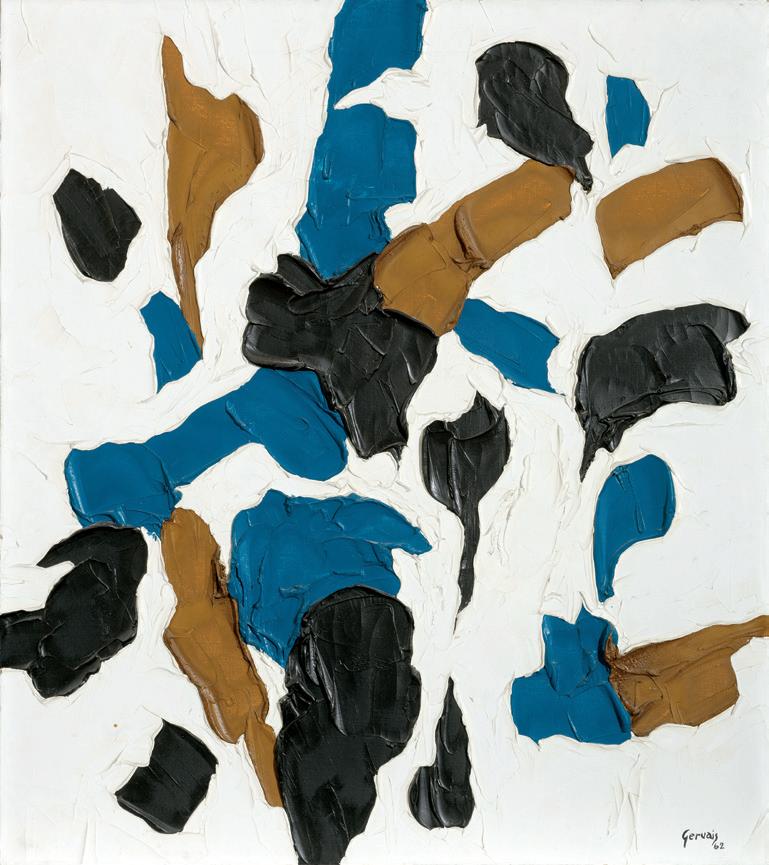
45
LISE GERVAIS
La croix du sud oil on canvas signed and dated 1962 lower right 27 ins x 24 ins; 68.6 cms x 61 cms
PROVENANCE
Galerie du siècle Inc., Montreal Private Collection
Working in Montreal, Lise Gervais was inspired by Paul-Émile Borduas and Les Automatistes, although she was not an o cial member of the group. She played a signi cant role in Quebec's abstract painting movement in the 1960s, focusing on bold pigments and high contrast to bring energy to her art.
Gervais travelled to Spain in 1958, where she was particularly inspired by the work of Francisco Goya. Back in Montreal in 1961, she had her rst solo show at the Galerie Denyse Delrue. She would go on to show with Gallery Moos in 1962, the same year that she created La croix du sud.
e textured and colorful surface of Lise Gervais's painting La croix du sud vividly captures the vibrant energy with which she infused her artwork. Gervais' personal interest in texture and materiality results in expressive and instinctive brushwork, with bold swatches of taupe, black, and teal popping against a crisp white backdrop. ese colours, applied with precision, carry a dynamic and instinctive touch, creating a captivating composition that showcases Gervais's artistic expertise.
$8,000–$12,000
COWLEY ABBOTT | Live Auction - Spring 2024 54

ALEX SIMEON JANVIER
Dene (The People)
acrylic on canvas
signed upper right; signed, titled, dated 1991 and inscribed "Cold Lake" on the reverse
60.25 ins x 48 ins; 153 cms x 121.9 cms
PROVENANCE
Private Collection, Toronto
LITERATURE
Greg A. Hill, Alex Janvier, Ottawa, 2016, page 18
A founding member of the Professional Native Indian Artists, established in 1973, Dene and Anishinaabe (Salteaux) artist Alex Janvier of Cold Lake, Alberta, is an important gure in the reformation of Indigenous Art in Canada. Janvier developed a highly individualistic style deeply infused with the symbolism of his Dene heritage and culture. His abstract paintings often feature titles that address colonialism, identity and references to the land. is painting’s title refers to Janvier’s Dene background (dene is also the common Athabaskan word for “people”) as well as his hometown of Cold Lake, which is inscribed on the reverse of the canvas. Janvier’s abstractions possess an endless uidity, while seeming on the verge of settling into recognizable images. Curator Greg Hill noted, “Spirituality is also evident in Janvier’s work in subtle ways, such as in his characteristic sinuous lines. e lines... are reminiscent of the graceful and ever–changing movement of tobacco smoke and steam intermixing in shafts of light, or the dance of the aurora borealis spanning an entire night sky, the movement and patterns transcribed to feelings, colour and paint.” Janvier’s distinctive paintings allude to nature, indigenous culture, and spirituality.
$50,000–$70,000
COWLEY ABBOTT | Live Auction - Spring 2024 55
46

WILLIAM KURELEK
Rosedale Golf and Country Club - It's Hard for Us to Realize
mixed media on board signed with monogram and dated 1972 lower right; titled and dated on the reverse
22 ins x 41.75 ins; 55.9 cms x 106 cms
PROVENANCE
Acquired directly from the Artist, 1967 Private Collection, Toronto Private Collection, Toronto
He el Fine Art, auction, Vancouver, 9 November 2000, lot 322 Private Collection, Winnipeg
EXHIBITED
Abbotsford Collects: Selected Works from Local Collectors, e Reach Gallery Museum, Abbotsford, 24 June-3 October 2010
LITERATURE
William Kurelek, O Toronto: Paintings and Notes by William Kurelek , Toronto, 1973, introduction by James Bacque (unpaginated), page 24
O Toronto: Paintings and Notes by William Kurelek , was published after the exhibition William Kurelek: e Toronto Series/Toronto: A Series of 20 Paintings and One Drawing held at e Isaacs Gallery in October of 1972. As noted in the book’s introduction by James Bacque, Kurelek had embraced his new home with the full force of his personality, drive, and unique artistic vision. “William Kurelek” he states, “paints in Toronto as if the city were his.” Rosedale Golf and Country Club – It’s Hard to for Us to Realize, is a variation on the work of the same title included in the publication, O Toronto. is brilliant documentation of Rosedale Golf and Country Club, located at the north end of Mount Pleasant Road, is symbolic of Kurelek’s world view. Having just returned to Canada via England, with Christianity now deeply rooted in his convictions and steadfastly concerned that mankind faced imminent collapse, Kurelek looked at the city di erently and saw the need for reform. In the richly detailed, symbolic and fascinating painting, It’s Hard for Us to Realize, Kurelek observed the city and sought “to drive the fat cats from their golf carts on the eighteenth green at the Rosedale Golf Club.” e message in this work, as Bacque shares, “is about [Kurelek’s] conception of life and this particular city, not about painting, technique, the quality of light, or even the artist’s function in society.”
Kurelek recounts in O Toronto: “I attended a wedding reception there a few years ago. Two years after that experience of sumptuousness and high fashion, I was walking the streets of Bombay in the company of a Capuchin monk. I try to get the feeling across that I had then of the contrast between the two ways of life by superimposing one scene on the other. In the foreground I’ve located my own house from Balsam Avenue, modest in comparison with some on the wealthier areas of town, but I placed right behind it the lean-to and culvert homes of India’s destitute. at’s the habitation contrast.”
$50,000–$70,000
COWLEY ABBOTT | Live Auction - Spring 2024 56
47

48
WILLIAM KURELEK
Family Building Stack
mixed media on board signed with monogram and dated 1969 lower right; titled to a gallery label on the reverse 24 ins x 30.75 ins; 61 cms x 78.1 cms
PROVENANCE
Galerie Agnès Lefort, Montreal Loch Mayberry, Winnipeg Mayberry Fine Art, Winnipeg Private Collection, British Columbia
William Kurelek grew up on dairy and wheat farms in Manitoba and Alberta, respectively, where he learned to work the land alongside his family. His experiences during the Depression era in Canada deeply in uenced his connection to the prairie landscape. Kurelek believed it was crucial to capture the vastness of the at prairies, comparing them to the expansive oceans found at the nation's coasts. e meeting of sky and land in his artwork created a striking symmetrical composition of blue and ochre tones, emphasized by precise perspective lines de ning boundaries and structures. rough his paintings, Kurelek masterfully portrayed the story of Ukrainian-Canadian pioneer life, highlighting the immigrant contributions to Canada's development.
Family Building Stack highlights the important seasonal tradition of threshing wheat for sale. Wheat farming was not only crucial for Alberta farmers to contribute to Canada's economy but also played a vital role in sustaining families and communities across the expansive rural prairie landscape. e Kurelek family had a longstanding tradition of wheat farming. However, due to challenges like the Great Depression and crop failure due to poor weather, they had to move from Alberta to Manitoba to pursue dairy farming for better opportunities. ough necessary for the livelihood of the family, Kurelek's father, Dmytro, was resentful of the change and always sought to continue wheat farming in any capacity while the rest of the family assisted and tended to the dairy farming duties. For William, assisting his father was a key memory that was continually re-examined in both his writings and artworks.
is captivating scene captures a beautiful yet eeting autumn landscape, highlighting the need to harvest grains before the harsh prairie winter sets in. Emphasizing the signi cance of manual labor and human presence in the environment, the artist values tradition over modern technology. e central hay stack stands prominently, accentuated by the small gures of a family, illustrating the hard work required to build these stacks for the upcoming harvest and processing.
$80,000–$120,000
COWLEY ABBOTT | Live Auction - Spring 2024 57


NORVAL MORRISSEAU
Great Medicine Horned Owl acrylic on canvas signed in syllabics lower right; signed with initials, titled and inscribed "Symbol or sign of the Ojibwa; Midawiin Medicine Society of the three res" on the reverse 36 ins x 30 ins; 91.4 cms x 76.2 cms
PROVENANCE
Acquired directly from the Artist EA Studios, Calgary
LITERATURE
Lister Sinclair and Jack Pollock, e Art of Norval Morrisseau , Toronto, 1979, pages 116, 133
In 1976, Norval Morrisseau was introduced by his assistant, Eva Quan, to Eckankar, a belief system that welcomes past lives, dreams and the ability of the soul to travel. As Lister Sinclair states: “Morrisseau has been devoted to Eckankar, a body of teaching which centers around soul travel. Once again he has found a way of systematically using personal visions to liberate his artistic imagination. Once again, for all his uniqueness as an artist and as a human being, he shows himself securely placed in the Indian tradition of a vision–generating shaman.”
Morrisseau portrays the owl (Gookooko’oo) in his artworks as a guardian who watches over the beings of the world, writing that “ e all-seeing owl can warn of approaching danger; it is a protector.” A closer look at owl characteristics in Anishinaabe cosmology reveal a nuanced perception of owls, where their calls are understood to help guide the spirits of humans who have passed on. As a prominent bird in the natural world, owls are sources of knowledge and assume the role of teachers and healers, as well as providing wisdom and guidance to the Anishinaabe.
In recognition of Norval Morrisseau's rich heritage and their longstanding partnership with him during his sponsorship with EA Studios, Calgary, the rm will donate a portion of the proceeds of the sale of this canvas directly to the Orange Shirt Foundation. is donation notes Morrisseau’s survival of the residential school system while supporting and honouring the painter’s legacy.
$25,000–$35,000
COWLEY ABBOTT | Live Auction - Spring 2024 58
49
Norval Morrisseau with Great Medicine Horned Owl Courtesy of EA Studios, Calgary Not for sale with this lot

50
BILL RONALD REID
Bear Head or Knob
sterling silver, abalone and ivory
incised signature, dated 1981 and numbered IV/V on the reverse 3 ins x 2.75 ins x 2.25 ins; 7.6 cms x 7 cms x 5.7 cms
PROVENANCE
Douglas Reynolds Gallery, Vancouver
Private Collection
LITERATURE
Martine J. Reid, Bill Reid Collected , British Columbia, 2016, similar work Bear Head (1981) in bronze reproduced on page 114
Bill Reid, Gallant Beasts and Monsters, Vancouver, 1992, similar work Bear Pendant (1992) reproduced page 36 ( gure xiii) and listed page 41
$20,000–$30,000
Iljuwas Bill Reid is celebrated as one of the most signi cant Northwest Coast artists of the twentieth century. A member of Raven-Wolf Clan of the Haida Nation, Reid followed in the footsteps of his great-greatuncle, master carver and silversmith, Daxhiigang (Charles Edenshaw), to create a fusion of Haida traditions that melded with his own modernist aesthetic.
Bear Head or Knob, 1981 (lot 50), and Grizzly Bear Ring, 1976 (lot 51), showcase Reid’s technical skills as a master carver and metalsmith, allowing him to work in a range of materials from silver and gold to ivory and abalone. e Bear was a favorite subject of Reid’s and serves as an important symbol for the Haida Nation. In Haida mythology, the Bear Mother is a well-known legend shared by many Indigenous peoples of the Northwest Coast. e legend emphasizes the importance of honouring and respecting animals, particularly bears, representing a mythic time when bears and humans lived in respectful

51
BILL RONALD REID
Grizzly Bear Ring
18 karat gold
incised signature, dated 1976 and numbered 6/10 on the inside 0.5 ins x 1 ins x 1 ins; 1.3 cms x 2.5 cms x 2.5 cms
PROVENANCE
Douglas Reynolds Gallery, Vancouver
Private Collection
LITERATURE
Doris Shadbolt, Bill Reid , Vancouver, 1986, page 25
Bill Reid, Gallant Beasts and Monsters, Vancouver, 1992, similar work Grizzly Ring (1976) reproduced page 31 ( gures vi & vii), listed page 41
John Maclachlan Gray, “When Culture Becomes Heritage,” e Globe and Mail, Toronto, 15 October 2002
Gerald McMaster, Iljuwas Bill Reid: Life and Work, Toronto, 2021, page 22
$15,000–$20,000
tolerance of one another. Gerald McMaster writes: “In alignment with Haida views, [Reid] understood that his craftsmanship was not for human eyes alone—that, regardless of scale, care in producing a wellmade object took into account that the ‘gods see everywhere.’”
At the core of Reid’s artistic practice were the concepts of deeply carved and well-made objects. Reid believed that “one basic quality unites all of the works of mankind that speak to us in human, recognizable voices across the barriers of time, culture, and space: the simple quality of being well-made.” Doris Shadbolt expands on this idea, stating that these objects “must carry the charge that invests the images with their life as form and hence their meaning, empowering them, in short, to be carved deeply into our consciousness.” Reid’s Grizzly Bear Ring and Bear Head or Knob embody these concepts, which testify to a quintessential Haida way of seeing and making.
COWLEY ABBOTT | Live Auction - Spring 2024 59

ALFRED JOSEPH CASSON
Farm Near Maple Lake, Haliburton oil on canvas board signed lower right; signed and titled on the reverse, signed, titled and dated 1938 to the artist label on the reverse 9.5 ins x 11.25 ins; 24.1 cms x 28.6 cms
PROVENANCE
Roberts Gallery, Toronto
A. H. Wilkens Auctions & Appraisals, auction, Toronto, 26 April 2023, lot 2024
Private Collection, Toronto
LITERATURE
Paul Duval, Alfred Joseph Casson, President, Royal Canadian Academy, Toronto, 1951, reproduced page 62
As one of Canada’s most prominent landscape painters, Alfred Joseph Casson was loyal to the wilderness and villages of Ontario. Teeming with mood from dramatic shadows, dark grey cloud formations and scurrying chickens, Farm Near Maple Lake, Haliburton suggests an impending summer storm. Paul Duval praises Casson’s skill of depicting an ephemeral moment or scene, such as a thunderstorm, as if frozen in time. e author remarks, “Like the contemporary American realist, Edward Hopper, he has the ability to crystallize a moment, to make concrete and eternal the passing vision. It is as though the timemachine has suddenly ceased to function, in a world where the wind had stopped breathing and the shadows no longer moved and every blade of glass and cloud were xed forever.”
$25,000–$35,000
COWLEY ABBOTT | Live Auction - Spring 2024 60 52
53
EDWIN HEADLEY HOLGATE
Baie St. Paul
oil on panel signed with initials lower right; signed and titled on the reverse
5.5 ins x 7 ins; 14 cms x 17.8 cms
PROVENANCE
Dominion Gallery, Montreal Private Collection, Toronto
EXHIBITED
Edwin Holgate, Dominion Gallery, Montreal, 18 October-2 November 1946
LITERATURE
Rosalind Pepall & Brian Foss, Edwin Holgate, Montreal, 2005, reproduced page 25 (exhibition photo)
In October 1946, the Dominion Gallery held a large and commercially successful exhibition of twenty- ve years of Edwin Holgate’s work. is lovely oil on panel was included in the exhibit, as identi ed on the reverse, and visible in a photograph of the exhibition from 1946.
$12,000–$15,000
54
MARC-AURÈLE FORTIN
Winter Scene
oil on masonite
signed lower left
21.5 ins x 27.75 ins; 54.6 cms x 70.5 cms
PROVENANCE
Private Collection, Toronto
LITERATURE
Marc-Aurèle Fortin, Germain Lefebvre, Janine Leroux-Guillaume et al., Marc-Aurèle Fortin: peintre-graveur, 1888-1970, Montreal, 1983, page 76
Colin S. MacDonald, A Dictionary of Canadian Artists, Volume 1: A-F, 5th Edition, Ottawa, 1997
In this enchanting oil painting depicting a Quebec village in winter, Marc-Aurèle Fortin skillfully rendered his varied and decorative colour palette, demonstrated in the yellow, pink and orange houses, as well as the blue, green and grey landscape that is covered in a blanket of snow. As with the painter’s most celebrated work, any presence of darkness is overpowered by colour. Winter Scene illustrates one of Fortin’s preferred subjects: the nocturnal winter scene. With the grey ground visible between the vibrant pigments, this painting likely depicts a scene at dusk. e distinctive high-contrast colour palette with a grey background was adopted by Fortin in the late 1930s, known as his ‘black period’ and ‘grey period’. After an inspirational year-long

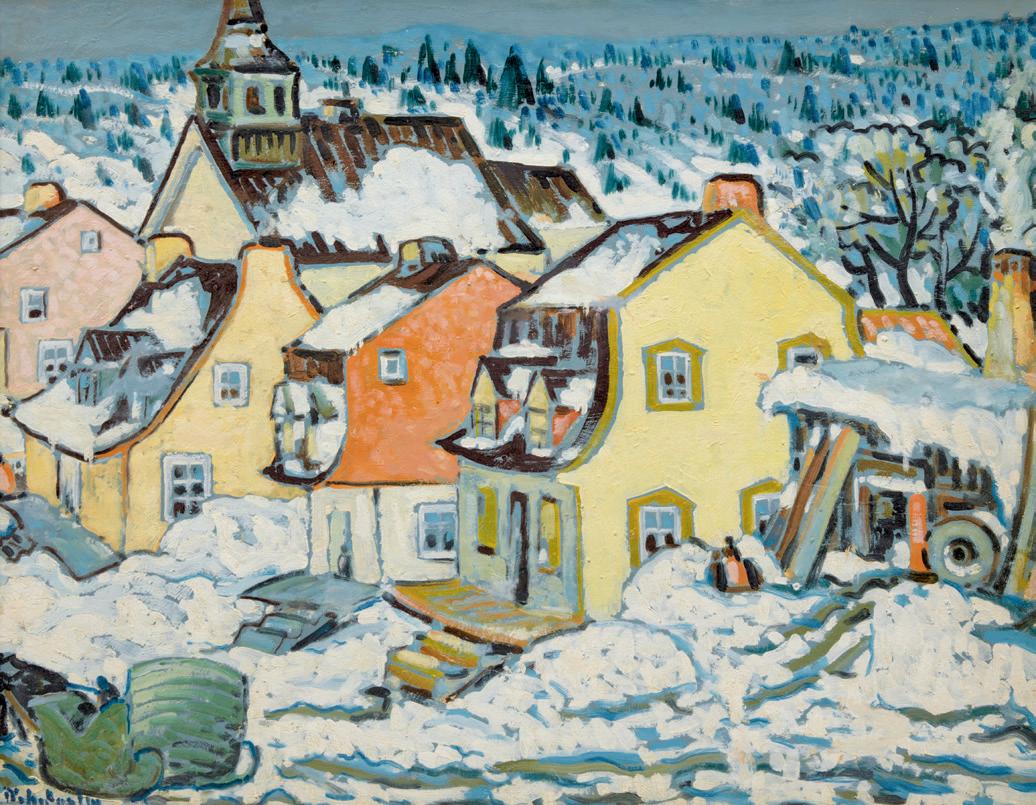
sojourn in France between 1934 and 1935, the artist returned to Sainte-Rose and began experimenting with the application of pure colours onto a black or grey surface. Using a support of wood, canvas or metal, Fortin painted a thick layer of black or grey pigment, which he left to dry during a period of time before painting his subject in large brushstrokes dipped in vivid colours. By deliberately leaving the black paint of the rst layer visible in certain areas, the artist achieved luminous and brilliant colour juxtapositions.
$35,000–$45,000
COWLEY ABBOTT | Live Auction - Spring 2024 61
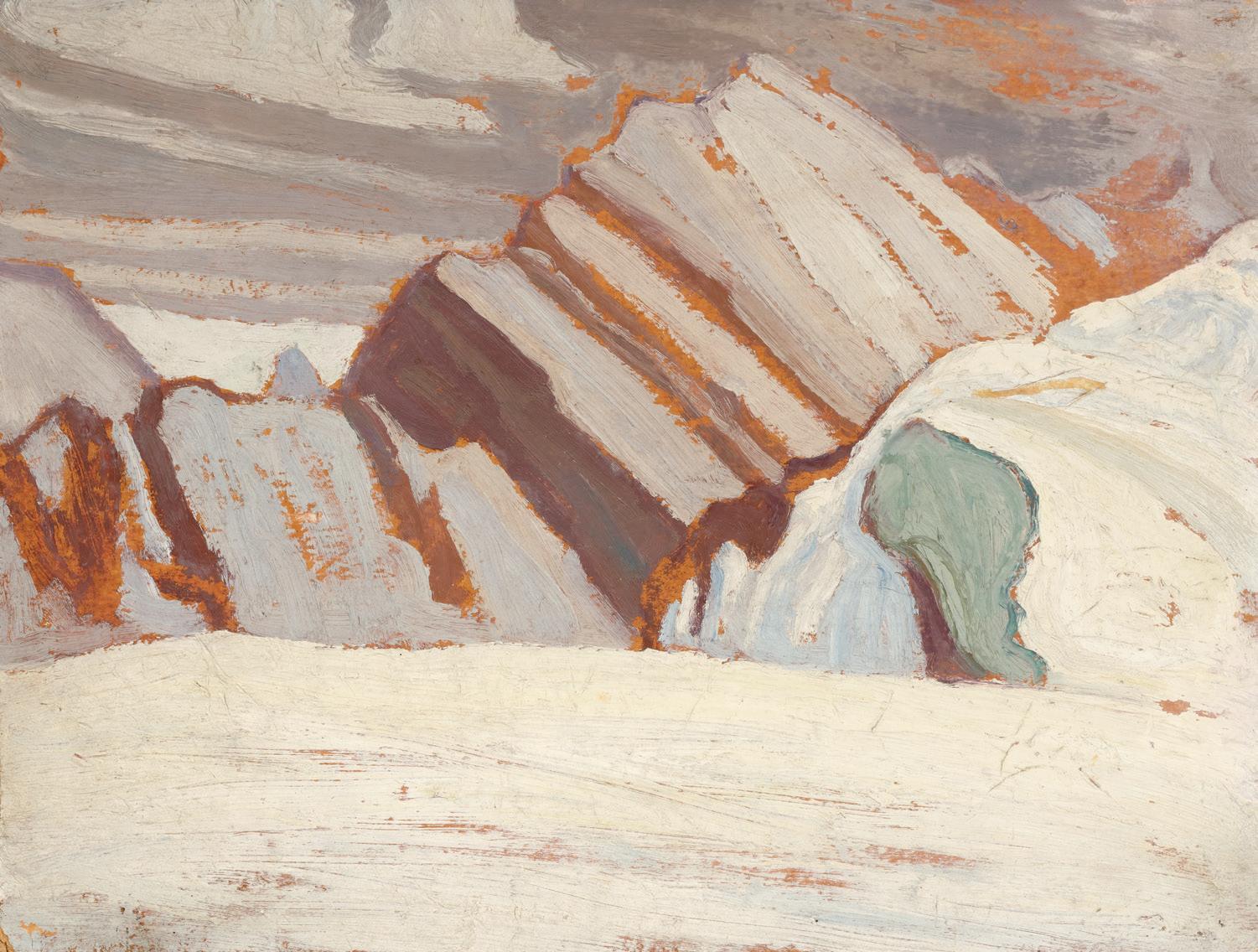
to the top of the timber where we camped. e Colin Range was an amazing place, a kind of cubist paradise full of geometric formations, all waiting for the abstract painter.”
LAWREN STEWART HARRIS
Colin Range (Canadian Rockies) oil on board
inscribed "New Panels 10" on the reverse 10.5 ins x 13.75 ins; 26.7 cms x 34.9 cms
PROVENANCE
Collection of Howard Harris, son of Lawren Harris Gift of Howard Harris to Ray Eleanor Staples (Mrs. Everett Staples) By descent to the present Private Collection, Toronto
LITERATURE
A.Y. Jackson, A Painter’s Country: e Autobiography of A.Y. Jackson , Toronto, 1958, pages 106-107
Bess Harris and R.G. P. Colgrove, Lawren Harris, Toronto, 1969, page 62
In July 1924, four years after the formation of the Group of Seven, Lawren Harris and A.Y. Jackson checked into the Jasper Park Lodge with their sights set on exploring and sketching Jasper National Park. e Park covers a region of more than 10,878 kilometres of terrain. As A.Y. Jackson recounts: “In the summer of 1924 Lawren Harris took his family to Jasper Park and I went along with him, as we planned to do some work for the Canadian National Railway. We did not nd the landscape around Jasper Lodges or along the railroad very interesting, and we wanted to get into the big country, so we arranged with the park superintendent, Colonel Rogers, to have our dunnage taken in by the warden’s while we walked in, rst to Maligne Lake, and then to the Tonquin. At Maligne we borrowed an eighteen-foot canoe and paddled about fteen miles to the far end of the lake. It was a weird and ancient country of crumbling mountains and big glaciers. Deciding we liked the look of the Colin Range to the east better, we borrowed a horse from the warden, piled all our supplies on him, and climbed
e viewpoint in this work is Opal Creek, painted in part of the Colin Range, now known as Queen Elizabeth Range. Harris and Jackson explored this range twice on their 1924 trip. e pair had a painterly fascination with the scenery they encountered on their hikes, despite the di cult weather of constant rain, the wonders of the rugged terrain captured the attention of the artists. Jackson recalls that, “a couple of months at Jasper improved our camping technique and made us active and tough as mountain goats. We would make camp at the timber line and from there climb a thousand feet or so and nd miles of undulating county to roam over, When sketching, we would often have to build stone shelters to break the biting winds. We were strong on tea.”
e more Lawren Harris saw of Canada, or the “big country”, as Jackson called it, the more Harris understood. Harris recalled, “After I became better acquainted with the mountains, camped and tramped and lived among them, I found a power and majesty and a wealth of experience at nature’s summit.” Colin Range (Canadian Rockies) represents the period when Harris was breaking away from a purely nationalist mandate and working towards a more universal spiritualism. As a type of mystic, Harris may have believed that the mountains, by their sheer physical height and mass, brought him closer to eternity. Harris worked to capture his inner response to this landscape and shape it on canvas. He wanted the paintings to encapsulate his experience of the Rockies. is sketching trip marked the rst experience in the mountains of western Canada for Harris, which would captivate the artist’s attention for six years.
We extend our thanks to Alec Blair, Director & Lead Researcher of the Lawren S. Harris Inventory Project, for his assistance in researching this artwork.
$70,000–$90,000
COWLEY ABBOTT | Live Auction - Spring 2024 62
55
56
LIONEL LEMOINE FITZGERALD
Manitoba Landscape oil on board
signed and dated 1929 lower right; titled and dated to the estate label on the reverse 10 ins x 12 ins; 25.4 cms x 30.5 cms
PROVENANCE
Estate of Douglas M. Duncan (label signed by Frances Barwick & Cecil Troy on the reverse)
Private Collection, Edmonton
$8,000–$12,000

57
JAMES EDWARD HERVEY MACDONALD
Sunset, Lake Simcoe oil on board
signed with initials lower left 8.5 ins x 10.25 ins; 21.6 cms x 26 cms
PROVENANCE
McCready Galleries, Toronto
Private Collection, Edmonton
In 1918, J.E.H. MacDonald joined Lawren Harris, Frank Johnston and patron, Dr. MacCallum, on the rst painting expedition to Algoma by boxcar. Algoma o ered plentiful inspiration for the artists, and MacDonald was able to return on excursions to the scenic region through the next couple of years. Sunset, Lake Simcoe was painted shortly after the inaugural exhibition of the Group of Seven at the Art Gallery of Toronto in 1920. Reminiscent of the work of the English Romantic painters, an early in uence on MacDonald, this work is a painterly study of light and atmospheric e ects. e sky and water feature wonderfully delicate, shifting hues. e sunset and its re ections act as the only focal points in the picture. Sunset, Lake Simcoe shows us a di erent side to J.E.H. MacDonald, in marked visual contrast to the artist’s acclaimed dense compositions of close-cropped garden views.
$25,000–$35,000
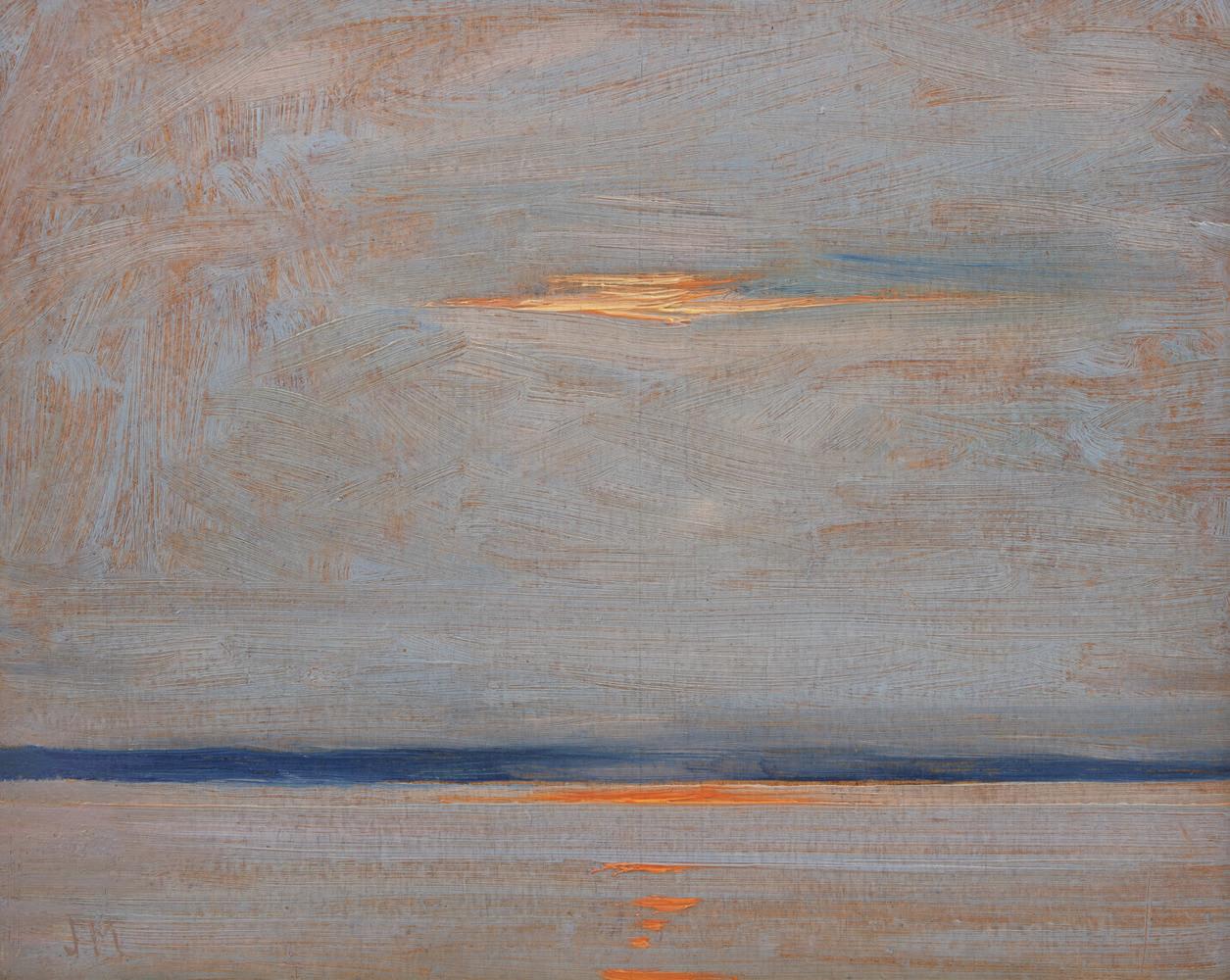
COWLEY ABBOTT | Live Auction - Spring 2024 63

ROBERT WAKEHAM PILOT
Plain Trees, Paris oil on board signed lower right 5.5 ins x 7 ins; 14 cms x 17.8 cms
PROVENANCE
Continental Galleries, Montreal
Walter Klinkho Gallery, Montreal Private Collection, Toronto
LITERATURE
A.K. Prakash, Impressionism in Canada: A Journey of Rediscovery, Stuttgart, 2015, page 621
After serving in World War I, Robert Pilot went to study in Paris like many other Canadian artists of the time. e artist became enamoured with Impressionism, particularly the work of Camille Pissarro. Soon after his return, the painter was invited by A.Y. Jackson to include two of his works in the Group of Seven’s rst exhibition in 1920. As A.K. Prakash remarks, Pilot “preferred to paint inhabited places rather than the untamed wilderness, so he di ered philosophically from the group’s nationalist approach to art.” is approach is illustrated in this charming painting populated by the âneurs of Paris. e picture glows in the warm palette of afternoon light.
$6,000–$8,000
COWLEY ABBOTT | Live Auction - Spring 2024 64
58
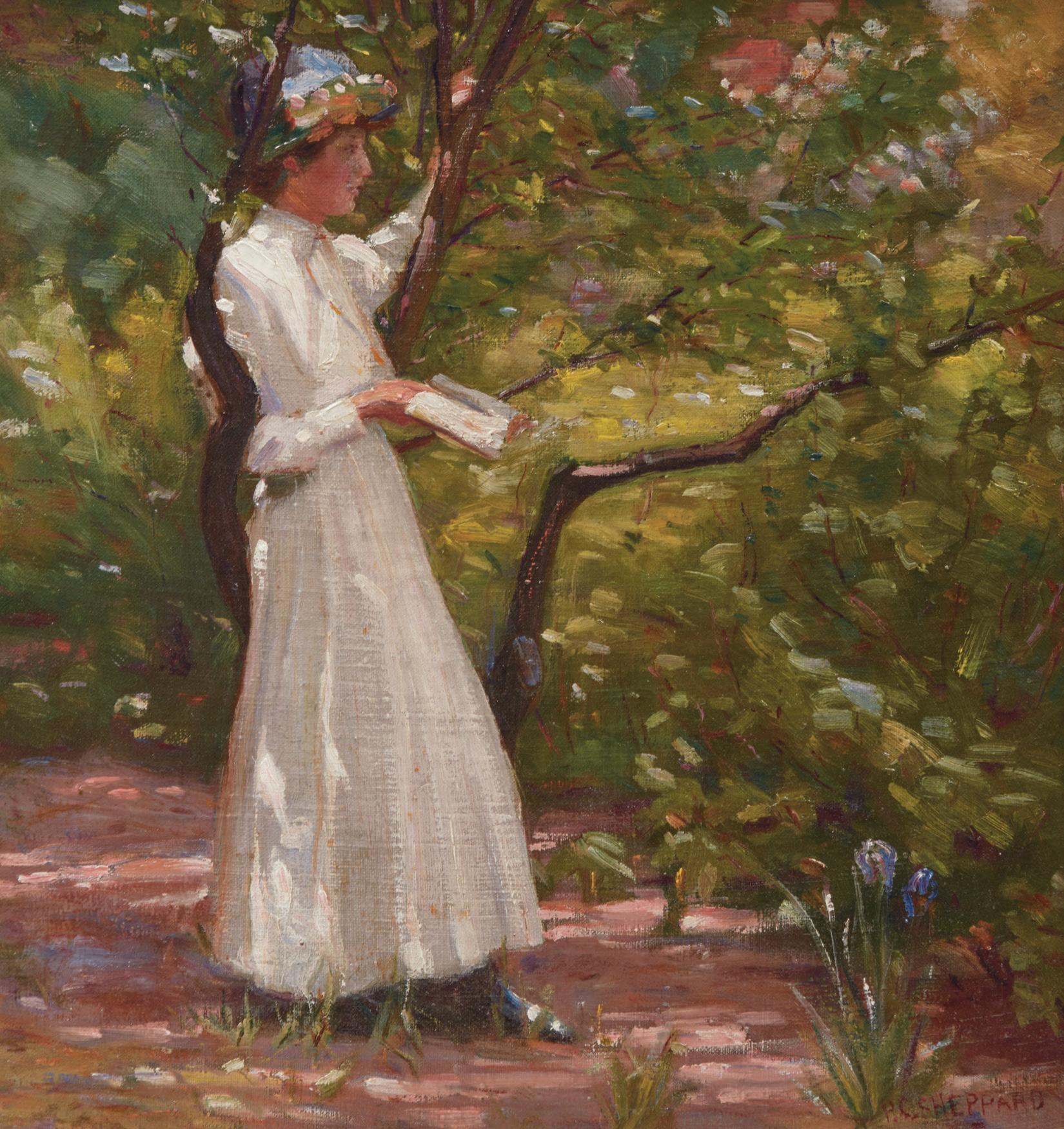
PETER CLAPHAM SHEPPARD
Woman in the Garden, The Grange, 1910 oil on canvas signed lower right 18 ins x 17 ins; 45.7 cms x 43.2 cms
PROVENANCE
Private Collection, Ontario
LITERATURE
Tom Smart, Peter Clapham Sheppard: His Life and Work , Richmond Hill, Ontario, 2018, page 58, reproduced page 60
A close associate and friend to members of the Group of Seven, P.C. Sheppard frequently accompanied his fellow painters on sketching expeditions in the city of Toronto. Often likened to the techniques of the Group of Seven, Sheppard was a pioneer in Canadian impressionism, often turning to Toronto's urban and rural landscapes with a particular preoccupation with the human presence within the landscape.
An expert in capturing varied scenes of life and industry in early to mid-century Canada, Woman in the Garden, e Grange, is a testament to Sheppard’s versatility as an artist. Sheppard's body of work covers a wide range of gural works, portraits, still lifes, landscapes, city and harbour scenes, among other subjects.
Woman in the Garden, e Grange was Sheppard's second picture of a woman at rest in her garden. e rst, Woman in a Blue Dress, bears striking similarities in composition to George Agnew Reid's Reading. Sheppard may have been inspired by the elderly painter, who was his instructor at the Ontario College of Art. Woman in the Garden, e Grange is an early picture, which shows a woman reading a book nestled between two branches of a tree. e artist's aptitude at capturing the light ltering across the scene and the rhythmic, expressive brushstrokes point to the artist's fascination with Impressionism.
$5,000–$7,000
COWLEY ABBOTT | Live Auction - Spring 2024 65
59

60JOHN GOODWIN LYMAN
The Beach, St. Lawrence Gap, Barbados oil on canvas board signed lower right; titled on the reverse 8 ins x 11.75 ins; 20.3 cms x 29.8 cms
PROVENANCE
Dominion Gallery, Montreal D & E Lake Ltd. Fine Arts, Toronto Private Collection, Toronto
EXHIBITED
John Lyman , Dominion Gallery, Montreal, 15 September-November 1963, no. 27
LITERATURE
Louise Dompierre, John Lyman, 1886-1967: I Live by My Eyes, Kingston, 1986, page 17
John Lyman has been described as an “artist in exile”, who felt more at home abroad than in his native Canada. As a result, the artist travelled extensively. Despite keeping a diary, Lyman is viewed as an enigmatic gure who was di cult to get to know. As Louise Dompierre writes, “the complexity of Lyman’s art matches that of his life. Behind an apparent directness of subject matter lurks a more ambiguous perception of humanity,” and this intricacy “permeates the most innocuous afternoons at the beach.”
Lyman’s contact with notable gures of the impressionist movement, including Morrice and Matisse, impressed upon him the importance of colour, line and form. Loose brushwork and simpli ed forms of e Beach, St. Lawrence Gap, Barbados make apparent the impressionist in uence. e St. Lawrence Gap is one of the best-known neighbourhoods in Barbados. Located along the south shore of the island, it is known for its white sand beach and vibrant nightlife.
$7,000–$9,000
COWLEY ABBOTT | Live Auction - Spring 2024 66
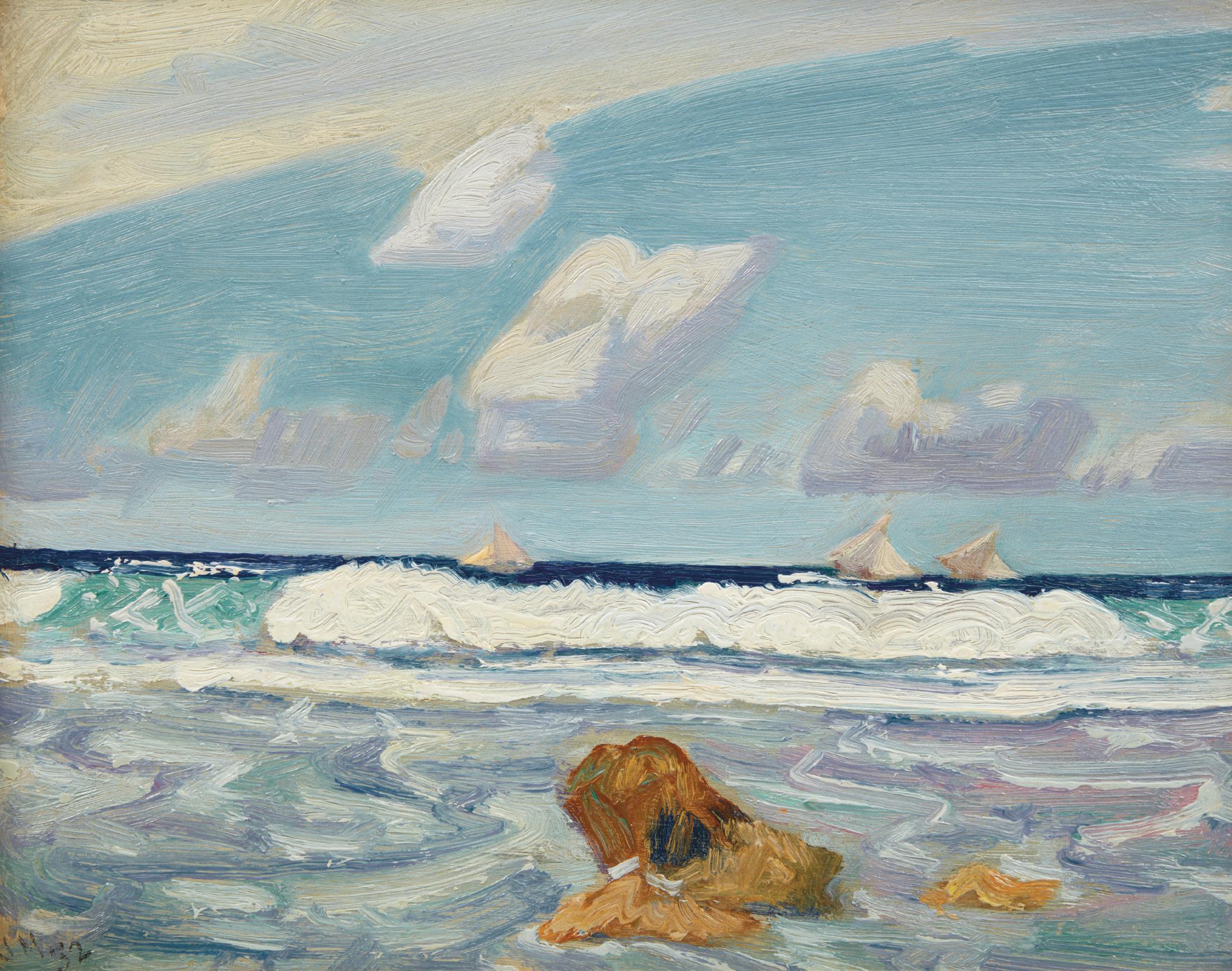
JAMES EDWARD HERVEY MACDONALD
Surf of Fishing Boats, Barbados oil on board
signed with initials and dated 1932 lower left; signed, titled and dated 1932 on the reverse
8.5 ins x 10.5 ins; 21.6 cms x 26.7 cms
PROVENANCE
Dominion Gallery, Montreal Private Collection, Toronto
Born in England, J.E.H. MacDonald moved to Canada when he was fourteen. Studying at the Hamilton Art School and eventually the Toronto Lithography Company and the Central Ontario School of Art and Design, MacDonald had early training in graphic and commercial design with an emphasis on line and proportion. is informed and was important in later years, facilitating his mode of expression in a controlled and more formal manner. From 1894, he worked as a graphic designer at Grip Ltd.
From 1922 until his death in 1932, MacDonald placed his main emphasis on the basic, monumental structure of nature, which gave further expression to his early interest in design. is beautiful image re ects the power of the ocean surrounding the island of Barbados. Waves crash upon the beach on a sunny day. Tones of blue, green and white invoke the heat of the sun and the cool of the water. Sailboats y by in the background, pushed on by the wind. e line between the dark seas and light blue sky re ects the in nity of the ocean as our viewer sits from the safety of the shore.
$15,000–$20,000
COWLEY ABBOTT | Live Auction - Spring 2024 67 61
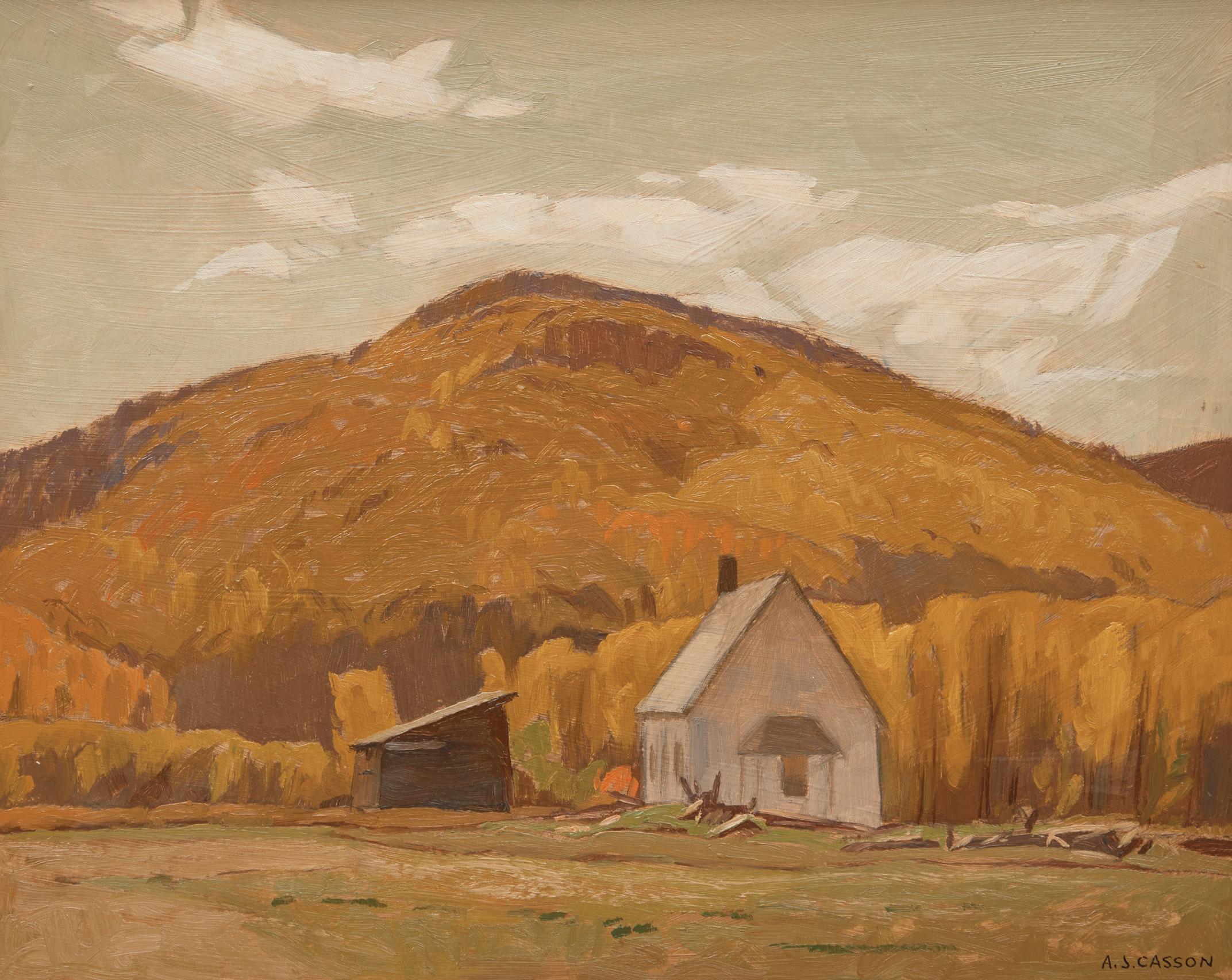
ALFRED JOSEPH CASSON
Schoolhouse at Halfway Lake oil on board
signed lower right; signed and titled twice on the reverse 12 ins x 15 ins; 30.5 cms x 38.1 cms
PROVENANCE
Private Collection, Toronto
While other members travelled all over Canada to paint, A.J. Casson dedicated himself mostly to Ontario, largely due to his career as a designer and his family in Toronto. e artist took many weekend trips to visit and paint rural and remote areas of the province, such as Schoolhouse at Halfway Lake, depicting a small town north-west of Sudbury. Casson would paint a single location over and over again at di erent times of day and in di erent seasons. As a result, Casson produced an extensive catalogue of works documenting the Ontario landscape and the unique personalities of each location he visited. is single-mindedness resulted in an intimacy with his subject matter that is stunningly evident in Schoolhouse at Halfway Lake. Casson paints an Ontario forest at the height of autumn, using his signature solid colours and a restricted palette.
is painting was completed in 1959, a few months after Casson held his rst one-man show at Roberts Gallery in March of the same year. He then had ve more solo exhibitions between 1959 and 1972. is new association with Roberts Gallery allowed the artist freedom from his commercial art career and led to a great period of artistic production for Casson from the 1960s onward.
$20,000–$30,000
COWLEY ABBOTT | Live Auction - Spring 2024 68 62

FRANKLIN CARMICHAEL
La Cloche Landscape watercolour and graphite signed and dated 1939 lower right 11.5 ins x 13.25 ins; 29.2 cms x 33.7 cms
PROVENANCE
Private Collection, Ontario
LITERATURE
Megan Bice, Light & Shadow: e Work of Franklin Carmichael, Kleinburg, 1990, page 38
Initially visiting La Cloche for social visits with family, Franklin Carmichael increasingly found artistic inspiration in the distinctive landscape he found there. e geography of La Cloche had particular appeal for the artist, with its quartzite rocks containing hues of white and pink. La Cloche became one of Carmichael’s favourite painting areas, and the artist returned regularly for the rest of his life. Carmichael’s plein-air watercolours were well suited to capturing the dramatic e ects of light and shadow on the contoured hills of the region. Carmichael strongly believed in the artistic merit of watercolour being equal to oil painting, and he asked high prices for his watercolours to re ect their status. In 1925, Carmichael founded the Canadian Society of Painters in Watercolour, with the hopes of bringing greater importance and recognition to work in the medium.
La Cloche Landscape features the iconic geography and windswept pines of Georgian Bay, rendered with con dent mastery of the uid medium. e tightly packed composition features a steady rhythm of rolling contours, from the rocky foreground to the cloudy skies. Commenting on his use of watercolour, Carmichael noted: “As a medium, it is capable of responding to the slightest variation of e ect or mood. It can be at once clean cut, sharp, delicate and forceful or subtle, brilliant or sombre, including all of the variations that lie in between.”
$30,000–$40,000
COWLEY ABBOTT | Live Auction - Spring 2024 69 63

ARTHUR HENRY HOWARD HEMING
The Hunter's Camp oil on canvas on board signed and dated 1930 lower right; titled on a partial exhibition label on the reverse 14.75 ins x 20 ins; 37.5 cms x 50.8 cms
PROVENANCE
Acquired directly from the Artist By descent to the present Private Collection, Ontario
EXHIBITED
Catalogue of the Arts, Canadian National Exhibition, Toronto, 28 August-12 September 1931
LITERATURE
Arthur Heming, Drama of the Forests, Toronto, 1921, similar work reproduced page 133
Cassandra Getty, Arthur Heming, Chronicler of the North, London, 2013, similar work reproduced page 57
Described as the “Chronicler of the North”, Arthur Heming painted idealized depictions of the Canadian wilderness, wildlife and adventures in the great white North. He was an avid sportsman as well as excelled in artistic endeavors. Heming grew up in Paris and
Hamilton, Ontario, studying at the Hamilton Art School where he would eventually teach. Heming also trained in New York and London. He was one of the rst artists to occupy the Studio Building in Toronto, which was built by Lawren S. Harris and Dr. James MacCallum in 1914. Heming held a solo show in Toronto in 1920 and the following year, ten of his paintings were purchased by the Royal Ontario Museum. Although he trained J.E.H. MacDonald in his earlier years in Hamilton, and sometimes exhibited alongside Group of Seven members, his subject and approach di ered from the Group’s style.
e Hunter’s Camp draws the viewers in to admire the thrill of the hunt from the eyes of the hunter. Posed from the brush behind, the hunter both stalks and admires the beauty of this giant, enigmatically Canadian creature. e Hunter’s Camp subtle hues of whites and yellows surround the bulk of the large brown moose. Heavy snow layers the trees and hills in the surrounding landscape. e top of a tepee is seen protruding from behind the brush. We are caught in a quiet moment for both the hunter and the hunted.
e Hunter’s Camp, 1919 (oil on canvas) was purchased by the Royal Ontario Museum of Zoology in 1922. is work, acquired directly from the artist, was displayed at the Canadian National Exhibition in 1931 and is a later re-working of the canvas in the collection of the ROM.
$8,000–$10,000
COWLEY ABBOTT | Live Auction - Spring 2024 70 64
MAUD LEWIS
Two Oxen Hauling Logs
mixed media on board
signed lower right
11.5 ins x 13.25 ins; 29.2 cms x 33.7 cms
PROVENANCE
Private Collection, Toronto
EXHIBITED
e Illuminated Life of Maud Lewis: An Exhibition of the Nova Scotia Folk Artist (1903-1970), Art Gallery of Nova Scotia, Halifax; travelling to the Canadian Museum of Civilization, Gatineau; Glenbow Museum, Calgary; John B. Aird Gallery, Toronto; Manitoba Museum of Man and Nature, Winnipeg; Art Gallery of Greater Victoria; Beaverbrook Art Gallery, Fredericton; Confederation Centre Art Gallery and Museum, Charlottetown; Galerie d'art de l'université de Moncton and the Art Gallery of Newfoundland and Labrador, 28 January 1997-31 October 1999, no. 85
$25,000–$35,000
66
MAUD LEWIS
The Old Schoolhouse mixed media on board signed lower right
11.75 ins x 13.75 ins; 29.8 cms x 34.9 cms
PROVENANCE
Zwicker's Gallery, Halifax Private Collection, United States
$25,000–$35,000
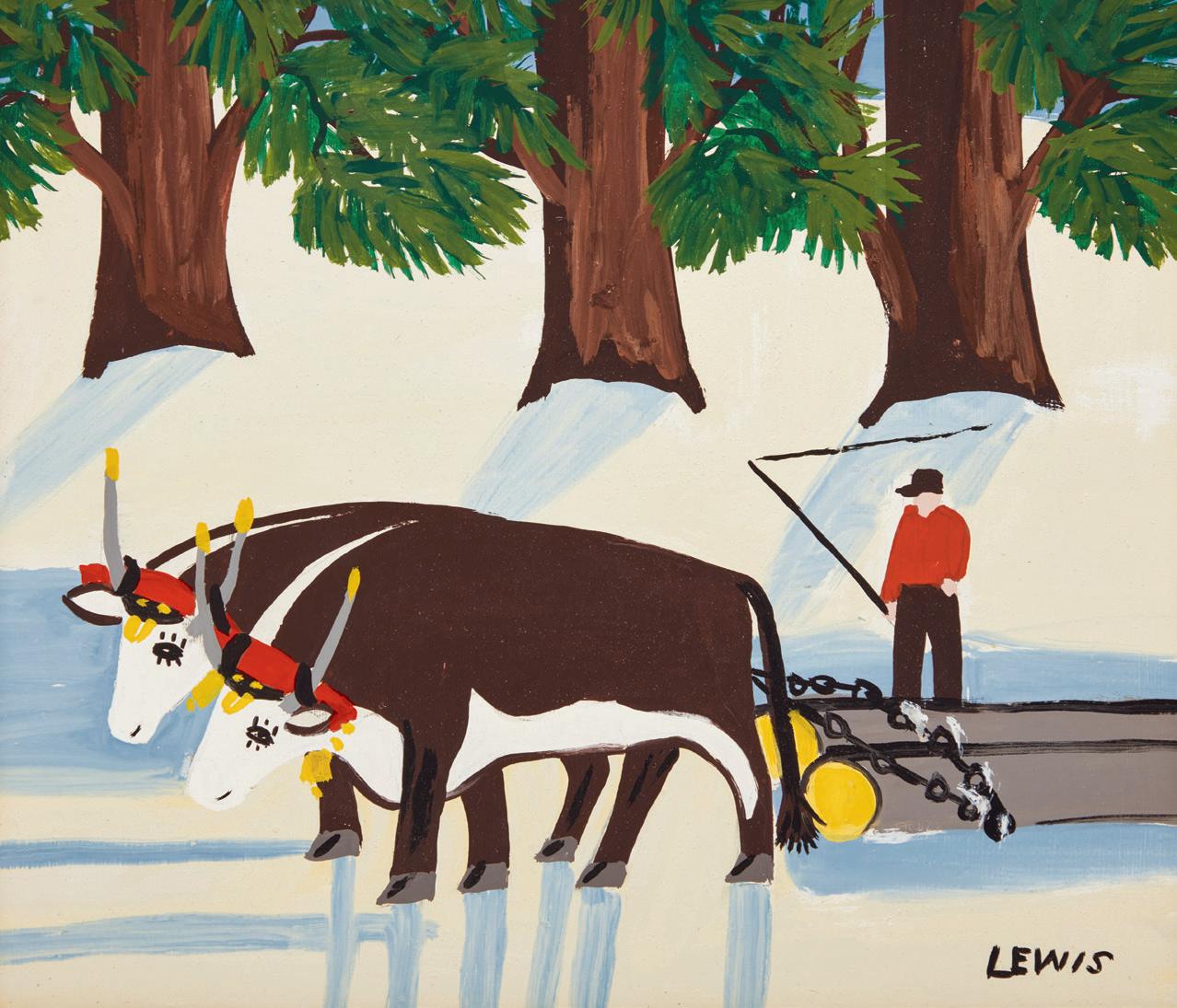

COWLEY ABBOTT | Live Auction - Spring 2024 71
65
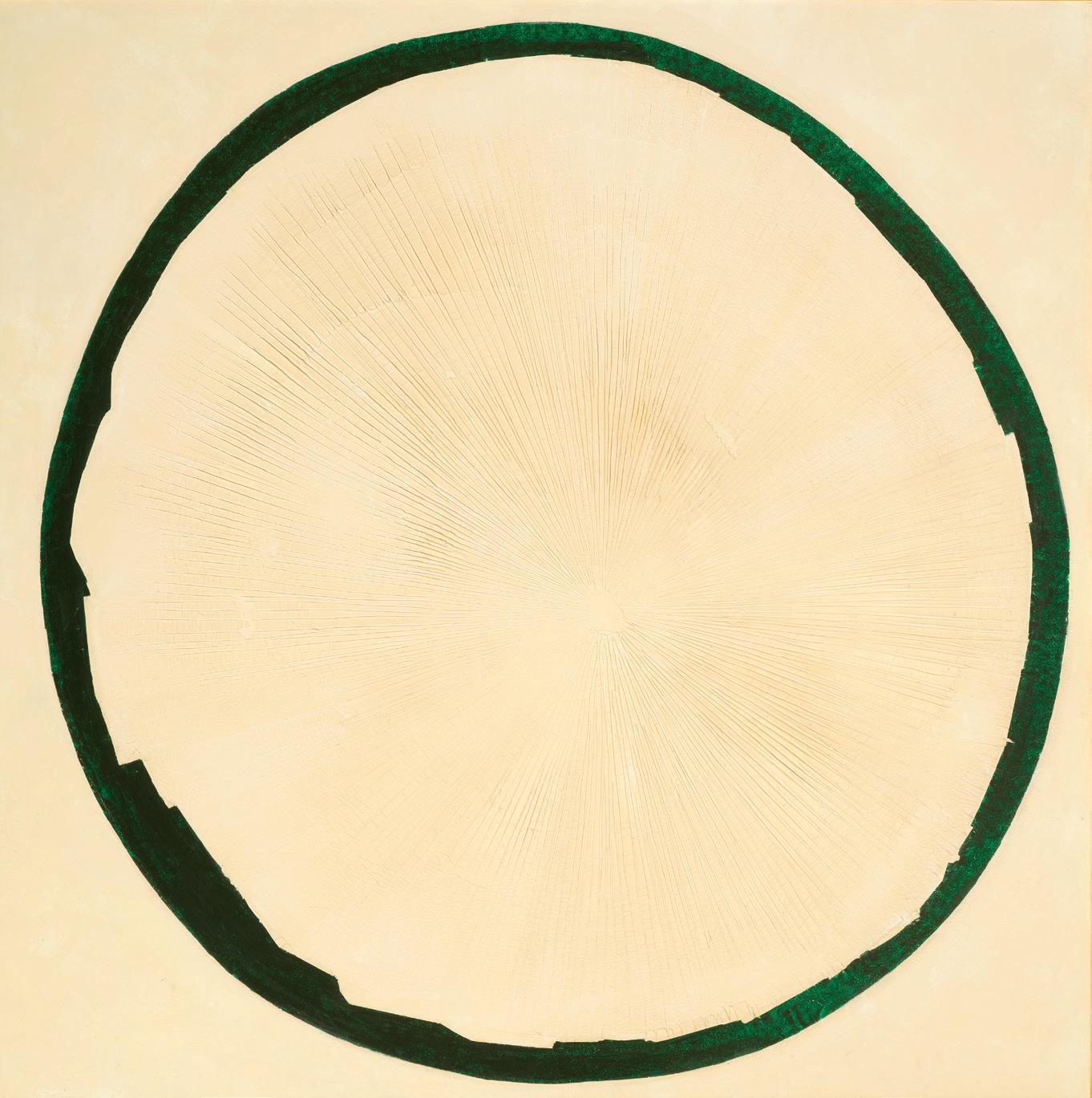
RONALD LANGLEY BLOORE
White Sun-Green Rim, 1960 oil on board
dated "May-June 60" on the reverse, titled and dated "1960" to the stretcher, titled to three labels on the reverse 48 ins x 48 ins; 121.9 cms x 121.9 cms
PROVENANCE
Here and Now Gallery, Toronto Private Collection, Ontario
EXHIBITED
VI Biennial, Museum of Modern Art, São Paulo, Brazil, September-December 1961, no. 5 as White Sun , 1961
Ron Bloore, Here and Now Gallery, Toronto, 1-19 March 1962
Canadian Painting, e Tate Gallery, London, England, 1964
R.L. Bloore-Sixteen Years: 1958-1974, London Art Gallery; travelling to the Agnes Etherington Art Centre, Kingston; Musée d’art contemporain, Montreal; the Winnipeg Art Gallery; the Vancouver Art Gallery; the Norman Mackenzie Art Gallery, Regina and the Art Gallery of Windsor, 3 February-23 November 1975, no. 12 e Crisis of Abstraction in Canada: e 1950’s, Musée du Quebec; travelling to National Gallery of Canada, Ottawa; Mackenzie Art Gallery, Regina; Glenbow Museum, Calgary and Art Gallery of Hamilton, 18 November 1992-30 January 1994, no. 13 as White SunGreen Rim , 1960
LITERATURE
VI Biennial, Brazil, 1961, no. 5, listed page 150 as White Sun , 1961
Ted Fraser, R.L. Bloore-Sixteen Years: 1958-1974, Windsor, 1975, no. 12, unpaginated, reproduced as White Sun-Green Rim
Denise Leclerc, e Crisis of Abstraction in Canada: e 1950s, Ottawa, 1992, no. 13, reproduced page 91
In 1958, Ronald Bloore, then the director of the Norman Mackenzie Art Gallery (now MacKenzie Art Gallery) in Regina, brought national and international exhibitions to Regina. He and four other abstract painters, Kenneth Lochhead, Arthur McKay, Douglas Morton and Ted Godwin shared a common professional commitment and became a small but active artistic community in Regina. Having studied throughout Canada, the United States, and Europe before moving to Regina, the artists combined the major currents of abstract expressionism in the context of 1950s Saskatchewan. eir bold, non- gurative paintings represented a new direction in abstract painting in Western Canada and re ected the in ux of advanced ideas discussed in the annual Emma Lake Artists' Workshops, especially the workshop held by Barnett Newman in 1959. e painters drew national attention when Bloore organized e May Show ; in 1960, featuring the ve prominent abstract artists and architectural drawings and models by architect Cli ord Wiens, along with sculptures by Wolfram Niessen, to coincide with the meeting of the Canadian Museums Association. e exhibition inspired Richard B. Simmins, Coordinator of Extension Services at the National Gallery of Canada, to select the work of the ve painters for a travelling exhibition titled Five Painters from Regina that appeared in 1961 in Ottawa. Simmins' essay in the exhibition catalogue stressed the importance of Emma Lake Workshops and of Ron Bloore, who acted as a catalyst. Simmins wrote that Bloore brought to Regina a set of values which challenged the other painters. Bloore painted White Sun-Green Rim in 1960, when he was in the spotlight and during the height of the anticipation of the exhibition of the group who would become known as “ e Regina Five”. Perhaps as a result of this increased attention, this painting was extensively exhibited in Canada and abroad as soon as it was completed, going to the VI Biennial in São Paulo in the fall of 1961, the National Gallery of Canada in 1962, and the Canadian Painting show at the Tate Gallery in London, England in 1964.
$10,000–$15,000
COWLEY ABBOTT | Live Auction - Spring 2024 72
67
68
JOHN MEREDITH
Bengal 1
oil on canvas signed and dated 1962 lower right; signed, titled and dated "July 62" on the stretcher 42 ins x 52 ins; 106.7 cms x 132.1 cms
PROVENANCE
Isaacs Gallery, Toronto e Women's Committee of the Art Gallery of Toronto
e Collection of Dennis Reid, Toronto
EXHIBITED
Canada art d’aujourd’hui , Musée National d’Art Moderne, Paris, 12 January-18 February 1968, no. 38 as Bengale 1, 1962
LITERATURE
Canada art d’aujourd’hui , France, 1968, no. 38, unpaginated, reproduced
John Meredith had little interest in formal theories but worked instinctively and experientially, drawing from inner resources. Many of his early works of the late 1950s were executed with a vigorous palette knife impasto. Drawing was always central and crucial to Meredith’s work, developing a personal calligraphic vocabulary. Bengal 1, dating to 1962, demonstrates Meredith’s shift away from sombre colours to more bright and linear compositions. e artist had recently held his second solo show in 1961 at Toronto's Isaacs Gallery. e exhibition was favorably reviewed in the Toronto Star and he joined the Isaacs Gallery in 1962.
is artwork, as well as lot 69, are from the Collection of the late Dennis Reid, esteemed academic, author and curator.
$7,000–$9,000



JOHN MEREDITH
Untitled (Study for Bengal 1) oil on canvas; signed and dated 1962 lower right; signed, titled and dated "July 62" on the stretcher 11.5 ins x 18.75 ins; 29.2 cms x 47.6 cms
PROVENANCE
Isaacs Gallery, Toronto
e Women's Committee of the Art Gallery of Toronto
e Collection of Dennis Reid, Toronto $2,000–$3,000
COWLEY ABBOTT | Live Auction - Spring 2024 73
69
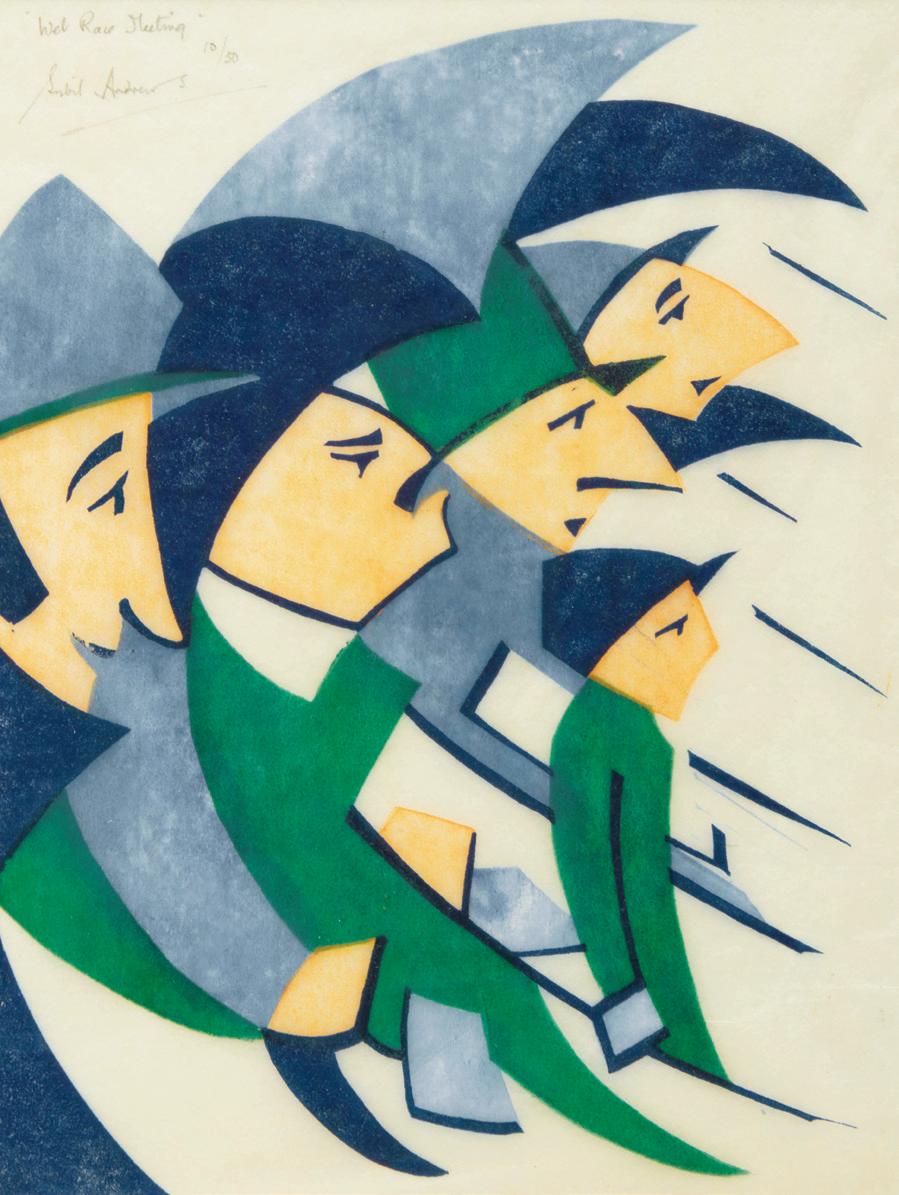
70
SYBIL ANDREWS
Wet Race Meeting
colour linocut
signed, titled and numbered 10/50 upper left 9.25 ins x 6.75 ins; 23.5 cms x 17.1 cms
PROVENANCE
Masters Gallery, Calgary, circa 1978
Private Collection, Calgary
LITERATURE
Peter White, Sybil Andrews: colour linocuts/linogravures en couleur, Calgary, 1982, illustrated page 51 ( gure 8)
English-born artist and renowned printmaker Sybil Andrews studied at Heatherley’s School of Fine Art and the Grosvenor School of Modern Art in London. It was at e Grosvenor that Andrews developed a keen interest in the medium of coloured linocuts. Although she had experimented in other mediums–such as etchings, paintings, and monotypes–linocutting was prized for its simple tools and materials, making it economical and particularly appealing to the young artist’s modest budget. From 1929 to 1938, she created a number of linocuts depicting agricultural life and sporting themes in England at the time. Preferred subjects were horse racing and jumping, hunting and rowing crews, and speedway riders. Wet Race Meeting depicts the human activity that is present on the sidelines of a horse race on a rainy day. Andrews was in uenced by the prevailing art movements of her time, predominantly Vorticism and Futurism, in its cubist-inspired design and repeating forms.
$20,000–$30,000
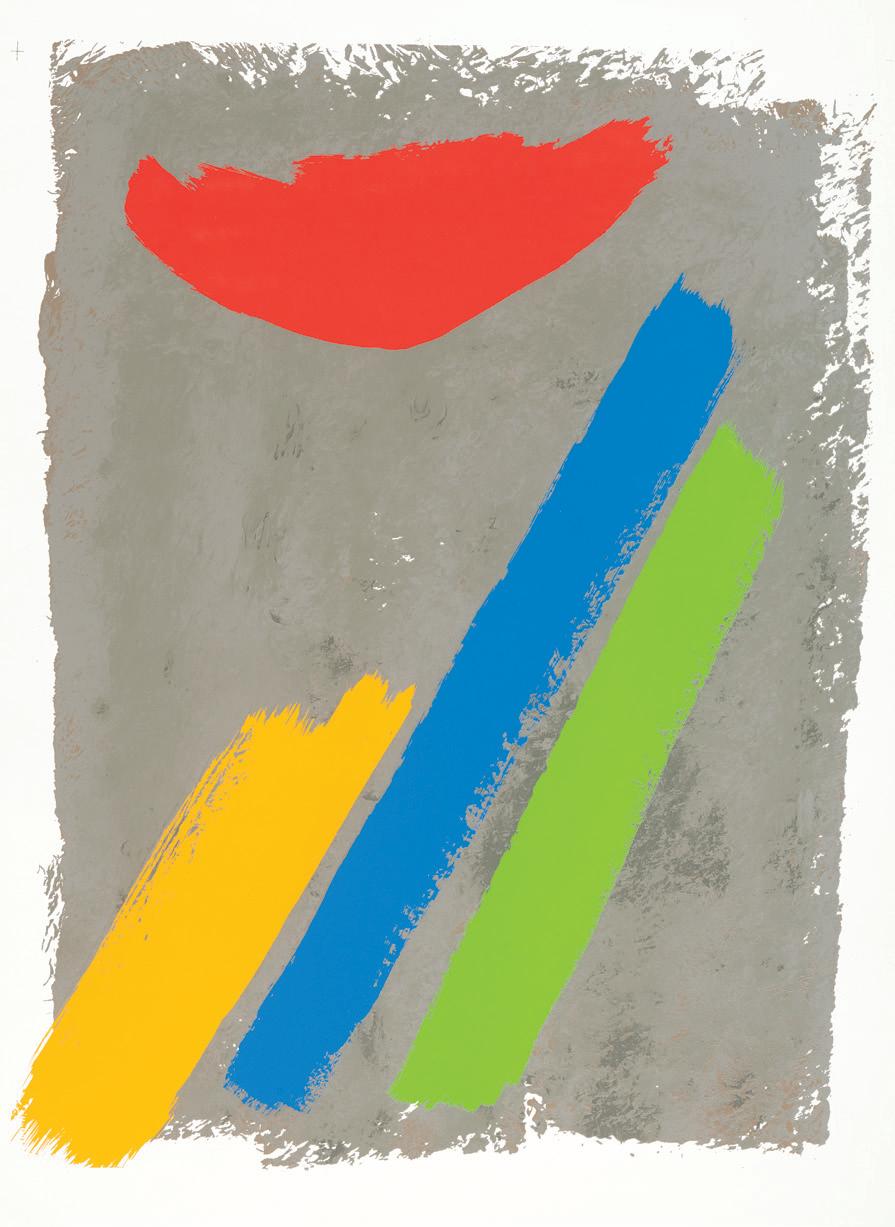
71
JACK HAMILTON BUSH
Low Sun
colour silkscreen
dated 1971 and inscribed "H.C." and "PR 12" on the reverse 40.25 ins x 27.25 ins; 102.2 cms x 69.2 cms
PROVENANCE
e Artist
Gift of the Artist to Terry Bush, Toronto (Son of the Artist)
is silkscreen was part of the collection of Jack Bush and was the work which the artist used for nal approval of the run of the Low Sun series. is artwork is one of four hors d’commerce proofs.
$7,000–$9,000
COWLEY ABBOTT | Live Auction - Spring 2024 74
DAVID LLOYD BLACKWOOD
Fire Down on the Labrador colour etching and aquatint signed, titled, dated 1980, editioned "Artist's Proof 10/10" and inscribed "Ed. 50" in the lower margin
31.5 ins x 19.75 ins; 80 cms x 50.2 cms
PROVENANCE
Acquired directly from the Artist Private Collection, Ontario
David Blackwood was born in Wesleyville, on the coast of Bonavista Bay, in Newfoundland. Following his studies at the Ontario College of Art, Blackwood launched his decades-long career. e National Gallery of Canada purchased etchings by the artist when he was only twenty-three years old. Awarded the Order of Canada in 1993, Blackwood is now celebrated as one of the country’s most acclaimed printmakers.
Blackwood’s most famous etching Fire Down on the Labrador depicts a terrifying maritime disaster, with a ship a ame and the crew eeing aboard a small lifeboat. However the picture is utterly dominated by the enormous whale submerged in the icy waters and visible to the viewer but not to the shermen. Here, the human scene is dwarfed by immense, unfathomable forces of nature. Blackwood has based this work on a narrative with personal roots. Raised in a seafaring Newfoundland family, both the artist’s father and grandfather were ship captains. Blackwood was very aware of the grave threat to every mariner presented by the risk of a grease re in the gallery of a schooner. e crew could be faced with the worst possible scenario, being forced to abandon ship, and left to the cold isolation of a brutal environment.
$60,000–$80,000

COWLEY ABBOTT | Live Auction - Spring 2024 75 72


73
KIM DORLAND
Parklife
oil, acrylic and spray paint on canvas signed, titled and dated 2007 on the reverse; unframed 60 ins x 72 ins; 152.4 cms x 182.9 cms
PROVENANCE
Bonelli Arte Contemporanea, Mantova
Galleria Ambrosiana Casa D'Aste, auction, Milan, 3 May 2022, lot 10
Private Collection, Montreal
$20,000–$30,000
74
WILLIAM PEREHUDOFF
AC-80-27
acrylic on canvas signed, titled and dated 1980 on the reverse 55 ins x 49.5 ins; 139.7 cms x 125.7 cms
PROVENANCE
Private Collection, Toronto
Since the 1960s, Saskatchewan artist William Perehudo has ranked among the central gures of abstract painting in Canada. Involvement in the famed Emma Lake Workshops brought Perehudo into contact with in uential modernists, including Kenneth Noland, Donald Judd and Anthony Caro. A restless innovator, Perehudo maintained a proli c output in the 1980s, continuously experimenting with the wide range of potential qualities of acrylic paint. e use of gel mediums allowed him to layer thinned veils of colour with glossy, opaque layers of impasto. e at plains and expansive skies of the Canadian prairies appear to have in uenced Perehudo ’s sense of composition. AC-80-27 features a visually compelling range of surfaces, from the soft, neutral underpainting to the delicate pinkish frosting, to the bursts of coloured forms which act as focal points for the viewer’s gaze. Closely associated with the Colour Field movement, Perehudo ’s bold compositions can be found in numerous public and private collections, including that of the National Gallery of Canada, the Montreal Museum of Fine Art, and the Art Gallery of Ontario.
$20,000–$30,000
COWLEY ABBOTT | Live Auction - Spring 2024 76

75
WILLIAM KURELEK
Death Fears Him Who Resists Her mixed media on board signed upper left and titled in Cyrillic upper left 6.5 ins x 13.25 ins; 16.5 cms x 33.7 cms
PROVENANCE
Sandy Murrich Den Art Gallery, Ottawa Private Collection, Ontario
LITERATURE
Patricia Morley, Kurelek: A Biography, Toronto, 1986, pages 290, 291, 332
William Kurelek pictures himself lying supine along the bottom fth of this small undated painting. His body has been cropped, made to resemble the thin terrain that stretches across so many of his Prairie landscapes. It is also serves as a stage on which a diminutive, translucent version of himself engages in sticu s with a retreating personi cation of death. A worn, clinical, geometric tile is their battle’s backdrop. At top left, in pencil, the artist has written in Ukrainian Cyrillic, “Death Fears Him Who Resists Her.”
In late September 1977 Kurelek had been admitted to Toronto’s St. Michael’s Hospital. Unable to stand on his own, pale and coughing, the symptoms were dire and had taken him by surprise. As a devout Christian, Kurelek believed death should be faced with joy and courage; and yet as a successful and driven artist with a family, he was also a man who, as his biographer Patricia Morley puts it, “very much wanted to live.” Death Fears Him Who Resists Her, possibly the last painting completed in the early days of his hospitalization, certainly shows that determination.
e painting’s tone, however, also reveals something less creedal and more idiosyncratic about Kurelek’s feelings toward his own mortality. It is not surprising that, as a Roman Catholic, he would have represented his soul as embodied. e feminization of death is consistent with Kurelek’s Slavic heritage. More disarming is the combination of bathetic humour and tenderness we nd in the image. ere is a Punch-and-Judy quality to this existential showdown but, of course, it’s Kurelek’s act of literally painting on his deathbed that is the real act of resistance, the last act. He died on November 3, 1977.
We extend our thanks to Andrew Kear, Canadian art historian and Head of Collections, Exhibitions and Programs at Museum London for contributing the preceding essay. Andrew is the past Chief Curator and Curator of Canadian art at the Winnipeg Art Gallery, a Curator of the 2011/2012 national travelling exhibition William Kurelek: e Messenger and author of the Art Canada Institute’s William Kurelek: Life & Work , available at www.aci-iac.ca.
$20,000–$30,000
COWLEY ABBOTT | Live Auction - Spring 2024 77
IMPORTANT INTERNATIONAL ART
ANDY WARHOL
Mick Jagger (F&S II.144) 157/250 screenprint on Arches Aquarelle (Rough) paper signed by the artist, numbered 157/250 and signed by Mick Jagger in the lower margin; printed by Alexander Heinrici, New York; published by Seabird Editions, London, England, with their inkstamp on the reverse 43.5 ins x 29 ins; 110.5 cms x 73.7 cms
PROVENANCE
Private Collection, Toronto
LITERATURE
Kynaston McShine, Andy Warhol: A Retrospective, New York, 1988, pages 430 and 74 Frayda Feldman and Jörg Schellmann, Andy Warhol Prints: A Catalogue Raisonné 1962-1987, 4th edition, Milan, 2003, catalogue no. II.144 Gregor Muir and Yilmaz Dziewior, Andy Warhol, London, 2021, page 47
As one of the most in uential artists of the twentieth century, Andy Warhol enjoys an enviable position within the art world, celebrated for pioneering the standards of creative expression. e diversity of his subject matter is astounding. He captured the most illustrious gures of his generation, from artists like Robert Rauschenberg and David Hockney to stars like Mick Jagger and Elizabeth Taylor, politicians including President Nixon and Chairman Mao Zedong, to athletes such as Wayne Gretzky and Muhammad Ali.
e process of creating these iconic portraits was a complex one. While the physical setting was nondescript, Warhol used a Polaroid Big-Shot camera, whose xed depth of eld forced him to experiment with distance, typically less than a metre away. e artist would have chatted away while giving various instructions to his subject. He would develop over a hundred Polaroids from these sessions but only keep four or ve. He would alter the composition and contrast, the mouth and nose, balancing the proportions and retouching any visible blemishes. As Stephan Diederich, Curator at the Museum Ludwig in Cologne describes, Warhol's portraits: “clairvoyantly anticipate today’s increasing demands for constant self-publicising, with people capturing their every obsession, eeting moment, revelation and deception, their image shaped by social media, but through his foresight, irony and empathy he also pointed the way to an approach that might work in response.”
Unlike the previous series with Marilyn, 1967 (II.22–31) and Mao, 1972 (11.90–99), where Warhol had to rely on stock photographs of his subjects, he instead took the pictures himself while the singer resided at his house in Montauk, in Long Island. He had, therefore, many examples to choose from. Mick gamely performed for the camera, appearing focused, de ant, laughing, or pensive. Based on these initial Polaroids, Warhol would portray the exuberant singer in ten poses for his portfolio.
Here, Mick is nonchalant and de ant: with an upturned chin, sidelong glance, and bare upper torso, a visually charged and intense image emerges. in drawing lines further draw the viewer’s attention to the subject’s main physical attributes, tracing the shape of his lush lips, arched neck, angular nose, and piercing gaze. For the 1989 retrospective exhibition held at the Museum of Modern Art, Mick would describe his participation in Warhol’s celebrity series as “a very painless exercise for me. It was fun staying up all night signing the lithographs.”
In 1975, Warhol developed a technique that would become the standard of his late style, using blocks of coloured graphic art paper with halftones and drawing lines. is collage-like e ect would appear not only in the prints of Mick Jagger (II.138–147) but also in those of Paloma Picasso (II.121) and Ladies and Gentlemen (II.126–137). From Warhol’s Polaroid photograph, a drawing would be traced and chosen before being photographed, printed and made into a screen. Interestingly, the line would take on a dappled quality once printed on the Arches paper. Torn paper was also superimposed on the stylized linear drawing, mimicking the photographic image. For the Mick Jagger series, he would tear Color-Aid paper–an a ordable medium used by graphic designers–before gluing the fragments onto the surface of a full-scale collage maquette, serving as a backdrop for a screened image, like in the present work.
e replicatory nature of Warhol’s oeuvre ultimately helped democratize the established hierarchy of art by immortalizing celebrities, commodities, deaths, and disasters alike through photography, painting and screenprinting. By erasing the so-called unapproachability of the rich and famous, the Pop iconoclast made his subjects more accessible than ever before to a broader audience.
$140,000–$180,000
COWLEY ABBOTT | Live Auction - Spring 2024 78 76

COWLEY ABBOTT | Live Auction - Spring 2024 79
SHEPARD FAIREY
Obey Giant Star acrylic on canvas signed and dated 1998 lower right; unframed 48 ins x 36 ins; 121.9 cms x 91.4 cms
PROVENANCE
Acquired directly from the Artist Private Collection, United States
Born in 1970 Shepard Fairey is a contemporary American street artist and activist who has blurred the lines between commercial and traditional art. He rst came to prominence in the late 1980s through the André the Giant Has a Posse sticker campaign before cementing his place on the international art scene with his 2008 Hope poster of then President-elect Barack Obama. Originating from the underground skating scene, Fairey understood the importance of images in modern society, whether to convey information, manipulate ideas or raise awareness.
Obey Giant Star was given to the current owner by the artist as a gift for helping with printing posters earlier in his career. We extend our thanks to Shepard Fairey for providing the following description of this unique work:
“ e canvas is based on the very rst image I made of the Obey Giant star in January of 1996. January of 96 was when I developed the clean icon face, the star, the three-face vertical lmstrip series, and the three-face horizontal series. I had been really interested in moving my work away from a direct reference to Andre the Giant, the wrestler, and towards a more streamlined, iconic, Big Brother-esque image for the face. And this was fueled by my love of Russian constructivist art, especially Alexander Rodchenko and the Sternberg brothers, their work that was really, really advanced for work that was happening in the, you know, around 1920, the late teens to the early 20s. And the other reason that, other than just the aesthetics that I liked that work was that I knew that Americans had, you know, a conditioned fear of anything that seemed communist because of all the Cold War stu . And they had a fear of anything that seemed like communist propaganda. And I found it amusing that people would fear that kind of propaganda, but American propaganda, which was, you know, frequently advertising, was not something they had any fear over, even though that was more of a direct threat to them than communist propaganda stu
So, you know, there was an aesthetic and a conceptual consideration. When I developed the original streamlined Andre face, the way I did it was I took a sheet of Rubylith, which is a screen-printing graphic arts tool that’s translucent. It’s red gelatin on a clear acetate backing. And you can see through it. So, I just put that over the original Andre face and did a streamlined illustration of one half of the face. And then I ipped that over and xeroxed it so that I could make a symmetrical merging of the two. I did not know how to use the computer when I created all these icon face variations. So, the rst iteration of the star was created by cutting a star-shaped window out of a sheet of paper and then moving it around over the illustration of the face that I had made, which I turned symmetrical, which included, you know, the entire outside of the head and the ears and everything. But it looked kind of goofy when it was just a really smooth egg-shaped head. But what I found was when I cropped the face, I cropped it into a rectangle or a star, it achieved the more ominous, mysterious, big brother look that I was hoping for.
So, after a couple of years of him helping me to print posters without asking for any money because he knew that I was broke and I gave him prints and that was all the payment he was interested in, he asked if I’d be willing to make him a painting of the star image. Oh, okay. So, I did, and the painting was created, and it’s the only one of that iteration of the star that exists as executed in that way. I have done other painted iterations of the star, but this is the only one done on a white canvas with acrylic brush paint.
For this, I just projected the image onto the canvas, transferred it with pencil, and painted it in with black and red acrylic paint. And the reason that I did the giant instead of all the fussy type that’s in the original poster is one, that he wasn’t into it just saying obey giant, but two, it was gonna be a lot more tedious technically to put in all that type transferred with pencil from a projector. So, this is a little bolder, a little more simple, but this is the only iteration of that painting that exists. And so, I think it’s a pretty special piece for that reason. It’s from an era when I hadn’t started to do the collage backgrounds and the stencil mixed media paintings. So, it’s just pencil and paintbrush and acrylic paint and paintbrushes on a white canvas.”
$65,000–$85,000
COWLEY ABBOTT | Live Auction - Spring 2024 80 77

COWLEY ABBOTT | Live Auction - Spring 2024 81

78
THEO TOBIASSE
L'homme qui danse possède une âme oil on canvas signed middle left and titled upper right 28.75 ins x 36.25 ins; 73 cms x 92.1 cms
PROVENANCE
Marion Scott Gallery, Vancouver
Acquired from the above by the present Private Collection, Vancouver He el, auction, Toronto, 3-31 October 2019, lot 531 Private Collection, British Columbia
LITERATURE
Catherine Tobiasse, Tobiasse: 50 ans de peinture: Catalogue raisonné de l'oeuvre peint, Milan, 2024, catalogue no. 02194
Born in Israel and brought to Paris as a child, eo Tobiasse lived in solitary con nement through the German occupation during the Second World War. e survival of his Jewish family would prove to be an enduring source of inspiration for him, with many of his works exploring the theme of exile and alienation from Judaism. A crowd of Jewish men wearing long button coats dance joyously. With their arms raised into the air, they lift the gure of a rabbi. While the background is simple, combining murky brown and grey tones, the Notre-Dame Cathedral, with its ying buttresses, towers and spire, rises in the distance alongside the iconic Hausmannian buildings. Despite examining childhood memories steeped in fear and isolation, Tobiasse presents a vision of hope for humanity.
$12,000–$16,000

79
AGNES MARTIN
Untitled lithograph signed lower right 11 ins x 11 ins; 27.9 cms x 27.9 cms
PROVENANCE
Acquired directly from the Artist Private Collection, Montreal
LITERATURE
Dieter Schwarz, Agnes Martin Writings, Ost ldern-Ruit, 2005, page 29
Born in Canada, Agnes Martin moved to New York at the invitation of New York City gallerist Betty Parsons in 1957, where she settled in Coenties Slip in Lower Manhattan. ere she became acquainted with some of the artists that Parsons represented, including Ellsworth Kelly, Robert Indiana, Jack Youngerman and Ad Reinhardt, among others.
A proli c artist and writer, Martin has described the importance of grids in her work: “My formats are square, but the grids never are absolutely square; they are rectangles, a little bit o the square, making a sort of contradiction, a dissonance, though I didn’t set out to do it that way. When I cover the square surface with rectangles, it lightens the weight of the square, destroys its power.”
A gift from the artist to the present owner, this rare early lithograph by Agnes Martin was created in the early 1960s when she began showing at the Robert Elkon Gallery in New York. Even when the medium of the lithograph is employed, as in the present lot, Martin’s minimalist abstract grid carries the same intentions as in any of her larger canvases.
$8,000–$10,000
COWLEY ABBOTT | Live Auction - Spring 2024 82

80DAVID HOCKNEY
Celia (La Bergère) (from Eight Lithographs to Beneft the Foundation for Contemporary Performance Arts, Inc. Portfolio) (Gemini 955) 8/50 lithograph signed, dated 1981 and numbered 8/50 in the lower margin with blindstamps; titled “Celia”, dated and numbered on a gallery label on the reverse; printed by Gemini G.E.L., Los Angeles; co-published by Foundation for Contemporary Performance Arts, Inc., New York, and Gemini G.E.L., Los Angeles 24 ins x 35 ins; 61.0 cms x 88.9 cms
PROVENANCE
Arij Gasiunasen Fine Arts, Palm Beach Private Collection, Toronto
LITERATURE
Gemini G.E.L., A Catalogue Raisonné, 1966-2005, Washington, 2018, catalogue no. 23.78, n.p. [online publication]
Sarah Howgate and Barbara Stern Shapiro, David Hockney Portraits, London, 2006, page 222
“Celia has a beautiful face, a very rare face with lots of things in it which appeal to me. It shows aspects of her, like her intuitive knowledge and her kindness, which I think is the greatest virtue. To me she’s such a special person.”
David Hockney and the fashion and textile designer Celia Birtwell met through a mutual friend, Mo McDermott, in the mid-1960s. ey became lifelong friends, and over the course of six decades, she often modelled for the English artist. Numerous portraits in various poses, therefore, appear throughout Hockney’s oeuvre, featuring her as his muse.
In Celia (La Bergère), wearing a black skirt, matching fedora and stylish shirt, Hockney’s shepherdess leans nonchalantly on her left arm, head turned in pro le, gazing o into the distance.
$15,000–$20,000
COWLEY ABBOTT | Live Auction - Spring 2024 83

WILLIAM KENTRIDGE
Drawing for the flm “Medicine Chest ” charcoal and pastel on paper signed lower right, with annotations in the top right; titled “ Drawing from the Medicine Chest ” and dated 2000 on a label a xed to the reverse; further titled Drawing from 'Medicine Chest' (Landscape) on another label a xed to the reverse
46 ins x 31 ins; 116.8 cms x 78.7 cms
PROVENANCE
Private Collection, Florida
EXHIBITED
William Kentridge, Hirshhorn Museum, 28 February-13 May 2001; travelling to the New Museum of Contemporary Art, New York, 3 June-16 September 2001; Museum of Contemporary Art, Chicago, 20 October 2001-20 January 2002; Contemporary Arts Museum, Houston, 2 March-2 May 2002; Los Angeles County Museum of Art, Los Angeles, 21 July-6 October 2002; South African National Gallery, Johannesburg, 7 December 2002-23 March 2003
LITERATURE
Lilian Tone, William Kentridge: Fortuna , London, 2013, page 102 William Kentridge, William Kentridge, London, 1999, page 126
Born in Johannesburg during the apartheid era, William Kentridge’s multifaceted practice explores the personal and political to o er an ever-evolving ow of narratives through creation, disassembly, or erasure. His proli c output spans two decades across various media: lm-making, sculpture, printmaking, artist’s books, performances, tapestries, opera, and theatre productions.
is charcoal drawing is for the lm Medicine Chest, a projection installation where the artist used a medicine chest and replaced its mirrored back with a screen to show an animation of various drawings. e subject’s format strongly resembles newspaper billboards in Johannesburg that present daily headlines. is found screen, or écran trouvé, showcased drawings depicting personal and household objects stacked in three rows, as in a cabinet. ey also featured self-portraits, written instructions, newspaper ybills, and landscape drawings, as is shown in the present work. Kentridge explains: “ e interest is in nding the visual evocation of the incoherent and contradictory ways we construct a sense of ourselves. e drawings of the still lifes themselves refer back to the still lifes of Chardin, Morandi and Philip Guston.”
Here is depicted a barren, post-industrial landscape reminiscent of the southeastern outskirts of Johannesburg that Kentridge became familiar with in the 1980s while driving around the countryside in search of dramatic landmarks to sketch. With a soft chamois leather dipped into charcoal dust, he would swipe across a white sheet of paper to record these eerie landscapes.
e present composition is divided into three rows, with a large billboard dominating the rst register, evoking the industrial structures of his native country. As is typical of Kentridge’s lms, billboards are omnipresent, featuring prominently in Other Faces and Johannesburg–Second Greatest City after Paris. Pylons and amorphous forms dot the middle row, while the unpopulated section at the bottom appears to stretch towards the horizon with an assortment of derelict objects amassed in the foreground. Kentridge’s vast, desolate roadside views are haunting, revealing an un inching vision of South Africa devoid of romantic overtones.
His investigation of the nature of landscape ultimately emphasizes the relationship between our perception of the world and our fallible recollection of the past, which Kentridge describes as “the di culty we have in holding onto passions, impressions, ways of seeing things, the way that things which seem to be indelibly imprinted on our memories still fade and become elusive, is mirrored in the way in which the terrain itself cannot hold onto the events played out upon it.”
In 2025 Kentridge will join the roster of Hauser & Wirth while continuing to exhibit at Galleria Lia Rumma in Naples after being represented for over two decades by Marian Goodman Gallery. His works have been featured in major exhibitions, including the MFA Houston, Texas; the Broad Museum, Los Angeles; the Royal Academy, London, and the Kunstmuseum Basel, Switzerland. He has also presented at Documenta and the Venice Biennale on multiple occasions over the years.
$80,000–$120,000
COWLEY ABBOTT | Live Auction - Spring 2024 84 81

LIU GUOSONG
Echo in the Valley ink on paper
signed with artist's seal; titled and dated 1965 on a label a xed to the reverse
29 ins x 51 ins; 73.7 cms x 129.5 cms
PROVENANCE
Purchased in Hong Kong, 1970
Hsio-Yen Shih, former Director of the Art Gallery of Canada Gifted to the present Private Collection, Ontario
Liu Guosong is considered to be the father of modern Chinese painting. He revolutionized traditional Chinese ink wash painting through his use of ink, water and paper. Liu started studying traditional Chinese painting at the age of fourteen. When he was twenty, he received a degree in ne arts from National Taiwan Normal University (NTNU). Shortly after, he founded the Fifth Moon Group with his classmates, which emphasized freedom of expression while combining Eastern and Western elements through their art.
1961 was a signi cant year in Taiwan, with the rise in popularity of Chinese ink painting. However, Liu chose a di erent path than his contemporaries by seeking instead to incorporate the philosophical and visual elements of monumental Northern Song landscape painting and American Abstract Expressionism into his work. In Echo in the Valley, completed in 1965, he adopted a technique he had invented two years prior, applying ink to the coarse paper and methodically removing the bres to create the white feathery strokes usually found in traditional works. When covered with black ink or colour, this peeling process reveals white, vein-like branches, which are usually concealed in traditional paintings.
Liu has exhibited widely in both solo and group shows, including the Kaohsiung Museum of Fine Arts, the Shandong Museum in China and the China Art Museum in Shanghai. In 2015 his retrospective Revolution/Renaissance - the Art of Liu Kuo-sung travelled to the Museum of Contemporary Art MoCA Lowen in Singapore, the National Art Gallery Kuala Lumpur in Malaysia, the National Museum of History in Taipei and the National Museum of Jakarta in Indonesia. e artist and writer is currently based in Taiwan.
$40,000–$60,000
COWLEY ABBOTT | Live Auction - Spring 2024 85 82

83
FERNANDO BOTERO
Woman watercolour signed and dated 2006 lower right; titled and dated on a label on the backing on the reverse 15.25 ins x 11.25 ins; 38.7 cms x 28.6 cms
PROVENANCE
Gary Nader Fine Art, Miami Private Collection
LITERATURE
Fernando Botero, Lina Botero, Carlos Fuentes and Mario Vargas Llosa, Fernando Botero. Celebración. Celebration , Spain, 2012, page 50
Born in Medellín, in the Andes Mountains of Columbia, Fernando Botero was rst introduced to ancient and modern masterpieces while visiting Bogotá, Paris, Florence and Mexico City, like the sixteenth-century young noblemen who furthered their classical training by immersing themselves in French and Italian art. He greatly admired the works of Jean-AugusteDominique Ingres, the proli c draughtsman, who in uenced his adoption of curved lines and rejection of canonical proportions.
In this watercolour Botero plays with volume, depicting a voluptuous female gure in sober, muted tones. With her right arm raised and her hand tangled in long blonde tresses, she evokes representations of the goddess Venus in the Italian Renaissance. While the subject may derive from the Old Masters and Sandro Botticelli, more speci cally, Botero’s unique imagery of exaggerated physical forms reveals a radically new mode of expression. She does not stand demure in the traditional contrapposto pose but instead faces forward, her bare skin on full display. Her left hand casually rests on her hip, showcasing her bright red painted nails and the gold bracelet at her wrist. She appears both chaste and seductive. She recalls and simultaneously challenges artistic traditions; existing in the territorio manchado. As described in the 2012 exhibition catalogue Fernando Botero. Celebración: “the stained territory where both worlds are contiguous, where old realities and new realities coexist, where a deranged woman walks the rooftops silently. Her name: imagination.”
$30,000–$50,000

84
HENRI LAURENS (AFTER)
Femme tapestry signed in embroidery on the border on the reverse; manufactured by Modern Master Tapestries, from an edition commissioned by Marie Cuttoli, Paris, and edited by Mybor; unframed 80.5 ins x 49 ins; 204.5 cms x 124.5 cms
PROVENANCE
Private Collection, Toronto
Born in 1885 in Paris, Henri Laurens developed as a sculptor by rst producing works re ecting the in uence of Auguste Rodin before turning to Cubism in 1911 after meeting Georges Braque. He participated in the Salon des Indépendants in 1913, where he would later meet Amedeo Modigliani and Pablo Picasso. By 1938 he was showing alongside Braque and Picasso in a travelling exhibition from Oslo to Stockholm and ending in Copenhagen. He exhibited at the Venice Biennale in 1948 and 1950, before a major retrospective of his work took place the following year at the Musée National d’Art Moderne de Paris.
In this minimalist tapestry in neutral tones, the body of a female gure is shown reclining across the textured surface. While the curved lines of her form have been accentuated, the placement of her limbs—her head leaning to the left, her right arm almost embracing the shape of her head and her legs twisting at di erent angles—seem to animate the otherwise motionless gure. She does not appear static, but dynamic as the artist invites the viewer’s eye to trace the sweeping outline of her prone form.
Laurens’s work is presented in various international institutions, including the Solomon R. Guggenheim Museum in New York, the National Gallery of Art in Washington, the Centre Pompidou in Paris, the Tate in London, and the Peggy Guggenheim Collection in Venice.
$10,000–$15,000
COWLEY ABBOTT | Live Auction - Spring 2024 86

LI CHEN
Wisdom Bodhisattva and Fulfllment Bodhisattva two bronze sculptures each with the artist's seal, signed (incised), dated 2001 and numbered 2/8 on the rear hind leg 18 ins x 15 ins x 11 ins; 45.7 cms x 38.1 cms x 27.9 cms
PROVENANCE
Goedhuis Contemporary, London/New York Private Collection
LITERATURE
Sonia Kolesnikov-Jessop, “A Modern Spin on Spirituality,” e New York Times, 1 October 2009 [online publication]
In a 2009 New York Times article, the artist confronts the comparisons to the great Columbian artist Fernando Botero: “Botero is more about the weight of material and esh, my work is more about the emptiness and void, two important concepts in Buddhism and Taoism.” e present works are nished with black lacquer, bringing a certain aura of weightlessness to each sculpture.
e curator of the 2009 outdoor exhibition Li Chen: Mind.Body.Spirit at the Singapore Art Museum, Tan Hwee Koo further supports this view: “Mr. Li’s sculptures are predominantly based on the artist’s study of Buddhism and Taoist philosophies, which he combines by injecting the Buddhist concept of emptiness and the Taoist concept of chi, or energy… e in ated gures are actually a re ection of the chi, the energy inside… He’s injecting the life force into the sculpture.”
While Wisdom Bodhisattva is meant to visually represent the notion of “great wisdom”, Ful llment Bodhisattva instead assumes the role of “universal virtue”. Both works were completed in 2001 as part of his series Spiritual Journey rough the Great Ether, featuring various character sculptures that challenge the traditional modes of statuemaking. Even on this intimate scale, the pair conveys a whimsical quality that the artist brings to traditional Chinese beliefs and philosophies throughout his oeuvre.
$200,000–$300,000
COWLEY ABBOTT | Live Auction - Spring 2024 87 85

HENRY MOORE
Upright Motive no.4 (LH 381)
green patinated bronze
Foundry Fiorini Limited, London, United Kingdom. From an edition of 9 12.5 ins x 2.25 ins x 3 ins; 31.8 cms x 5.7 cms x 7.6 cms
PROVENANCE
William Enterprises Inc., Beverly Hills, no. 1582
Private Collection
LITERATURE
Anita Feldman, O’Keefe and Moore, San Diego, 2023, page 191
$15,000–$20,000

87
HENRY MOORE
Upright Motive no. 6 (LH 384)
green patinated bronze
Foundry Fiorini Limited, London, United Kingdom. From an edition of 9 12.5 ins x 2 ins x 2 ins; 31.8 cms x 5.1 cms x 5.1 cms
PROVENANCE
William Enterprises Inc., Beverly Hills, no. 1579
Private Collection
LITERATURE
Anita Feldman, O’Keefe and Moore, San Diego, 2023, page 191
$15,000–$20,000
ese bronze sculptures dating from 1955 are from one of Henry Moore’s most proli c periods when he became the leading artist of post-war humanism, expressing the British ideology of social cooperation and reconstruction through ambiguous and universal gures. Unlike the First World War, the years following World War II in Britain did not lead to raising sculptural monuments to the dead. As art historians Penelope Curtis and Fiona Russell explain: “the sculpture of Moore, memorialised places… [because] it was the British landscape, and the way in which that landscape appeared to embody a British ‘way of life’ which had been in greatest danger.”
e association of Moore’s sculpture with Britain’s landscape would thus become a dominant motif within the critical positioning of his work. ese two bronzes, measuring less than twelve inches each, are representations on a smaller scale of Moore’s series of large Upright Motives, reminiscent of North American totem poles and works from New Ireland in Papua New Guinea. eir verticality and abstract features ultimately reveal Moore’s return to some of the concerns of his pre-war Surrealist phase. His vocabulary of organic forms, whether reclining or upright, leads to a universal reading of his work, providing an image of humankind that is both contemporary and timeless.
COWLEY ABBOTT | Live Auction - Spring 2024 88
86
WILLIAM KENTRIDGE
from Procession (26)
bronze
incised with initials and numbered 3/8 on the base
16 ins x 13.5 ins x 12.5 ins;
40.6 cms x 34.3 cms x 31.8 cms
PROVENANCE
Private Collection, Toronto
LITERATURE
Lilian Tone, William Kentridge: Fortuna , London, 2013, pages 13, 15 and 256
William Kentridge operates at the intersection between possibility and predetermination, describing his creative process as the concept of fortuna , which “alludes to a state of becoming wherein the work of art is endlessly under construction—even when encountered as a nished product by the viewer.”
Within his rich iconographic lexicon, we discover a transmutation of everyday objects, often ones found on his studio desk: the image of a tree morphing into that of a bird or a simple co ee pot being trans gured into the shape of a diva.
A procession of porters are subjected to various medium transformations; silhouettes turning from prints to objects under the artist’s direction. We view gures in altered states of being: as tornpaper constructions, shadows cast in the projection screen, or marching bronze sculptures.
His work resists a simple interpretation, existing in a constant and unpredictable ux. Only within Kentridge’s studio, where he orchestrates these meticulous mise-en-scènes, can everything come together. As Lilian Tone, the assistant curator in the Department of Painting and Sculpture at the Museum of Modern Art, New York, describes: “By questioning rationality, embracing both the fallibility and ingenuity of human perception, and highlighting the precariousness of communication, Kentridge projects his versions of reality, time and space onto us, and dares us to project ourselves back.”

His oeuvre reveals an enduring fascination for porters and processions; of journeymen steadfastly working and marching with no clear endpoints. According to the artist, this uncertainty re ects our precarious position within modern society: “Whether it’s diaspora, whether it’s refugees, whether it’s voluntary migration—that sense of shifting across to an uncertain end at which there may be hope.” In the present work, a disembodied gure advances on spindly legs, resembling a pair of pliers. While his head is cast downward, as if resolutely advancing forward, tree-like branches sprout from the top of the structure, expanding in di erent directions. Kentridge’s nameless gure appears simultaneously mobile and motionless.
e elongated and emaciated form strongly resembles Alberto Giacometti’s most iconic work, e Walking Man I, dating to 1960, evoking a similar quest to represent the very essence of human beings in all its duality and complexity. is work belongs to Kentridge’s Procession series, a twentysix-piece bronze sculptural installation featuring strange characters lumbering down a narrow wooden plank. While some appear crushed by exhaustion, others seem almost joyful and dancing.
$15,000–$20,000
COWLEY ABBOTT | Live Auction - Spring 2024 89 88



89
SIR WILLIAM RUSSELL FLINT
Salamanders, St-Tropez
watercolour
signed lower right and titled on the mat; titled "Two Figures Fishing" on a card a xed to the reverse 13 ins x 19.5 ins; 33 cms x 49.5 cms
PROVENANCE
Lyon & Turnbull, British & European Paintings, auction, London, 30 April 2014, lot 49 Private Estate, Toronto
$15,000–$20,000
90
SIR WILLIAM RUSSELL FLINT
Young Girl in an Elegant Interior watercolour signed lower right 19.5 ins x 26.25 ins; 49.5 cms x 66.7 cms
PROVENANCE
Christie's, Paintings, Watercolours and Drawings by Sir William Russell Flint, R.A., auction, London, 21 November 1995, lot 339 Private Estate, Toronto
$15,000–$20,000
91
SIR WILLIAM RUSSELL FLINT
Three Against One watercolour
signed lower right; signed and titled on two cards a xed to the reverse 19.25 ins x 26.25 ins; 48.9 cms x 66.7 cms
PROVENANCE
Lyon & Turnbull, British & European Paintings, auction, London, 30 April 2014, lot 32 Private Estate, Toronto
EXHIBITED e Fine Art Society, London, January 1958
$20,000–$30,000
COWLEY ABBOTT | Live Auction - Spring 2024 90
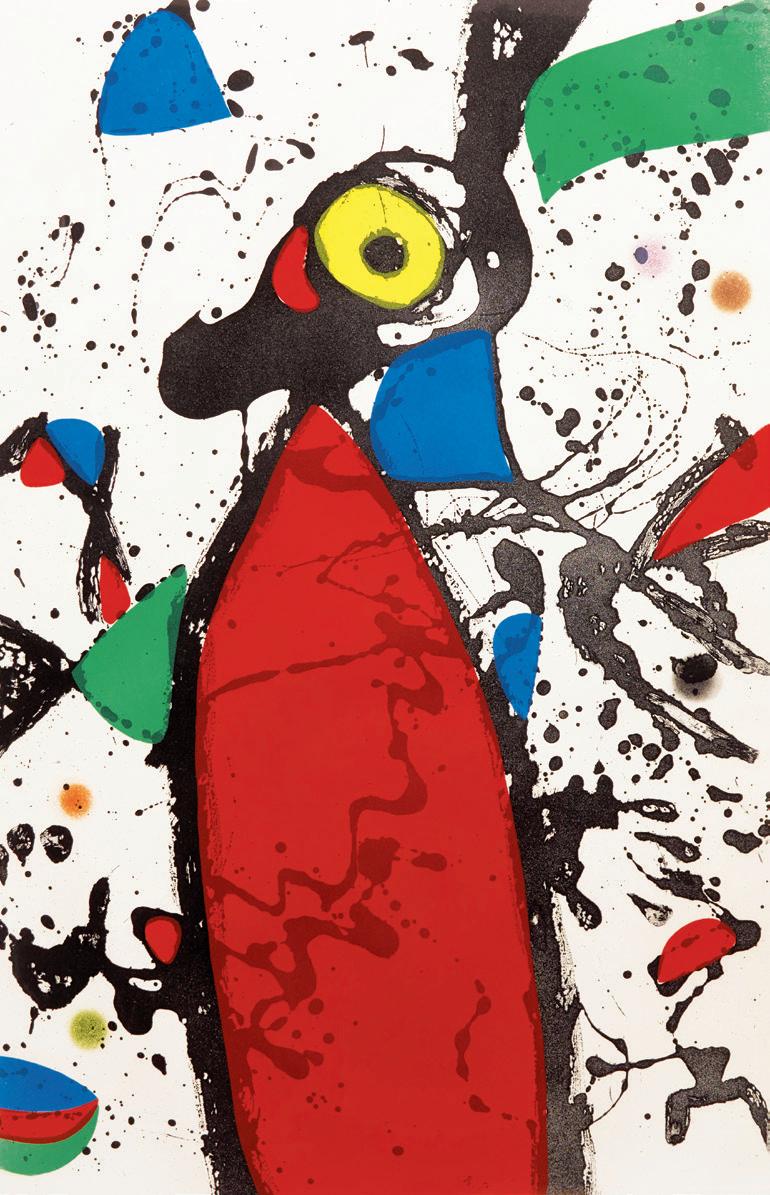
92
JOAN MIRÓ
Souris rouge à la mantille (Dupin 751) colour aquatint on Arches wove paper signed and numbered 7/50 in the lower margin; printed by Morsang and published by Maeght, Paris 44.5 ins x 29 ins; 113 cms x 73.7 cms
PROVENANCE
Sinai Health Foundation, Toronto
LITERATURE
Roland Penrose, Miró, London, 1985, pages 116–117 Jacques Dupin, Miró Engraver: III. 1973-1975, Paris, 1992, catalogue no. 751
Along with Salvador Dalí and Pablo Picasso, the Catalan painter Joan Miró is celebrated as one of the foremost Spanish modern artists after gaining prominence for depicting his imaginary world full of strange gures and biomorphic forms that appear to oat in space. As Miró described to a journalist in 1931: “I’m only interested in anonymous art, the kind that springs from the collective unconscious.” In this vibrant work, the main subject is a mouse shown in pro le, with its piercing yellow gaze capturing the viewer’s attention. Despite its protruding snout and large ears lling up the upper register, the body of the mouse ultimately dominates the composition in a ery shade of red. Miró’s characteristic biomorphic forms, shown here in blue, green and red tones, are dispersed randomly. His painterly black splatters scatter in di erent densities and directions, further animating the surface of the background and drawing the viewer’s eye to follow its meandering course.
$15,000–$20,000

93
MARC CHAGALL
Le Cirque (M. 527)
colour lithograph on Arches wove paper signed and numbered 18/24 in the lower margin 20.25 ins x 14.75 ins; 51.4 cms x 37.5 cms
PROVENANCE
Martin Lawrence Galleries, San Francisco Private Collection, Montreal
LITERATURE
Fernand Mourlot, e Lithographs of Chagall: 1962-1968, volume III, Monte Carlo, 1969, catalogue no. M. 527, pages 12 and 130
Re ecting Marc Chagall’s bold palette and joyous subject matter, this lithograph is taken from his Circus series commissioned by the French art dealer Ambroise Vollard. Two great themes run throughout his entire oeuvre: the circus and the Bible. e French artist described his ability to turn easily from one to the other: “I have always thought of clowns, acrobats and actors as tragically human beings who, to me, seem closely linked with the characters of some religious pictures.”
A colourful clown playing the horn dominates the composition. Overlapping swirls of colour and various patches of pattern decorate his costume, creating a vibrant visual e ect that draws the viewer’s eye. A towering female gure at left and performing acrobats in the distance at right are simply outlined in shades of orange and purple, covering the pared-down background. As a circus admirer, Chagall’s childlike pleasure at watching the performers is undeniable: “ ese clowns, these riders and these acrobats dwell in my visions. Why am I so moved by their make-up and their grimaces? In their company I draw near to other horizons. All the colour and the make-up lead me on towards other psychic variations which I long to paint.”
$20,000–$30,000
COWLEY ABBOTT | Live Auction - Spring 2024 91
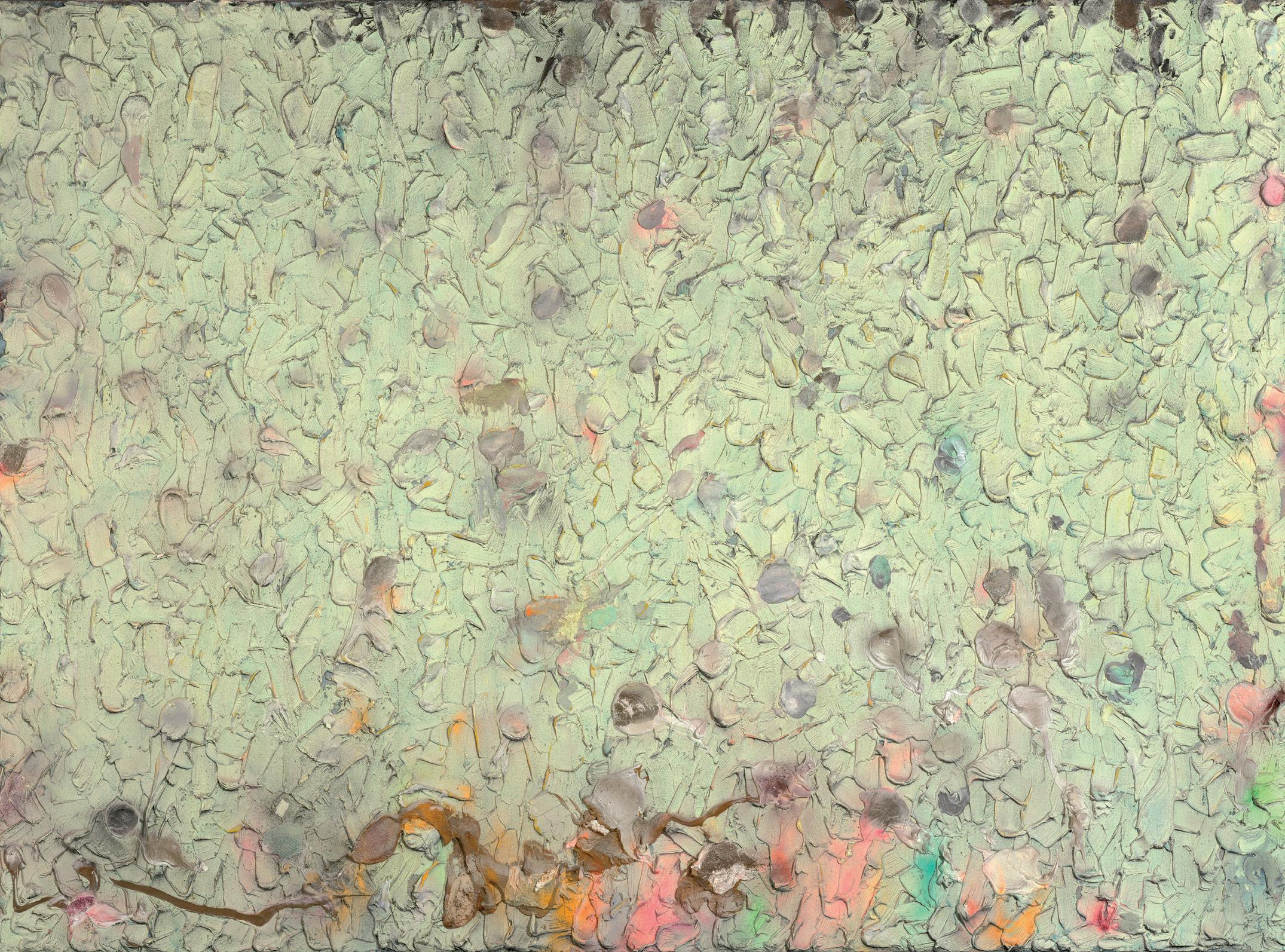
STANLEY BOXER
Acrid Sweet Glance Why oil on linen
signed, dated 6/1983 and inscribed "D5-83" on the reverse; titled and dated on the stretcher 46 ins x 62 ins; 116.8 cms x 157.5 cms
PROVENANCE
Private Collection, Toronto
LITERATURE
Stanley Boxer, 70th Birthday Exhibition , Salander-O’Reilly Galleries, 1 May-1 June 1996, pages 5 and 6
Lawrence B. Salander, the former New York City art dealer, describes Stanley Boxer’s art practice as a “method of operations” and understanding this “is essential if one is to fully understand his work because the method, the course of his ve-decade research, is as much a part of Boxer’s dynamic as the laying on of paint, the drawing of the line, or the carving in stone or wood.”
Furthermore, according to Salander: “For years Boxer’s method demanded working a week, precisely seven days, in a given medium— let’s say painting—which he would in turn pursue for exactly seven days, at which point he would stop painting and begin to draw.”
Acrid Sweet Glance Why, dating to 1983, exempli es the artist’s most mature style. During this later period, his abstract compositions primarily consisted of thickly applied layers of paint in an all-over obsessive manner, dusted with shimmery highlights of pearlescent pigment. Here a richly textured work in soft pastel tones emerges from the canvas. Ultimately the American artist focused on the materiality of his medium while drawing inspiration from the natural environment for his subject matter. He then selected bright colours to acknowledge the presence of nature in his work.
Boxer’s works feature in various private and public collections in North America and abroad, including the Art Gallery of Alberta, the Metropolitan Museum of Art, the Museum of Fine Arts, Boston, the Tate Gallery and the National Gallery of Australia.
$10,000–$15,000
COWLEY ABBOTT | Live Auction - Spring 2024 92
94
Finger from the Ex-Votos Series handcarved wood this work is from an edition of unknown size of unique variants; included with the lot is the exhibition catalogue as well as a certi cate of authenticity as issued 10.25 ins x 4.25 ins x 2.25 ins; 26 cms x 10.8 cms x 5.7 cms
PROVENANCE
Private Collection, New York
EXHIBITED
Ai Weiwei: RAIZ , OCA Museum, Ibirapuera Park, São Paulo, 20 October 2018-20 January 2019
LITERATURE
Rhea Nayyar, “Take Ai Weiwei’s Finger Anywhere in the World,” Hyperallergic, 16 March 2023 [online publication]
For the Chinese artist and activist Ai Weiwei, raising the middle nger is an act of de ance. is gesture has appeared in many of his series, including one of his most famous works, Study of Perspective, produced between 1995 and 2017, in which he describes his use of a nger:
“We often forget that we have a middle nger… Or even if we know we have a middle nger, we misuse it. I think it’s good to remember that this part of your body can point to something—an institution, or someone that resembles a power—to let them know, and let yourself know, that you exist.”
From the Ex-Votos series, completed in 2018, the sculpture was handcrafted in Juazeiro do Norte in Brazil by local artisans using traditional techniques based on the artist’s design.
$9,000–$12,000

COWLEY ABBOTT | Live Auction - Spring 2024 93 95
AI WEIWEI
SAYED HAIDER RAZA
L'église du village oil on canvas
signed and dated 1958 upper right; inscribed "182" twice on the stretcher; titled on a gallery label on the frame on the reverse 21.5 ins x 18 ins; 54.6 cms x 45.7 cms
PROVENANCE
Monique de Groote Galerie d'art, Montreal
Galerie Dresdnere, Montreal (inventory no. 182, acquired in May 1958)
Private Collection, Montreal (acquired 16 May 1958)
Private Collection, Toronto
Private Collection, Toronto
LITERATURE
Jacques Lassaigne, RAZA, Paris, 18 April-15 May 1958
L'église du village was painted during a period of time for Raza when he was growing in con dence and demonstrating a mastery in his own unique artistic style. While the teachings of the École de Paris had given him a valuable command of colour and construction, what he termed le sens plastique, the late 1950s saw Raza striking o on his own path. With a burgeoning passionate stylistic direction and a new found nancial security, Raza isolated himself in his lodgings and concentrated on a new body of work. Indeed, 1958 can be seen as perhaps one his most proli c years of painting in Paris. e current work was acquired by the Monique de Groote Galerie d'art, in Montreal of which Simon Dresdnere was the director. Simon Dresdnere would go on to establish Galerie Dresdnere where Raza would enjoy a solo exhibition at the premises in 1959. It was here that Raza would encounter the academic Karl Kasten who would invite him to spend time in the U.S in 1962, a moment that had a profound impact on his artistic sensibilities.
In the current work, the rural landscape seems heavy with the prospect of nightfall or of an impending storm. Indeed, Raza’s fascination with the duality of darkness and light was to be an integral theme throughout his creative journey. Commenting on Raza’s works from this period, Jacques Lassaigne, art critic and director of the Museum of Modern Art in Paris, writes:
"Pure forms take shape no longer in the void, but in revelatory contrast with their surroundings, in light that exults, doubly bright, against the opacity that threatens it. e composition is made to expand or contract, as it retreats in orderly array along a broad avenue or succumbs to the brief ordeal of a stormy disintegration. Walls of houses are no longer smooth planes; they are broad beaches strewn with the hulks of burnt-out energies. Behind a foreground of glowing embers or darkling plains looms a mass of lustrous houses. For all the tragic intensity of its smouldering res, and the glare of its greenery, the world of Raza hangs in a torrent of potentialities, amid the contending powers of darkness and light. Notwithstanding the storms of life, the artist, true to himself, has acquired the gift of serenity; he has achieved the inexpressible plenitude which, in the Arabian poem, is born of the reiterated syllable signifying Night.”
L'église du village holds a sense of tension, the sky and terrain rendered in the same dark and muddy blues, the buildings seeming to oat precariously between the two. e foreground is desolate apart from a few jagged rocks and the punctuation of a single tree of spiky black leaves. Illumination is provided by the white of the house fronts and ickers of iridescent orange on some of their brickwork. Raza’s choice of colours in this canvas are a rich combination of both his native and adopted countries. e tones of the Indian miniatures of his homeland are particularly evident in the ash of vibrant red on the right-hand side of the painting, a bright re amongst the shadows. Raza was also beginning to explore texture and the shapes of his landscape are rendered in thick impasto oil with the imprint of the palette knife clearly visible. is painting, like others of the period, are hard to link to a particular town or region and the recognizable elements of his work would dissolve further as the years progressed. Nature, in this dramatic painting, lies rmly on Raza’s trajectory of something to be experienced, something to be felt.
We extend our thanks to Anne Macklin from e Raza Foundation in New Delhi for her assistance in researching this artwork and contributing the preceding essay.
is work will be included in a revised edition of S.H. Raza, Catalogue Raisonné, Volume 1 (1958-1971) by Anne Macklin on behalf of e Raza Foundation, New Delhi (SR4526).
$150,000–$200,000
COWLEY ABBOTT | Live Auction - Spring 2024 94 96
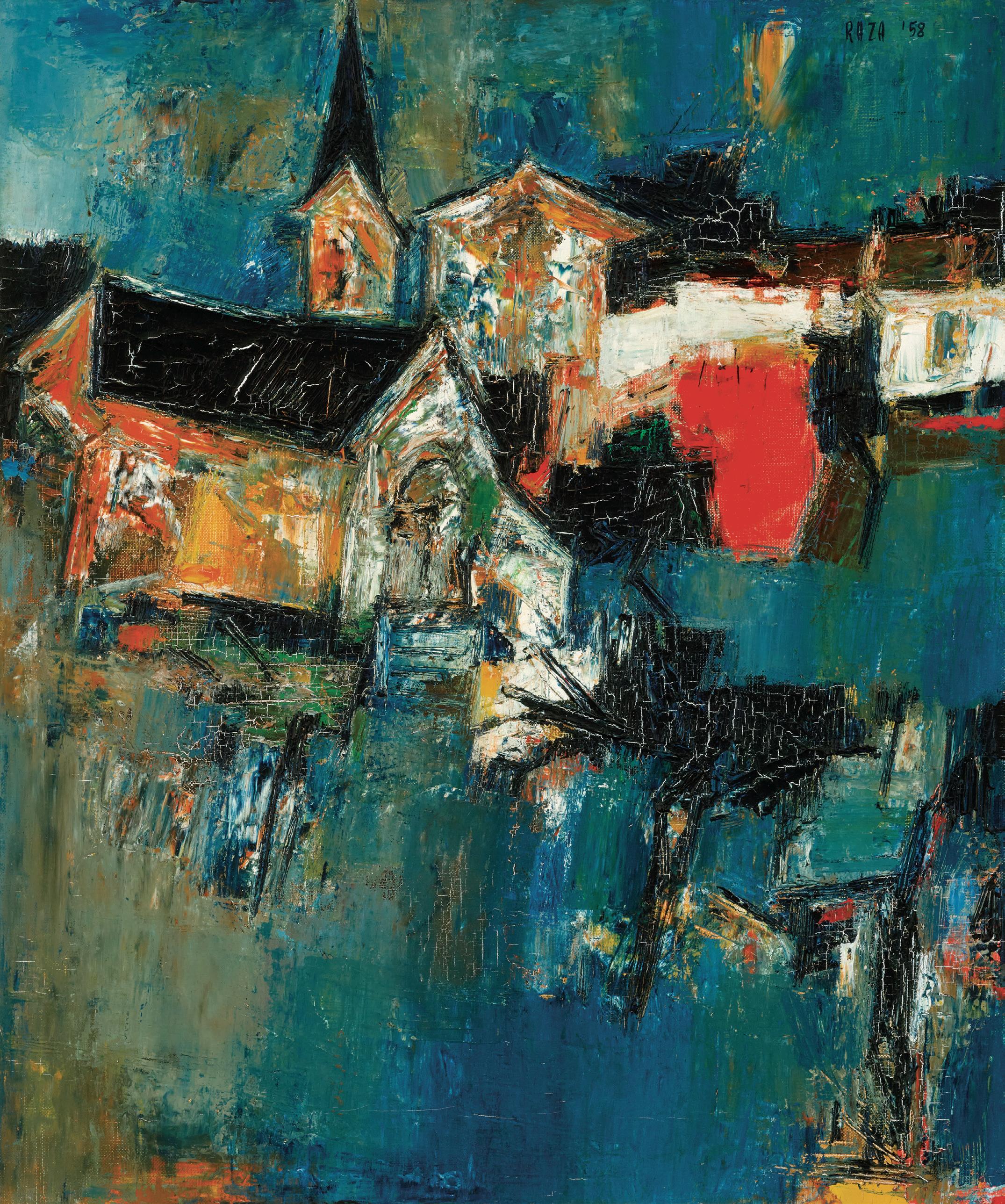
COWLEY ABBOTT | Live Auction - Spring 2024 95
SAYED HAIDER RAZA
Temple Protestant
oil on canvas
signed and dated 1957 upper right; titled "Temple protestant" on the stretcher; inscribed RAZA "Temple Protestant / P185 - 58 / 25F" on a label on the stretcher; further titled "Protestant Church" on a gallery label on the frame on the reverse 25.5 ins x 31.75 ins; 64.8 cms x 80.6 cms
PROVENANCE
Galerie Lara Vincy, Paris (inventory no. P185)
Galerie Dresdnere, Montreal (inventory no. 331, acquired 18 November 1958)
Private Collection, Montreal (acquired May 1959)
Private Collection, Toronto
Private Collection, Toronto
LITERATURE
Ashok Vajpeyi and Sayed Haider Raza, Passion: Life and Art of Raza , Rajkamal, New Delhi, 2005, page 57
In 1950, Raza moved to Paris from his homeland of India having obtained a bursary from the French Government to study at the École Nationale des Beaux-Arts. His initial years in the city were di cult as he lacked acquaintances and struggled for money. However, after several years his fortunes began to change. In 1955 he signed a contract with Galerie Lara Vincy to exhibit with them exclusively until 1971 and the following year he was awarded the prestigious Prix de La Critique, the rst foreign artist to do so. By 1957, the year Temple Protestant was painted, Raza was able to live o his art alone and move into a loft space in the Latin Quarter of Paris, as he said “a new life started for me”. As Raza’s nances improved, he was able to move from gouache in tempera, to the more expensive medium of impasto in oil. He also began to travel more extensively through France and it was the villages and landscapes of his new country that became the main subjects of his paintings. As Raza explains:
“ e French landscape became a dominant theme of my work from 1954 to ’65. I went to Brittany where I painted French churches and villages. I went to the central part of France. I went right up to Carcassone and to the southern part called Provence; in the villages dating back to the middle ages the houses were beautiful.”
In combination with these changes, Raza’s works from the mid- to late-1950s also demonstrate a new shift in style and vision, particularly brought about by his exposure to the work of the Post-Impressionists and artists like Cézanne, whose paintings he saw in the museums and galleries of Paris. However, where Raza begins exploration into a new direction in his art, he does not abandon his previous style immediately. In the current work we still see traces of the clarity and order of his ‘classic’ period some years previously. e composition is carefully balanced, with the village and its imposing spired church set against a pale blue sky, each building encased with a bold black line. However, the elements of the painting are now no longer painted in at delicate tempera and strung along the horizon but densely packed together and rendered in thick rugged brushstrokes. Over the coming years, as Raza further explored the possibilities of his new medium and as his artistic sensibility matured, his paintings would become looser, more textured and more expressionistic. Temple Protestant stands at a point where to use Rudolf von Leyden’s words, “subject” is becoming increasingly more irrelevant, but “image” persists.
We extend our thanks to Anne Macklin from e Raza Foundation in New Delhi for her assistance in researching this artwork and contributing the preceding essay.
is work will be included in S.H. Raza, Catalogue Raisonné, Early Works (1940-1957) by Anne Macklin on behalf of e Raza Foundation, New Delhi (SR2712).
$250,000–$300,000
COWLEY ABBOTT | Live Auction - Spring 2024 96 97
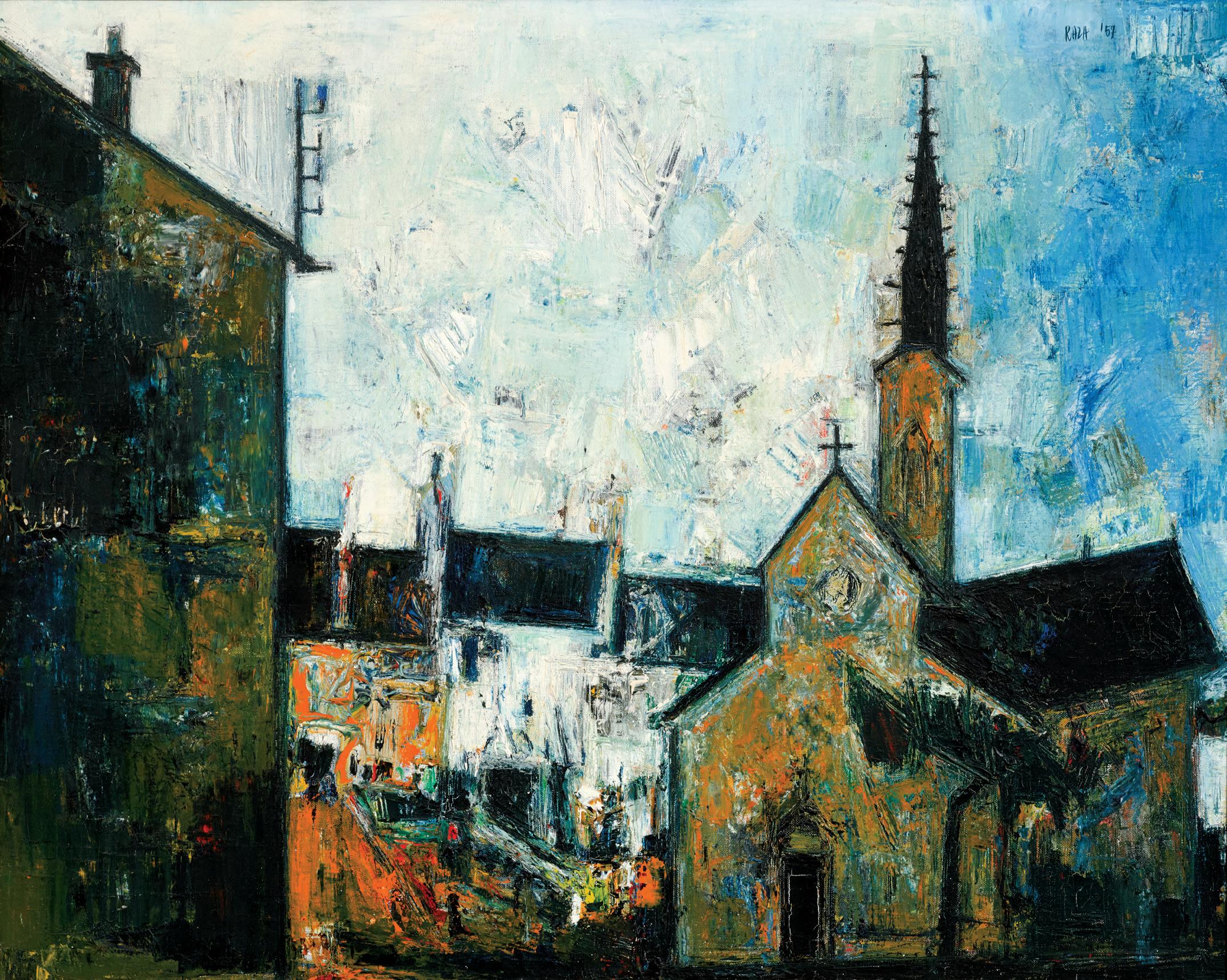
COWLEY ABBOTT | Live Auction - Spring 2024 97
NICHOLAS NIXON
The Brown Sisters from The Brown Sisters Series 43 gelatin silver prints
all signed, titled, variously dated and numbered from the editions of 50 and 60 respectively on the reverse and further titled, dated and numbered on a gallery label on the backing on the reverse 8 ins x 10 ins; 20.3 cms x 25.4 cms
PROVENANCE
Galerie omas Zander, Cologne Private Collection, Toronto
LITERATURE
John Szarkowski, Mirrors and Windows: American Photography Since 1960, New York, 1978
Peter Galassi, Nicholas Nixon: Pictures of People, New York, 1988
Sarah Greenough et al., On the Art of Fixing a Shadow: One Hundred and Fifty Years of Photography, Washington, D.C. and Chicago, 1989, no. 340
Robert Adams, Beauty in Photography, New York, 1996, no. 9
Keith F. Davis, An American Century of Photography, from Dry-Plate to Digital, Kansas City, 1999, no. 436
Nicholas Nixon, e Brown Sisters, New York, 1999, 2002, 2008 and 2014, unpaginated
Suzanne Lange, Degrees of Stillness: Photographs from the Manfred Heiting Collection , Hamburg, 2001
Emma Dexter and omas Weski, Cruel and Tender: e Real in the Twentieth-Century Photograph, London, 2003
Katherine A. Bussard, So e Story Goes, Chicago, 2006
Sarah Hermanson Meister, Nicholas Nixon: Forty Years, New York, 2014
Philip Gefter, Sandra S. Phillips, Ulrike Schneider, About Face, San Francisco, 2014, page 112
Kim Beil, e Grain of the Present, San Francisco, 2017, pages 39, 242–51
In July of 1975 Nicholas Nixon was visiting his wife’s family when he decided to take his rst photograph of his wife, Bebe (née Brown), and her three sisters, Heather, Mimi and Laurie. e resulting black-andwhite photograph is striking: four young women, dressed casually, look directly at the camera while standing pale and luminous against a backdrop of trees and lawn.
Nixon photographed the Brown sisters each year, creating one of photography’s most poignant bodies of work. Each portrait is made with an eight-by-ten-inch view camera on a tripod and is captured on a black-and-white- lm negative. When Nixon’s rst solo exhibition opened in 1976 at the Museum of Modern Art, the rst two photographs were included in a show that focused primarily on exploring the built and natural environment. Despite sharply contrasting in terms of subject matter and vantage points, the promise of the series was undeniable.
A story of sisterhood emerges throughout the portraits, with a hand grasping a sister’s waist, an arm slung casually over a shoulder and their arms interlinked in an embrace. e series has two constants: the sisters always appear in the same order and jointly select an image representing a given year. e captions are short—marking the year and the location—and thus preserving their anonymity. Despite being the photographer hiding behind the lens and involved in the family as husband and brother-in-law, Nixon is nearly invisible across the entire series. He only appears in shadow within the seaside portrait of 1984 and the colder scene from 1996, where the sisters are shown wearing wool sweaters and a jacket.
While Nixon printed the negatives strictly as contact prints for a quarter of a century—thus retaining their size, level of detail and tone—he eventually came to appreciate the value of making larger prints of the series by producing twenty-by-twenty-four-inch enlargements. e resulting di erence is, arguably, largely experiential: “the larger prints may sacri ce the intimacy of the smaller scale, but one can appreciate them from a distance that stands in for a distance in time, the remove of the viewer’s suggesting the sisters’ own remove from their younger selves.”
e series was exhibited at the Museum of Modern Art in 2014 and Sarah Hermanson Meister writes: “We grow older along with these women, yet we are confronted with four lives we will never know through the eyes of a fth. And in the space created through that ignorance, we nd the potential for understanding the series as a work of art”. roughout this intimate series, we notice the passage of time as we observe these women age. eir physical appearance evolves and they lose some of their initial candour. Yet, aging does not de ne them. eir portraits ultimately are a celebration of life and the enduring power of family ties.
e photographs featured in the present lot were printed in various years: 1995, 2000, 2002, 2005–2012 and 2014–2017.
$250,000–$350,000
COWLEY ABBOTT | Live Auction - Spring 2024 98 98






COWLEY ABBOTT | Live Auction - Spring 2024 99
A selection reproduced here.
e provisions of these Terms and Conditions of Sale shall govern any proposed or actual transaction between Cowley Abbott (aka Consignor Auctions Limited) (“CAL”) and the prospective buyer/ bidder (“Bidder”). CAL is acting as agent for the person who has consigned the property to CAL for sale, whether as principal, owner or agent (“Consignor”).
1. e descriptions of items o ered by CAL (“Property”), including artist, title, medium, size, date of execution, provenance, exhibition history, inclusion/reproduction within literature sources, attribution and genuineness, are subject to change leading to the nal sale of said Property (including the process during which bidding is active for the Property during CAL online auctions). Descriptions of Property provided by CAL are not meant to stand as a representation to Bidders and no guarantee or warranty of complete accuracy of the provided descriptions is intended or should be assumed. Bidders are provided the opportunity to view and inspect all Property o ered for sale by CAL through public and/or pre‒arranged private viewings prior to a sale’s completion. No sale shall be rescinded due to a lack of correspondence between the provided description of the Property by CAL and the Property itself, including the illustration of the Property provided by CAL. It is the sole responsibility of a Bidder to make arrangements for the inspection of the Property of interest (by the Bidder itself and/ or by the Bidder’s advisers) prior to sale, and to bid in accordance to this actual inspection and/or reliance upon their advisers’ guidance.
2. e Bidder who has successfully bid on Property (the “Successful Bidder”) con rms that any claims relating thereto shall be claims against Consignor, without recourse to CAL. CAL represents the Consignor exclusively and makes no representation or warranty, express or implied, regarding legal title or ownership of the Property o ered by CAL and has relied upon the Consignor con rming same to CAL, without further independent investigation. e Bidder shall be solely responsible for satisfying itself of the legal title or ownership of the Property and liens or encumbrances a ecting same and the capacity of the Consignor to sell the Property o ered.
However, notwithstanding the stipulations listed above, the Successful Bidder may make arrangements for a recognized and fully‒quali ed authority, who is accepted by CAL, to inspect the Property prior to collection by the Successful Bidder from CAL’s premises. Should this authority submit in writing to CAL a statement regarding the challenge of genuineness and/ or authenticity of the lot in question, the sale can be rescinded by CAL and a full refund will be provided to the Successful Bidder. e above process must take place within seven days of the nal sale of the Property.
3. CAL is pleased to o er a service of providing condition reports on the lots which are o ered through its auctions. Please note that these reports are matters of opinion and are prepared by CAL specialists and are not a substitute for a physical inspection of the artwork by the Bidder or their advisors. CAL specialists are not trained restorers and the provided condition reports are not meant to equal a comprehensive report created by a professional restorer. e reports provided by CAL are meant to provide assistance to the Bidder through observations of the artwork and the report will not disclose any imperfections which might be revealed through the process of subsequent restoration. In all cases, the Bidder is advised to consult their own conservator for a complete report with regard to condition (CAL is happy to provide access to the artwork by conservators through public previews and private pre‒arranged appointments). Bidders should be aware that CAL’s warranties with regard to the Property o ered through their auctions are limited to the terms listed in the Terms and Conditions of Sale and in no case extend to the condition of the artwork.
4. A buyer’s premium of 20% of the successful bid price is to be paid by the Successful Bidder to CAL as part of the purchase price (a buyer’s premium of 21% of the successful bid price is to be paid by the Successful Bidder to CAL as part of the purchase price where the Auction Mobility technology is used to bid successfully during a live/catalogue auction). In addition, 13% HST (Harmonized Sales Tax) is applied to the successful bid (hammer) price and buyer’s premium. However, HST will not be charged on purchased Property which is shipped outside of Canada. Where purchased Property is shipped outside of the Province of Ontario but within Canada, the applicable HST or GST will be charged based on the tax applications within the province or territory of destination. In both cases, the Property must be collected from the o ces of CAL with a waybill provided indicating the destination. It is the sole responsibility of the Purchaser to provide acceptable details and make the necessary arrangements to meet the requirements for altered tax responsibilities based on the destination of the shipped Property. Alterations of invoices and/ or crediting of tax payments will not be completed once CAL has released the Property.
5. e Bidder acknowledges that CAL may collect a commission and associated fees through its agreement with the Consignor of a lot included in a CAL auction.
6. Purchases completed through CAL auctions are not represented to necessarily include copyright allowances to the Successful Bidder for the purchased Property.
7. CAL reserves the right to withdraw any Property from sale for any reason whatsoever and without liability. is withdrawal may occur up to the close of bidding for the Property. CAL also reserves the right to divide lots of Property into smaller lots or to combine individual lots of Property into larger lots. e above can be carried out at the sole discretion of CAL and can occur without notice.
8. Each Bidder must register with CAL, agreeing to the Terms and Conditions of Sale. Registered Bidders represent that they are bidding on their own behalf and are responsible for those lots in which they are the successful high bidder (becoming the Purchaser or Successful Bidder). In the event that a registered Bidder is representing another party, CAL must be contacted regarding this arrangement at least twenty‒four hours prior to the opening of bidding for a particular auction and CAL reserves the right to refuse this arrangement for any reason whatsoever. Failure to abide by this provision shall entitle CAL to deem the Bidder as bidding on its own behalf. Splitting of and/or transferring of an invoice to an individual and/or organization other than the registered Bidder can only be completed at the discretion of CAL and must meet the requirements of such an amendment, including written authorization from both the registered Bidder and its bene cial buyer and the individual or representative of the individual who will become the new invoiced client in such an arrangement.
9. CAL reserves the right to refuse any bid and/or bidd ing registration application at their absolute discretion. Further, CAL also reserves the right to suspend or cancel any account used for bidding at their sole and absolute discretion. CAL also reserves the right to refuse any bid which is not in relation to the provided pre‒sale auction estimate provided by CAL and also reserves the right to not accept a bid recognized to not fall within the set bidding increments during sale. Additionally, CAL reserves the right to accept any bid which does not meet any pre‒established reserve. In no instance may a Bidder withdraw or alter their submitted bid.
10. CAL reserves the right to accept and execute absentee or telephone bids on behalf of prospective purchasers, unable to directly participate in the particular auction. In such a case, CAL provides the service of absentee or telephone bidding as a privilege and shall not be responsible for failure to execute the absentee bid(s)
COWLEY ABBOTT | Live Auction - Spring 2024 100
Sale
Terms & Conditions of
for any reason whatsoever and shall also not be responsible for errors and/or omissions related to the process. Bidders who wish to employ CAL in the process of absentee or telephone bidding must complete and sign the required documentation (absentee/ telephone bidding form) prior to the start of bidding for the particular auction. In the event that two identical absentee bids are submitted to CAL, the bid which is received earlier (and which has been submitted through a completed and signed absentee bidding form) will take precedence over the later bid(s), allowing the earlier submitted bid(s) to potentially purchase the lot(s) at bid level submitted.
CAL reserves the right to request and charge a deposit to a Bidder submitting an absentee or telephone bid, in relation to the value of the artwork, to a maximum of $10,000 CAD. CAL reserves the right to hold and apply this Deposit to the invoice, should the Bidder become the Successful Bidder. In the event that nal payment and invoice settlement is not made within 30 days following the completion of the live auction, then CAL shall have the right to rescind the purchase and the Deposit shall be retained by CAL as liquidated damages. In the event that the Bidder is not successful, the Deposit will be refunded within 10 business days following the completion of the auction.
11. CAL is pleased to provide the opportunity for bidders to participate through online bidding during live auctions via Auction Mobility, a third‒party provider of these services. Please be aware that CAL is not responsible for errors or issues associated with this service which may have an adverse e ect on the Client’s ability to bid. A buyer’s premium of 21% of the successful bid price is to be paid by the Successful Bidder to CAL as part of the purchase price where the Auction Mobility technology is used to bid successfully during a live/catalogue auction.
12. At the completion of the sale, the Successful Bidder shall be recognized as the Purchaser and shall then take on complete responsibility and risk for the purchased Property, adhering to all of the Terms and Conditions of Sale. In the event of a dispute between the Successful Bidder and any other Bidder regarding the result of the auction, CAL will have absolute discretion to rescind any transaction with the Successful Bidder and designate a new winning buyer or to withdraw the Property from the auction. In such a case, CAL may choose to re‒o er the Property in a future auction or private sale. In all such cases, nal decision shall be made solely by CAL.
13. e Successful Bidder shall make arrangements with CAL for the payment of the whole invoiced amount following the immediate close of the auction, unless alternate arrangements are agreed by CAL for payment of a portion of the invoiced amount. Until full and nal settlement of the invoice is completed by the Successful Bidder, the purchased Property will not be released to the Successful Bidder. Failure to pay for purchases may lead to the cancellation of the sale with no promise of re‒o ering in a future auction. In the event of failure of payment by the Successful Bidder, CAL reserves the right to suspend and/or delete the bidding account of the Bidder and/or their representatives, all at the sole discretion of CAL. e artwork must be collected by the Successful Bidder or his/her representative or delivered to the shipping destination within 14 days of the invoice date.
14. Immediately following the completion of a CAL online auction, the Successful Bidder shall be charged 10% up to a maximum of $10,000 of the hammer price (the “Deposit”), which amount will be held as a deposit against payment for the Property purchased. e Successful Bidder hereby authorizes CAL to charge the Successful Bidder’s registered credit card with the Deposit. e Successful Bidder shall settle nal payment and collect their purchase(s) from CAL within ve business days following the completion of any CAL auction. Failure to settle payment and/ or collect the property from CAL within ve business days may lead to monthly interest charges of 1.5% in addition to the invoice
amount and/or storage charges for the Property being held on the premises of CAL. Property being held by CAL is being stored at the sole risk of the Successful Bidder and may be stored either on the premises of CAL or at a secondary storage location. In the event that nal payment is not made within 30 days following the completion of the auction, then CAL shall have the right to rescind the purchase and, if it is in an online CAL auction, the Deposit shall be retained by CAL as liquidated damages.
15. CAL, its employees or agents, shall not be liable for the loss or damage of any Property purchased through a CAL auction (through negligence or otherwise) while the Property remains in the possession of CAL and once the allowed ve business days following an auction closure or completion of a private sale has passed.
16. In any event resulting in failure by the Successful Bidder (Purchaser) to pay for Property purchased either through the de ned auction process or a private sale within the ve day period following the sale, CAL, in its sole discretion, may re‒o er the Property in question without limiting the terms in place with the Consignor of the Property. Should CAL reo er the Property, the original Successful Bidder (Purchaser) shall be responsible to CAL and the Consignor for the following: any di erence marked as a de ciency between the price achieved and amount invoiced upon the re‒sale of the Property versus the price achieved and amount invoiced to the Purchaser upon the original sale of the Property; any storage charges to CAL for the holding of the Property between its original o ering and the reo ering; and the total in sales commissions which CAL would have collected had the original sale of the Property been completed.
17. CAL accepts payment by cash, certi ed cheque, wire transfer, VISA, Mastercard and/or American Express (AMEX) for the settlement of invoices. Credit card purchases are limited to a maximum of $25,000 CAD and the credit card holder must be present at the time of payment. Artwork purchased with a certi ed cheque will not be released by CAL until the clearance of the cheque has been con rmed by CAL’s bank. Payments arranged by wire transfer may be subject to administrative charges related to the transfer and banking processes.
18. CAL is pleased to assist clients in arranging for the shipment of their artwork from our Toronto premises. However, it is the responsibility of the Successful Bidder to make these arrangements in full, including the packing, insuring and actual shipment of the Property. Assistance provided by CAL in this regard is provided as a service and CAL carries absolutely no liability through this courtesy. CAL carries absolutely no liability to possible damage of framing (including glass) during shipment arranged by CAL or otherwise.
19. Without limitation, the Purchaser accepts that any lot (Property) purchased through CAL may be subject to provisions of the Cultural Property Export and Import Act (Canada).
20. CAL reserves the right to refuse admission, enrolment and/ or participation in any of their events and/or auctions. Further, CAL reserves the right to refuse admission to their premises to any individual or group of individuals.
21. ese Terms and Conditions of Sale and all agreements related to the business of CAL shall be construed under the laws of Ontario and the parties hereby attorn to the exclusive jurisdiction of the Ontario Courts.
22. is agreement may be executed and delivered in a number of counterparts, each of which when executed and delivered is an original but all of which taken together constitute, as applicable, one and the same instrument.
COWLEY ABBOTT | Live Auction - Spring 2024 101
Thomson, Spring, Algonquin Park (Lot 19)
Lawren Harris, Untitled (Abstract Painting #173) (Lot 30)
Inside Front Cover
David Milne, Early Morning (detail) (Lot 23)
Inside Back Cover
Marcelle Ferron, Sans titre (detail) (Lot 26)
Artwork Features
Page 1: Emily Carr, Two Totems (detail) (Lot 5)
Page 2: Rita Letendre, Refet (detail) (Lot 42)
INDEX OF ARTISTS
Frederick Horsman (1881-1969)
Andrews, Sybil (1898-1992) 70 Banting, Frederick Grant (1891-1941) 6, 7, 34 Blackwood, David Lloyd (1941-2022) 72 Bloore, Ronald Langley (1925-2009) 67 Botero, Fernando (1932-2023) 83 Boxer, Stanley (1926-2000) 94 Bush, Jack Hamilton (1909-1977) 14, 43, 71 Carmichael, Franklin (1890-1945) 22, 63 Carr, Emily (1871‐1945) 5 Casson, Alfred Joseph (1898‒1992) 3, 4, 21, 32, 52, 62 Chagall, Marc (1887‒1985) 93 Chen, Li (b.1963) 85 Dallaire, Jean-Philippe (1916-1965) 29, 40 Dorland, Kim (b.1974) 73 Etrog, Sorel (1933-2014) 38 Fairey, Shepard (b.1970) 77 Ferron, Marcelle (1924-2001) 15, 26, 39 FitzGerald, Lionel LeMoine (1890-1956) 56 Flint, Sir William Russell (1880-1969) 89, 90, 91 Fortin, Marc-Aurèle (1888‒1970) 9, 54 Gervais, Lise (1933-1998) 45 Guosung, Liu (b.1932) 82 Harris, Lawren Stewart (1885‒1970) 16, 30, 44, 55 Heming, Arthur Henry Howard (1870‒1940) 64 Hockney, David (b.1937) 80 Holgate, Edwin Headley (1892‒1977) 53 Jackson, Alexander Young (1882‒1974) 8, 20, 35 Janvier, Alex Simeon (b.1935) 46 Kentridge, William (b.1955) 81, 88 Krieghof, Cornelius (1815-1872) 31 Kurelek, William (1927-1977) 10, 18, 47, 48, 75 Laurens, Henri (After) (1885-1954) 84 Letendre, Rita (1928‒2021) 12, 42 Lewis, Maud (1903-1970) 65, 66 Lismer, Arthur (1885-1969) 2, 33 Lyman, John Goodwin (1886-1967) 60 MacDonald, James Edward Hervey (1873-1932) 57, 61 Martin, Agnes (1914-2004) 79 Meredith, John (1933-2000) 68, 69 Milne, David Brown (1881‒1953) 23 Miró, Joan (1893-1983) 92 Moore, Henry (1898-1986) 86, 87 Morrice, James Wilson (1865-1924) 17, 24, 25 Morrisseau, Norval (1931-2007) 49 Muntz, Laura Adeline Lyall (1860-1930) 36 Nixon, Nicholas (b. 1947) 98 Perehudof, William (1919-2013) 74 Pilot, Robert Wakeham (1898-1967) 58 Pratt, Mary (1935-2018) 37 Raza, Sayed Haider (1922-2016) 96, 97 Reid, Bill Ronald (1920-1998) 50, 51 Riopelle, Jean Paul (1923‒2002) 11, 13, 27, 28, 41 Sheppard, Peter Clapham (1882-1965) 59 Thomson, Tom
19 Tobiasse, Theo (1927-2012) 78 Varley,
1 Warhol, Andy (1928-1987) 76 Weiwei, Ai (b.
95 Front Cover Tom
Back
(1877-1917)
1957)
Cover

